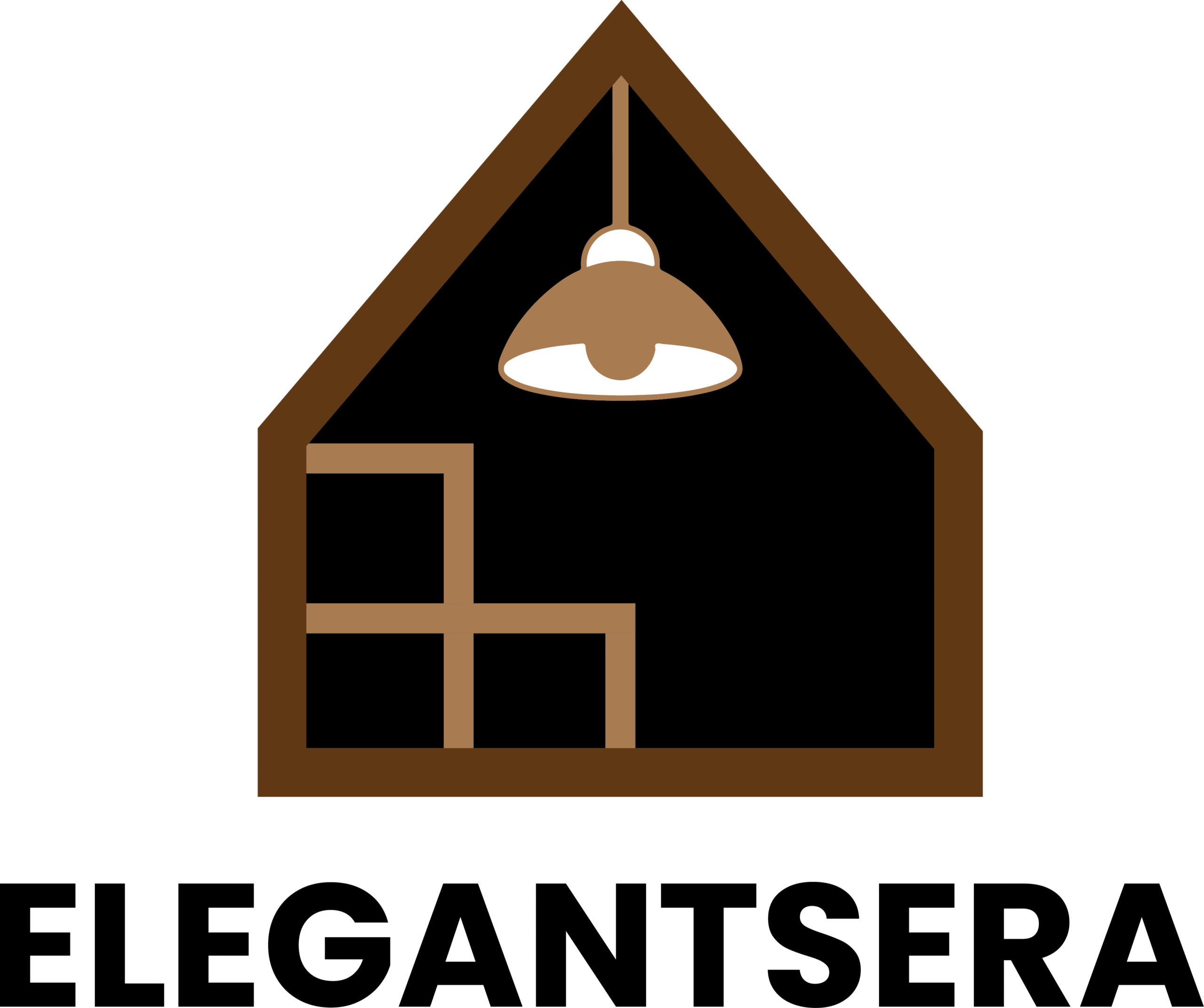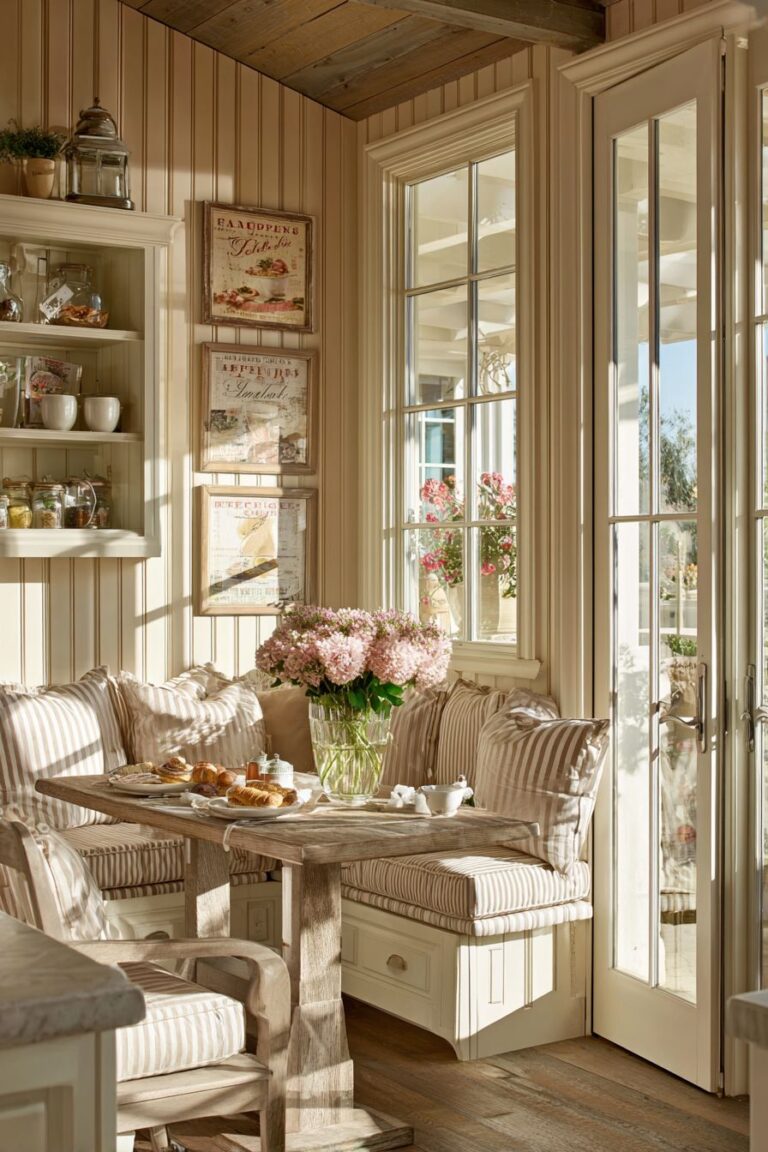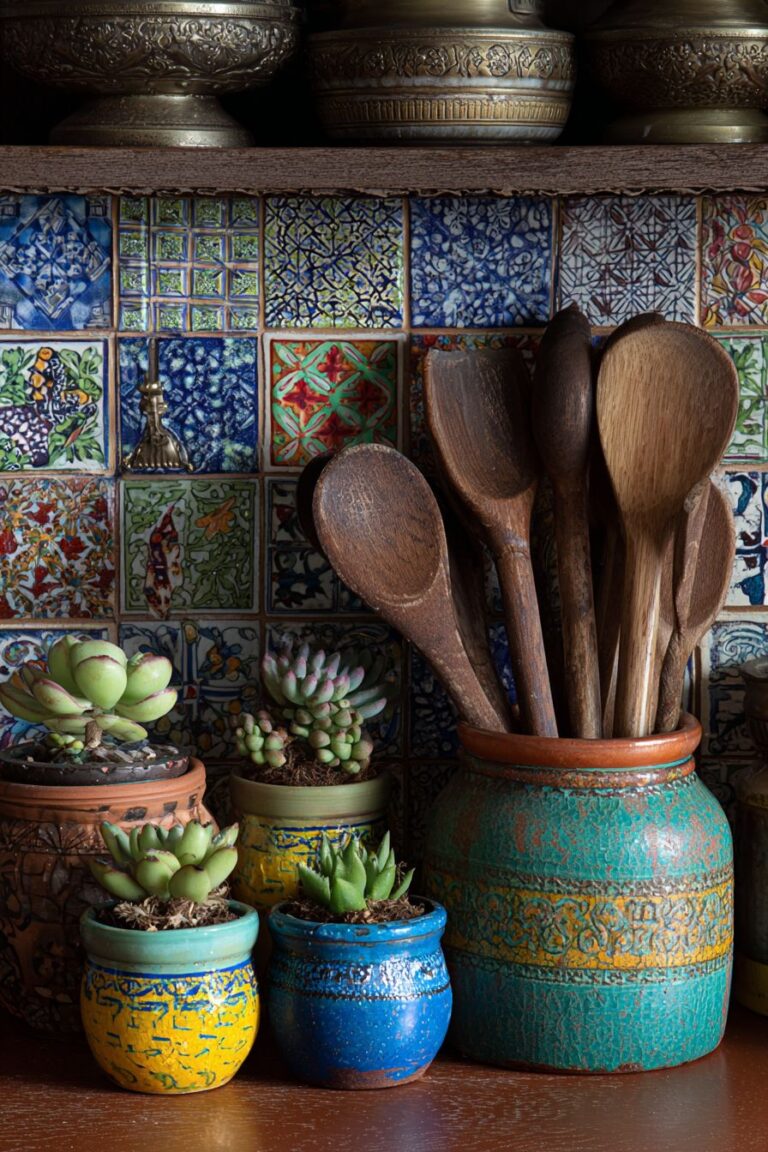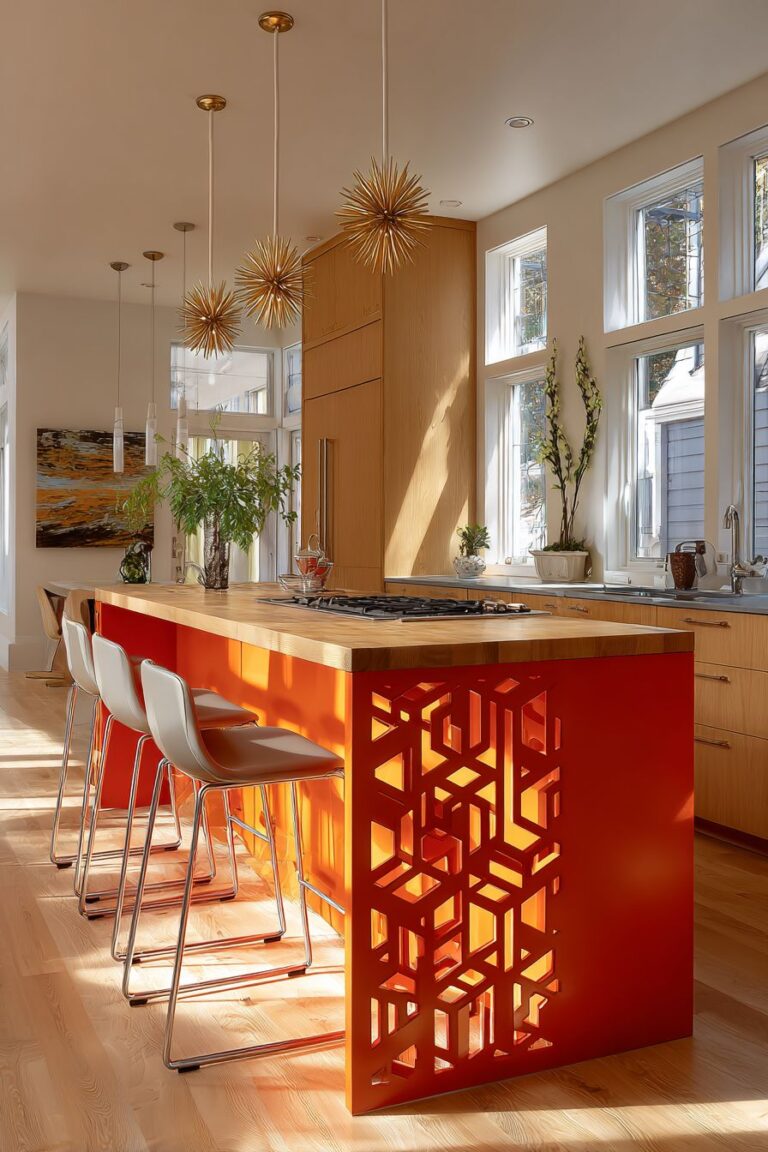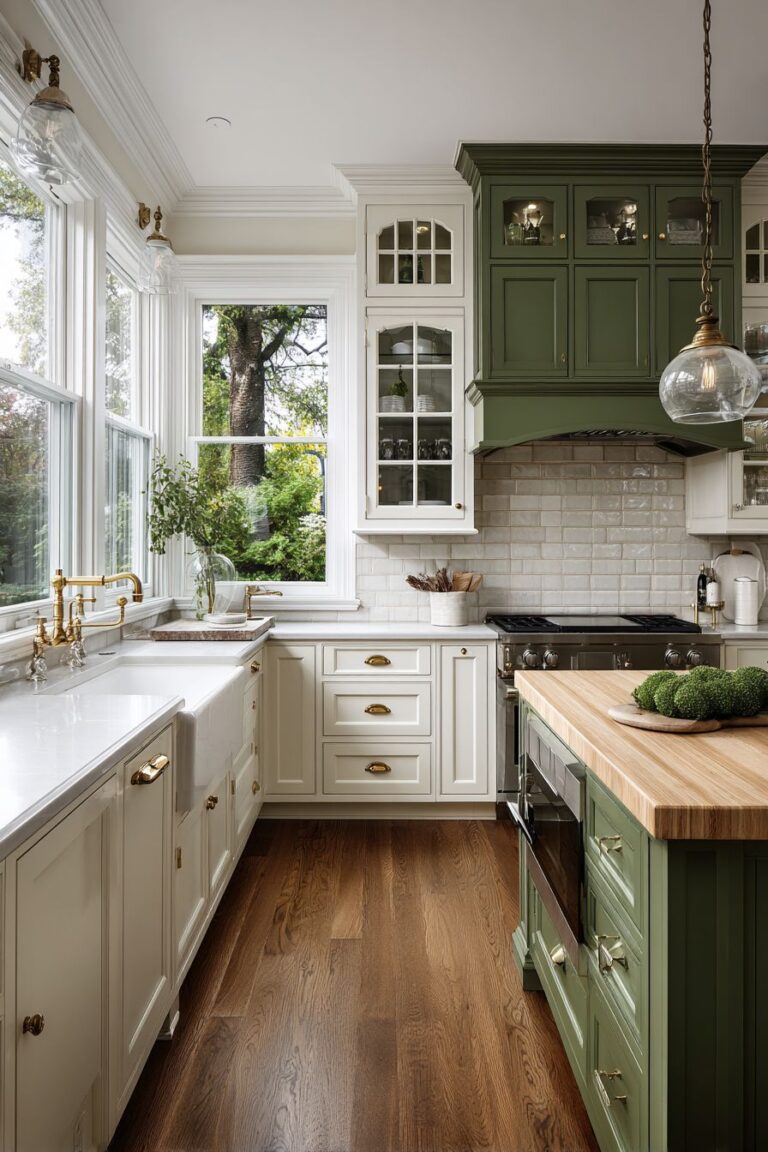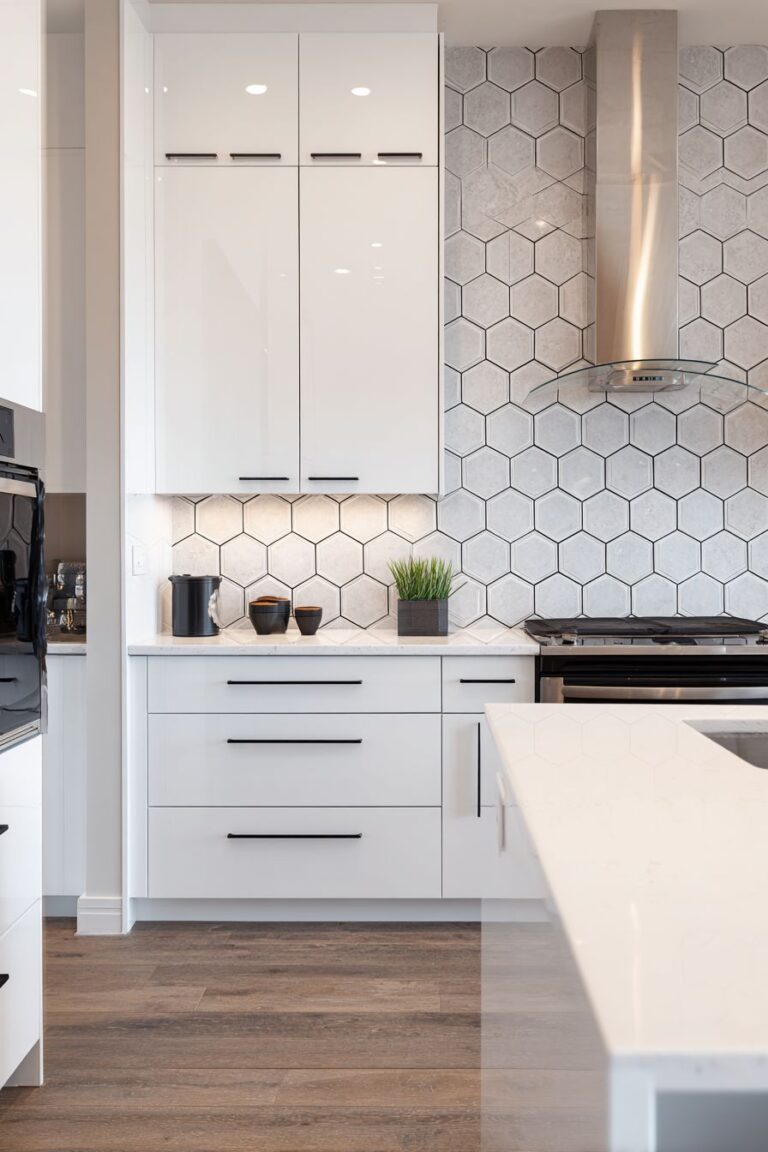20 Innovative Spice Rack Ideas For Every Style & Space
The heart of every great kitchen lies not just in its appliances or countertops, but in the thoughtful organization that makes culinary creativity flow effortlessly. Among all kitchen storage solutions, spice organization holds a special place – it’s where functionality meets artistry, where the practical necessity of accessibility merges with the visual poetry of organized ingredients. A well-designed spice rack doesn’t merely store your seasonings; it transforms them into a curated display that inspires cooking adventures and reflects your personal style.
The world of spice storage has evolved far beyond the simple carousel spinners of decades past. Today’s interior design landscape offers an extraordinary array of solutions that cater to every aesthetic preference, spatial constraint, and organizational philosophy. From sleek minimalist systems that disappear seamlessly into modern cabinetry to rustic displays that celebrate the natural beauty of herbs and spices, the options are as diverse as the flavors they contain. Whether you’re working with a compact apartment galley or a sprawling chef’s kitchen, the right spice storage solution can dramatically enhance both the functionality and visual appeal of your culinary space.
1. Modern Pull-Out Drawer System Excellence
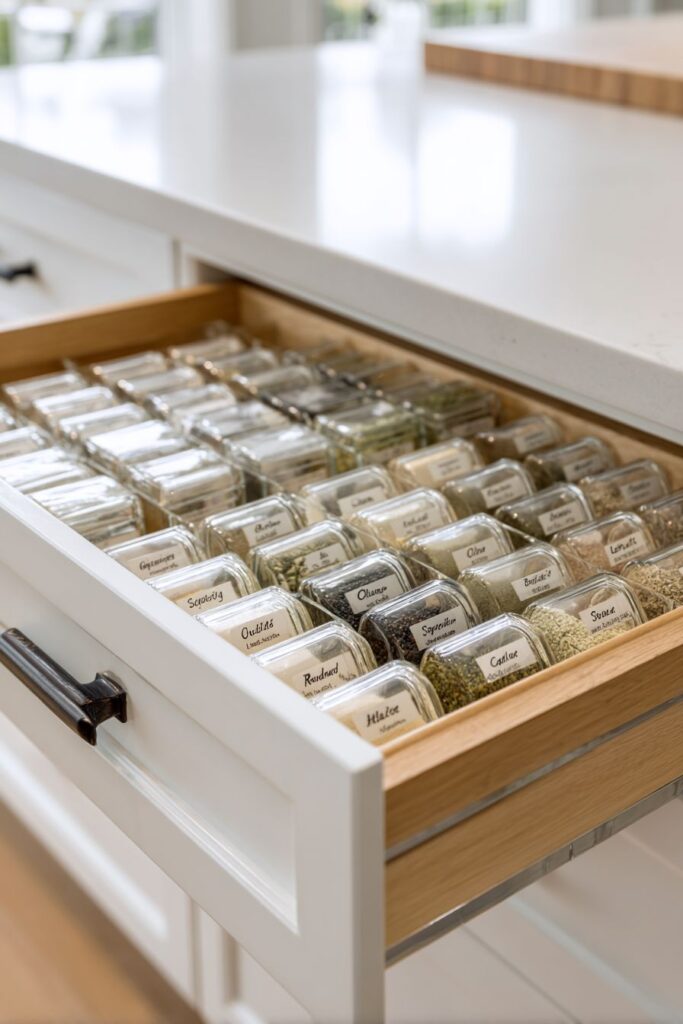
The epitome of contemporary kitchen organization manifests in sleek pull-out drawer systems that transform spice storage into an art form. These sophisticated solutions feature clear glass containers arranged in precise rows, each displaying elegant handwritten labels against crisp white backgrounds. The magic lies in the soft-close mechanisms that guide the drawer smoothly along its track, eliminating the jarring slam of traditional storage while providing instant access to your entire spice collection.
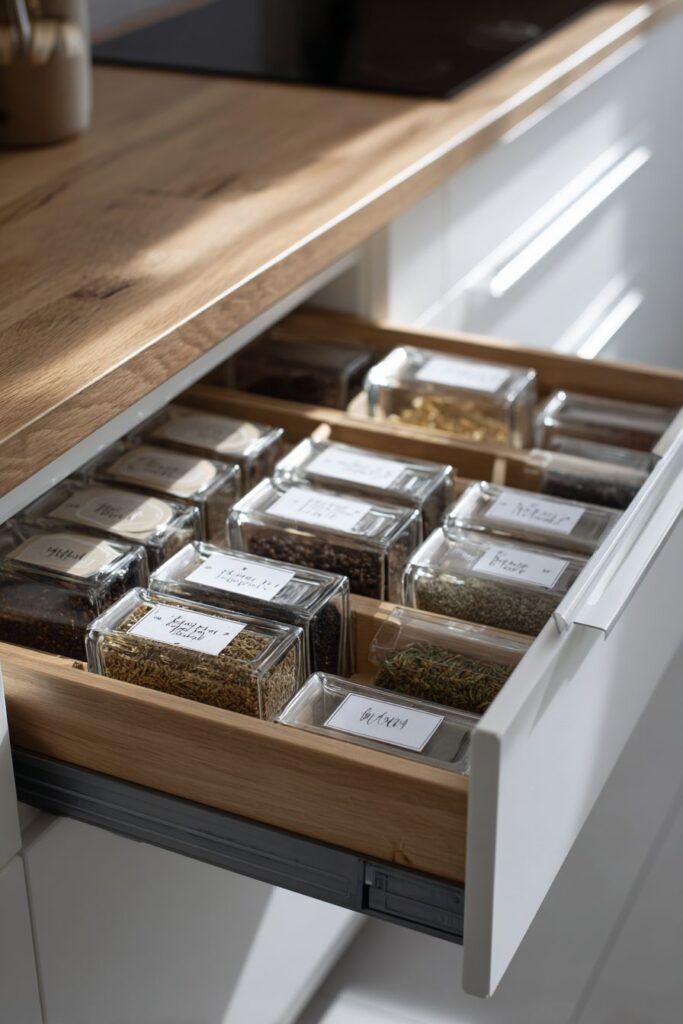
The integration with white shaker-style cabinetry creates a seamless flow that speaks to modern design sensibilities, while natural oak countertops introduce warmth that prevents the space from feeling clinical. The transparency of glass containers allows for immediate identification of contents while creating visual consistency throughout the storage system. Natural lighting filtering through nearby windows highlights the subtle variations in spice colors and textures, turning everyday ingredients into an appealing mosaic of culinary possibilities.
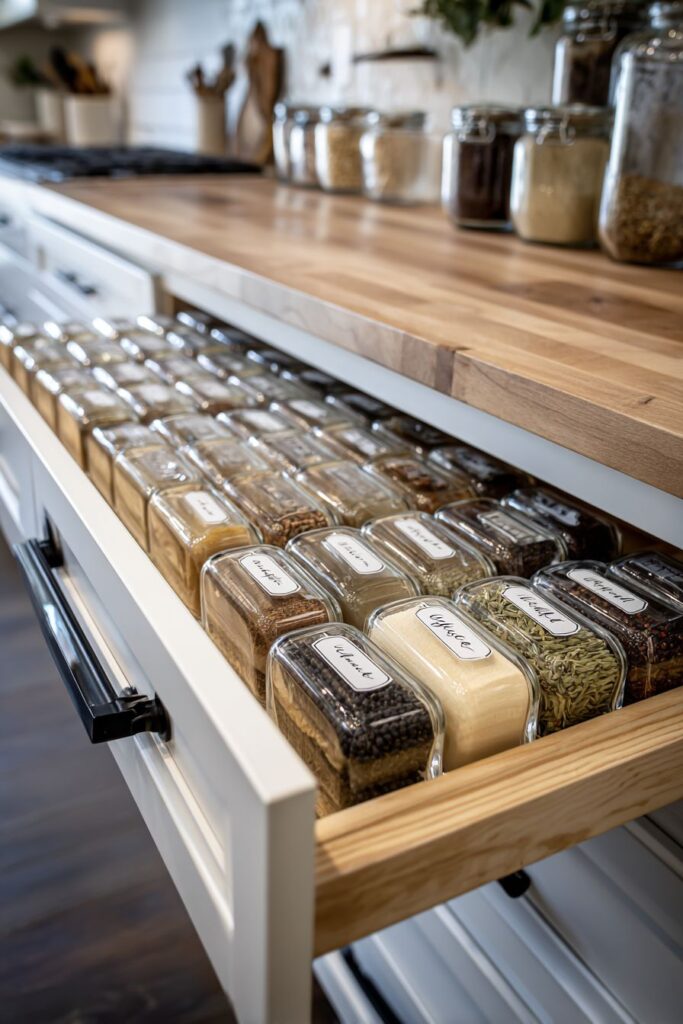
This system excels in maximizing drawer space through intelligent organization, where every container has its designated place. The smooth operation of soft-close hardware ensures longevity while reducing noise in busy kitchens. The combination of functionality and aesthetics makes this approach particularly suitable for open-concept homes where kitchen organization becomes part of the overall interior design narrative.
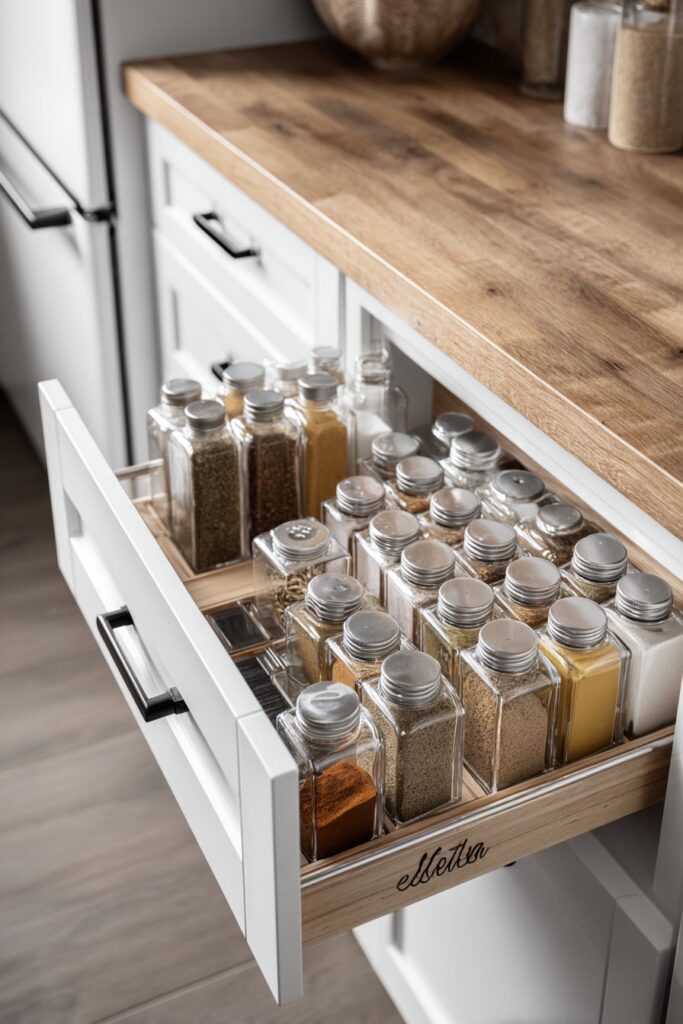
Key Design Tips:
- Choose uniform glass containers with airtight seals to maintain spice freshness and visual consistency
- Implement a labeling system using consistent typography and color schemes for professional appearance
- Install full-extension drawer slides to access containers at the back without struggle
- Consider drawer dividers or inserts to prevent containers from shifting during use
- Position frequently used spices toward the front for optimal workflow efficiency
2. Magnetic Wall-Mounted Innovation
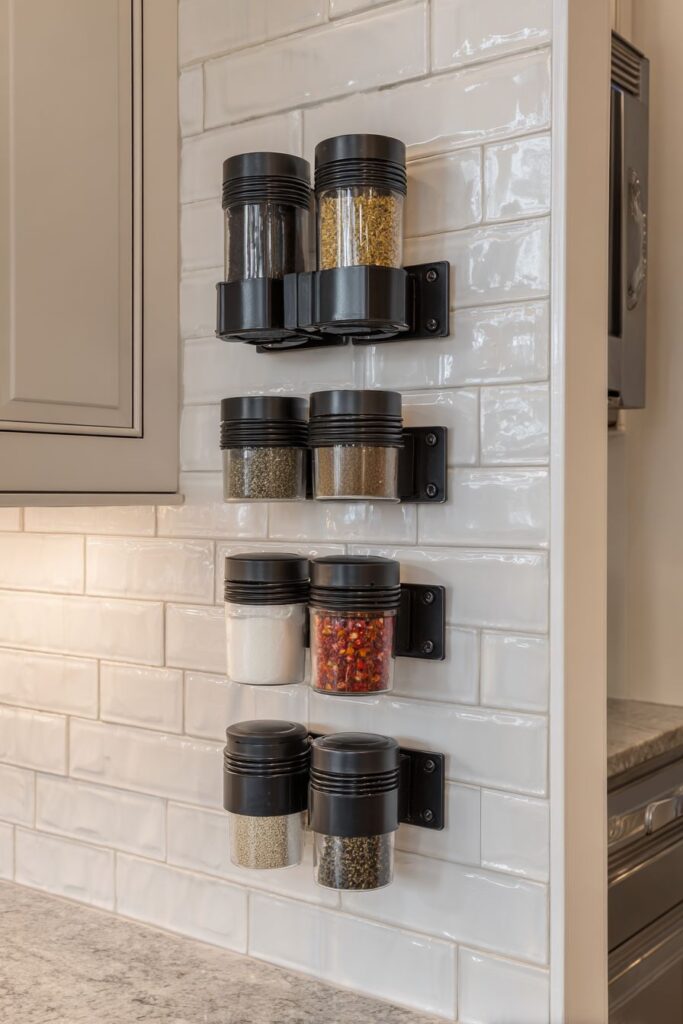
Creative vertical storage reaches new heights with magnetic spice systems that transform blank wall space into functional art. Stainless steel containers with matching magnetic lids create striking visual consistency against white subway tile backsplashes, embodying the modern farmhouse aesthetic that balances industrial materials with comfortable, lived-in appeal. The magnetic connection provides secure storage while allowing for easy rearrangement based on cooking preferences or seasonal ingredient changes.
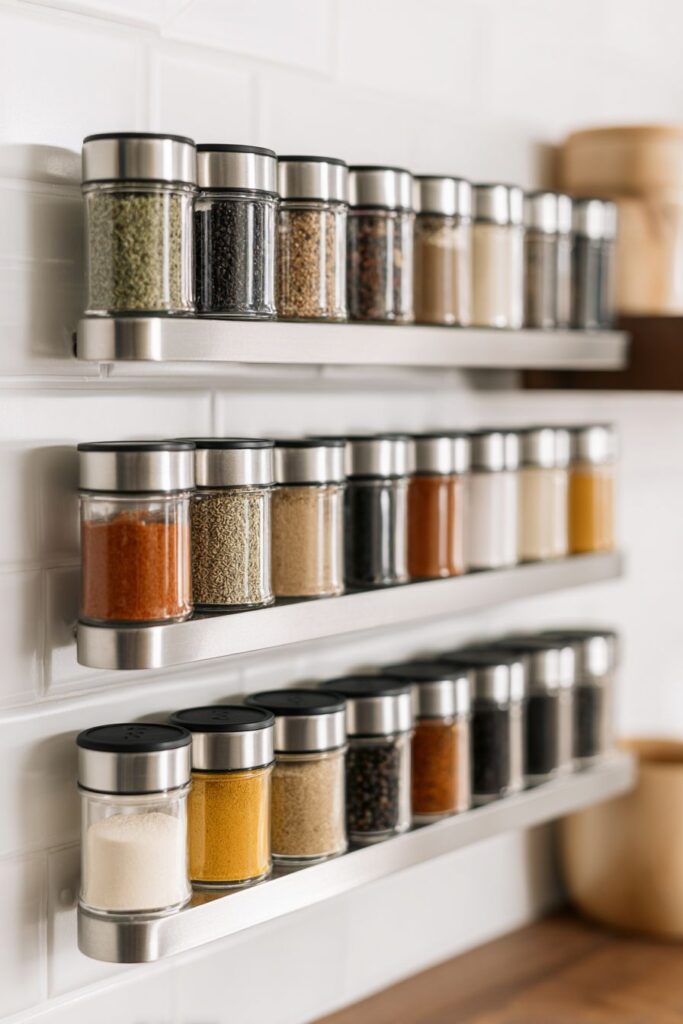
The beauty of this system lies in its flexibility and visual impact. Black magnetic lids create a sophisticated contrast against white tiles while providing clear visibility of spice contents through transparent containers. This approach maximizes wall space efficiency, particularly valuable in kitchens where cabinet storage is limited. The systematic arrangement transforms utilitarian storage into an organized display that celebrates the colors and textures of various spices.
Installation flexibility allows for customization based on available wall space and cooking habits. The magnetic system accommodates different container sizes and can be expanded or reconfigured as spice collections grow. Wide-angle photography captures how this solution efficiently utilizes vertical space while maintaining clean lines that complement contemporary kitchen design principles.
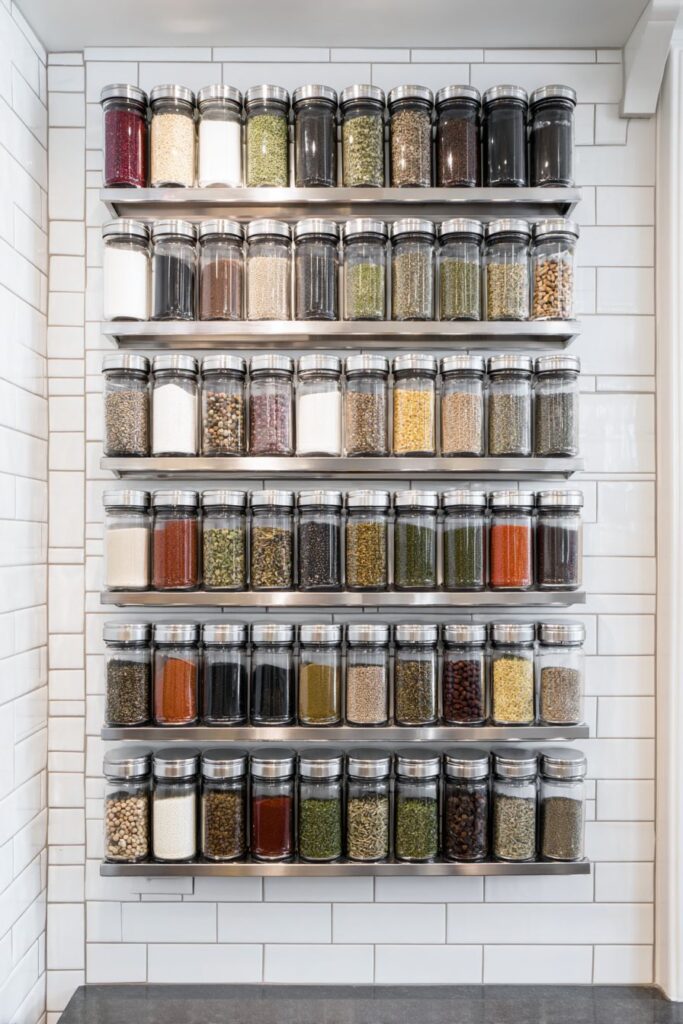
Professional interior photographers emphasize the importance of balanced lighting in showcasing these installations. Natural light highlights the metallic finishes while illuminating the vibrant spice colors within transparent containers, creating depth and visual interest that elevates the entire kitchen aesthetic.
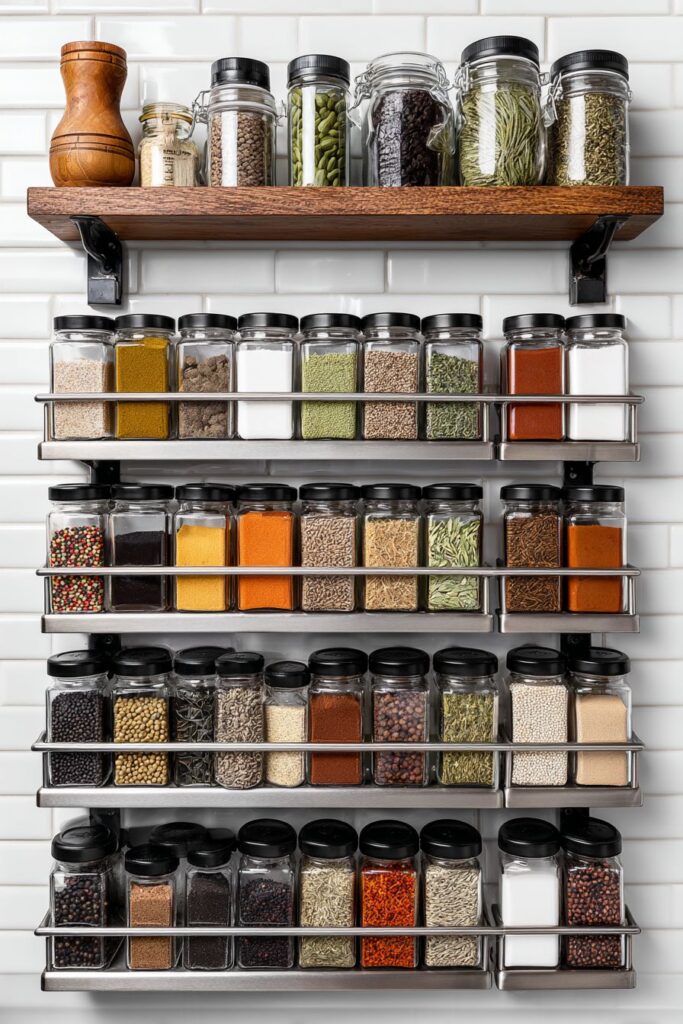
Key Design Tips:
- Select strong magnetic bases that can support filled containers without slipping
- Choose containers with wide openings for easy filling and measuring
- Install at appropriate heights for comfortable access during cooking
- Group similar spices together to create visual cohesion and cooking efficiency
- Consider the magnetic surface material to ensure long-term adhesion and easy cleaning
3. Rustic Barnwood Floating Shelves Charm
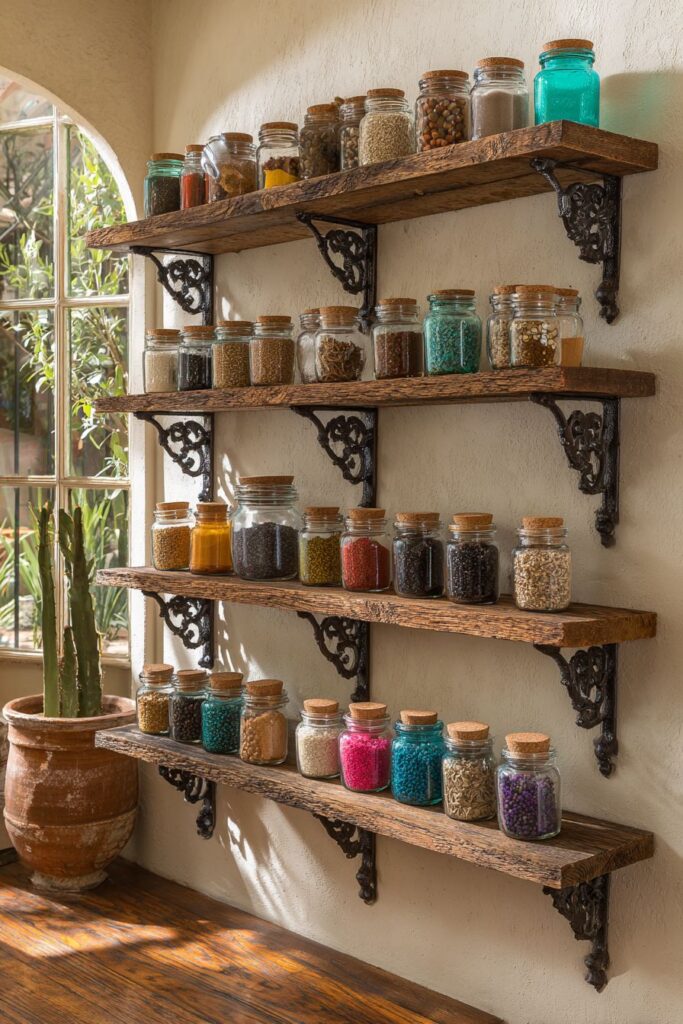
The warmth of reclaimed materials brings soul to spice storage through floating shelves crafted from weathered barnwood. This approach celebrates imperfection and history, where each board tells its own story through grain patterns, nail holes, and natural patina developed over decades of agricultural use. Vintage glass jars with cork stoppers provide authentic storage that honors traditional preservation methods while creating visual interest through varying sizes and shapes.
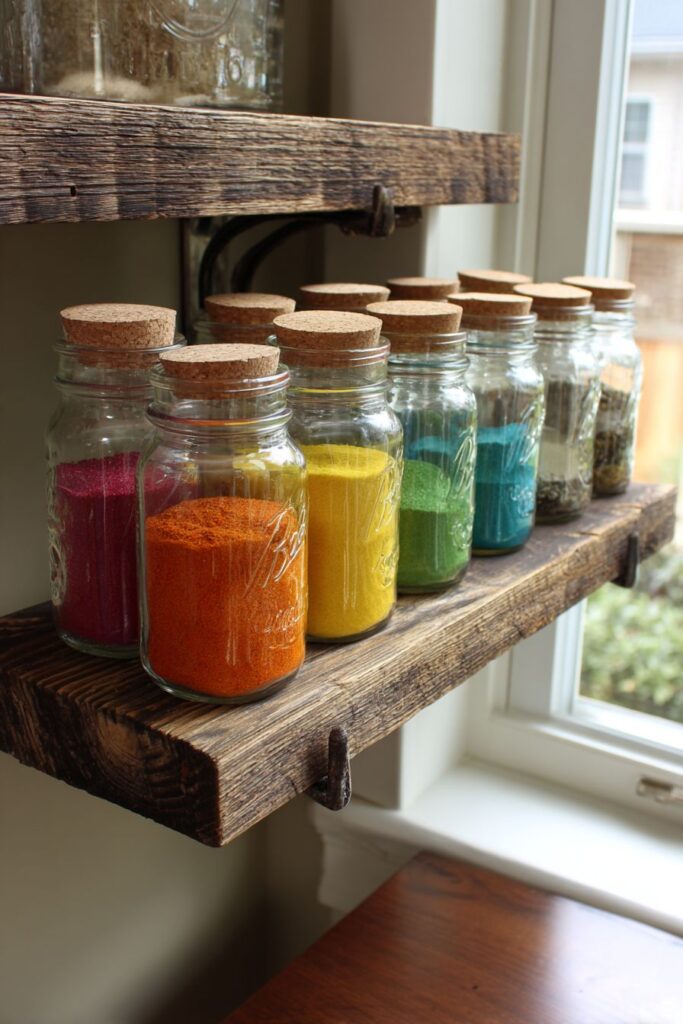
Mason jars of different dimensions contain colorful spices that create an organic rainbow effect against the weathered wood background. The natural variations in spice colors – from deep paprika reds to turmeric golds and sage greens – transform functional storage into an artistic display that changes with seasonal cooking preferences. Wrought iron brackets provide sturdy support while adding authentic period details that complement the rustic aesthetic.
Natural lighting from nearby windows creates dramatic interplay between light and shadow, highlighting the wood grain textures while making glass surfaces gleam with warm reflections. This lighting quality changes throughout the day, creating a dynamic display that never looks exactly the same twice. The combination of materials – weathered wood, vintage glass, and aged metal – creates textural richness that invites touch and closer examination.
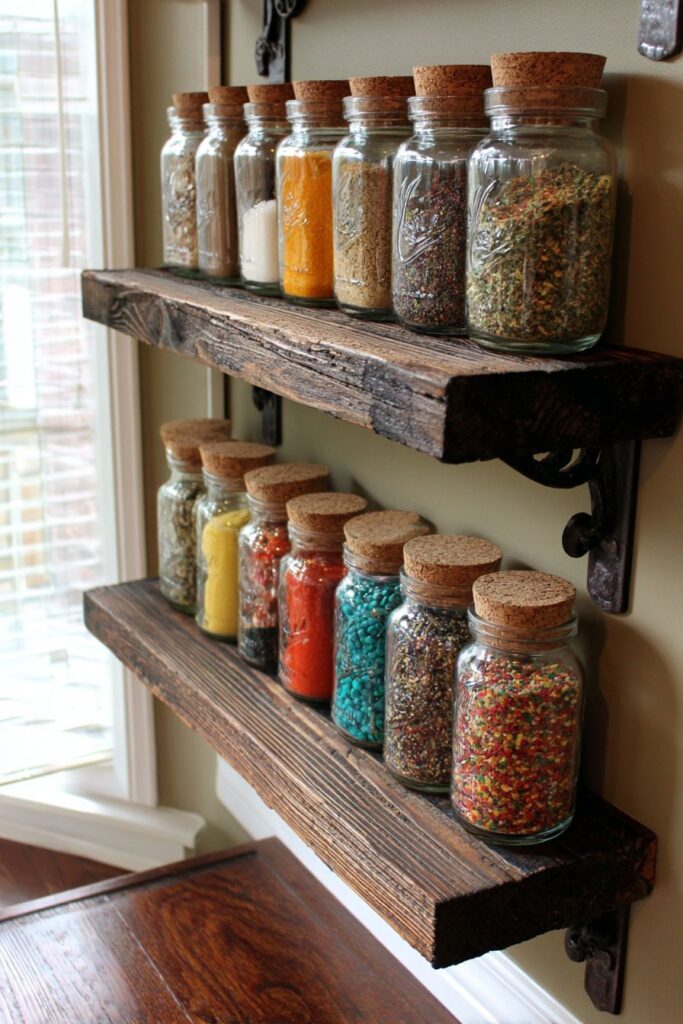
The flexibility of this system allows for easy reorganization and expansion as spice collections grow. Different jar sizes accommodate various quantities while maintaining visual interest through asymmetrical arrangements that feel natural rather than forced. This approach particularly suits country kitchens, farmhouse designs, and spaces that celebrate handcrafted, authentic materials over manufactured perfection.
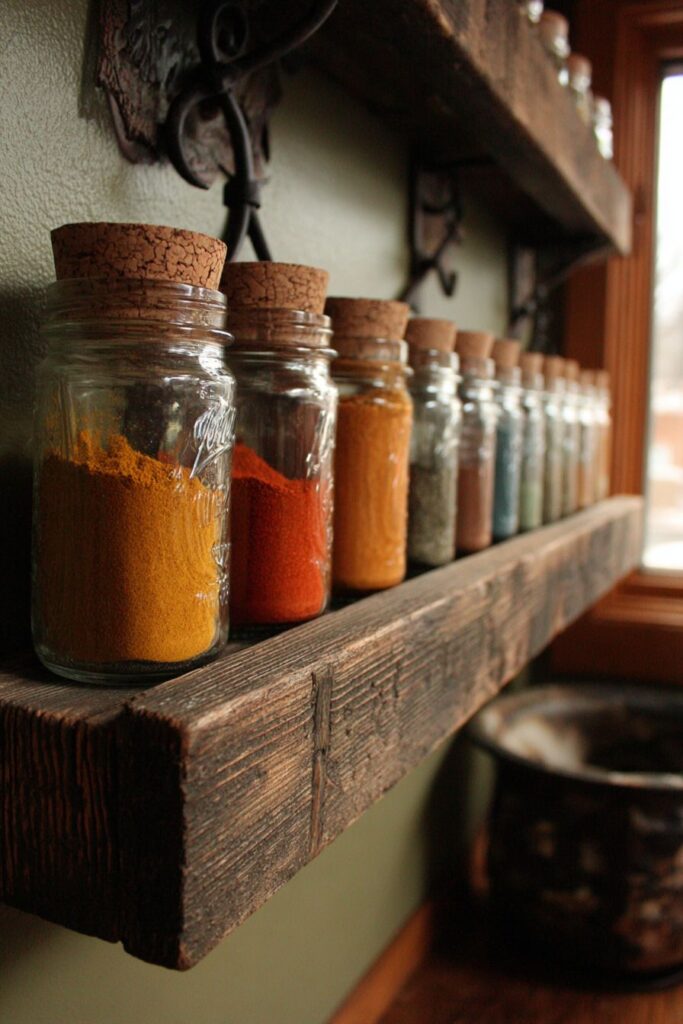
Key Design Tips:
- Source authentic reclaimed wood with interesting grain patterns and weathering
- Seal wood surfaces to protect against moisture while preserving natural character
- Mix jar sizes and shapes for visual interest and practical variety
- Install brackets that complement the rustic aesthetic while providing adequate support
- Group spices by color families to enhance the natural rainbow effect
4. Minimalist Acrylic Linear Design
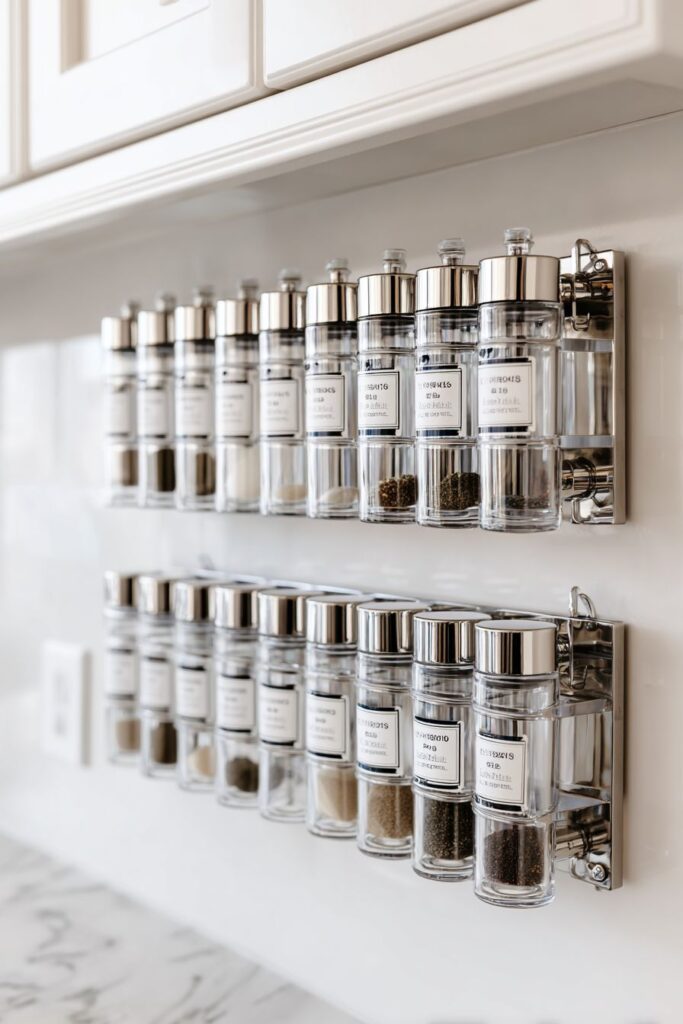
Clean, geometric precision defines minimalist spice storage through identical clear acrylic containers mounted on sleek stainless steel rail systems. This approach embodies the “less is more” philosophy where every element serves both functional and aesthetic purposes without unnecessary ornamentation. Precise white labels featuring modern sans-serif typography create a consistent visual rhythm while ensuring easy identification of contents.
The installation against pristine white kitchen walls above natural marble countertops creates a sophisticated backdrop that allows the spice system to become a focal point through its organized simplicity. The transparency of acrylic containers eliminates visual weight while providing complete visibility of contents, making the spices themselves the primary decorative element. This material choice also offers practical advantages including easy cleaning and resistance to staining or odor absorption.
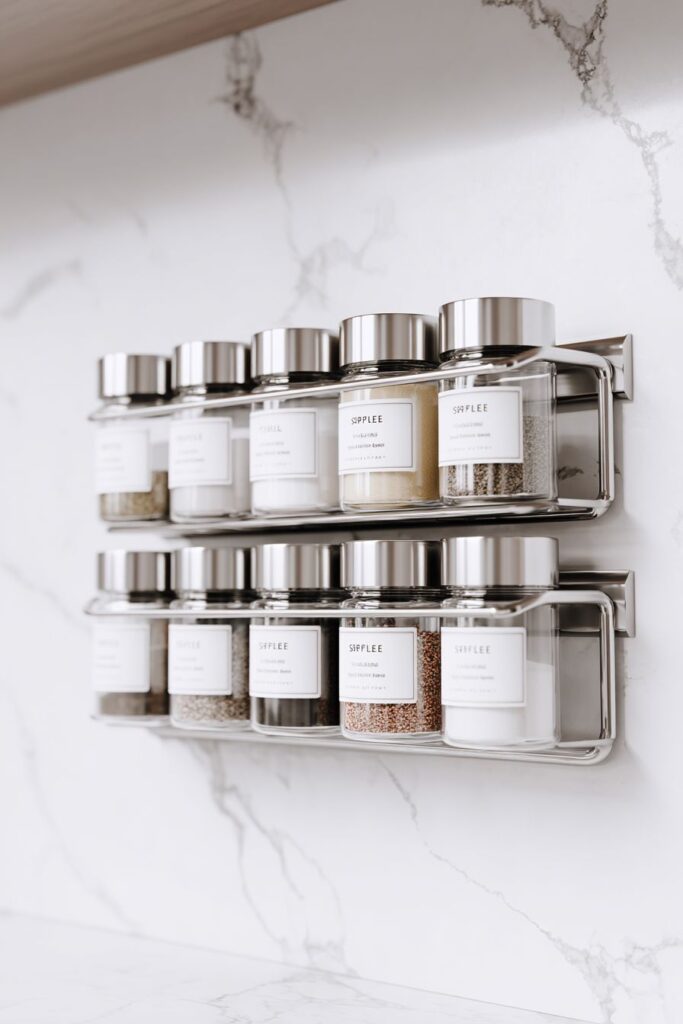
Professional interior photography with crisp lighting showcases how systematic organization becomes an art form in minimalist design. The consistent spacing between containers creates visual rhythm that pleases the eye while facilitating efficient cooking workflows. The lack of decorative elements forces attention to the inherent beauty of organized ingredients and quality materials.
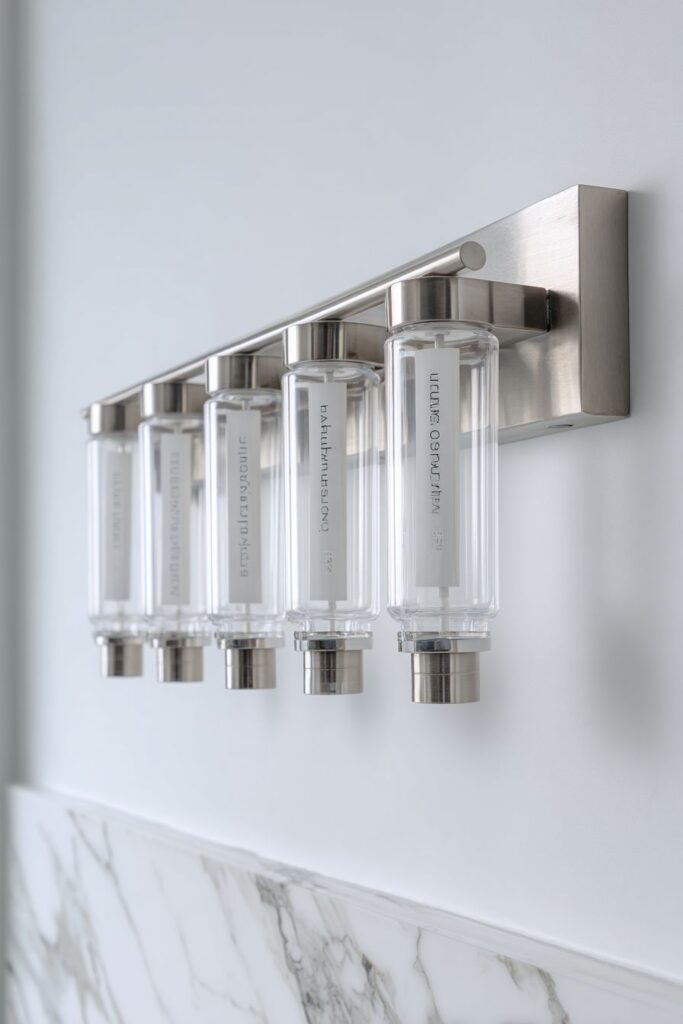
The modular nature of rail-mounted systems allows for future expansion or reconfiguration without requiring major installation changes. This flexibility appeals to minimalist sensibilities that value adaptability and efficiency over permanent solutions. The clean lines integrate seamlessly with contemporary kitchen aesthetics while providing the organizational efficiency that modern cooking demands.
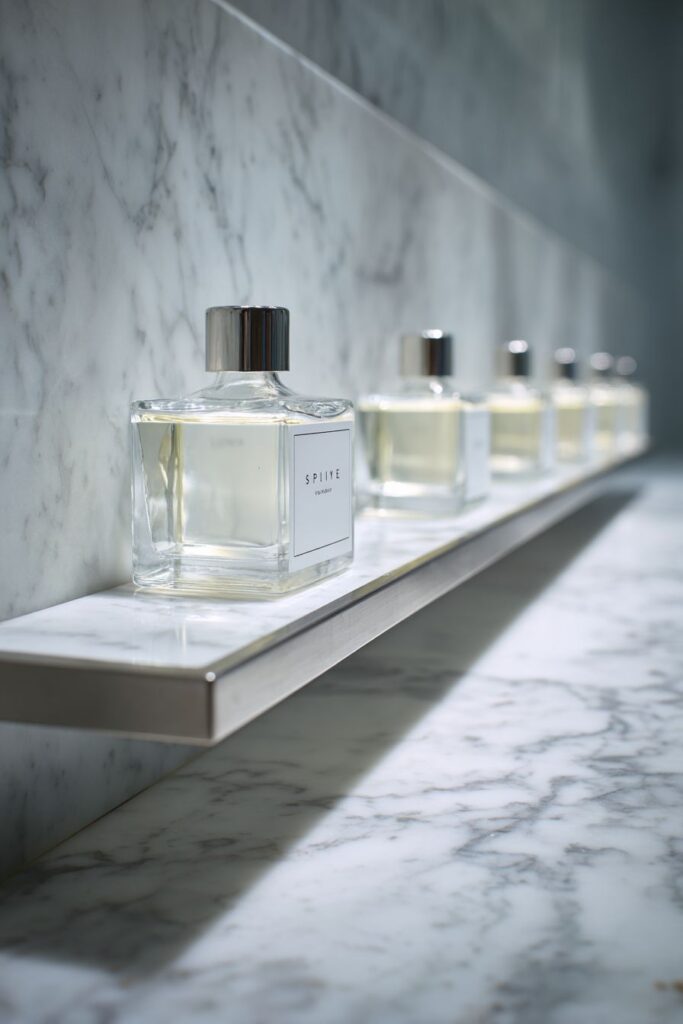
Key Design Tips:
- Invest in high-quality acrylic containers with precise measurements for visual consistency
- Use consistent label typography and spacing to maintain clean visual lines
- Choose stainless steel rails that complement other kitchen hardware finishes
- Mount at eye level for easy reading and access during cooking
- Maintain consistent spacing between containers for optimal visual impact
5. Space-Saving Small Kitchen Solutions
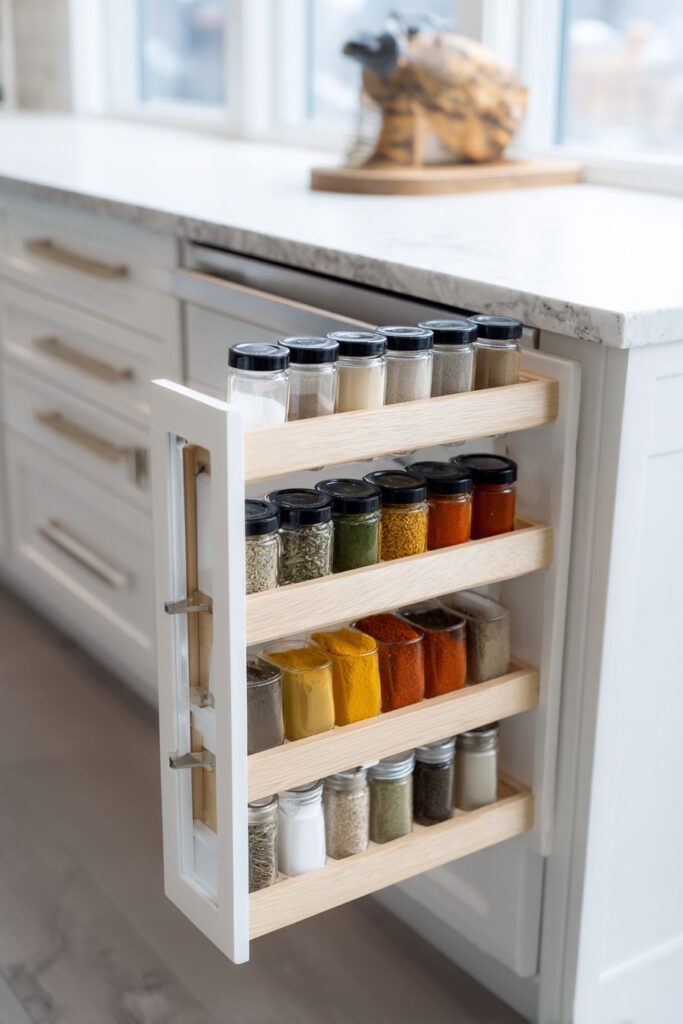
Maximizing functionality in compact spaces requires innovative thinking that transforms every available inch into purposeful storage. Narrow pull-out cabinet organizers with tiered shelving systems demonstrate how vertical space utilization can dramatically increase storage capacity without expanding the kitchen footprint. These solutions feature multiple levels that maintain easy access to frequently used spices while accommodating extensive collections in minimal space.
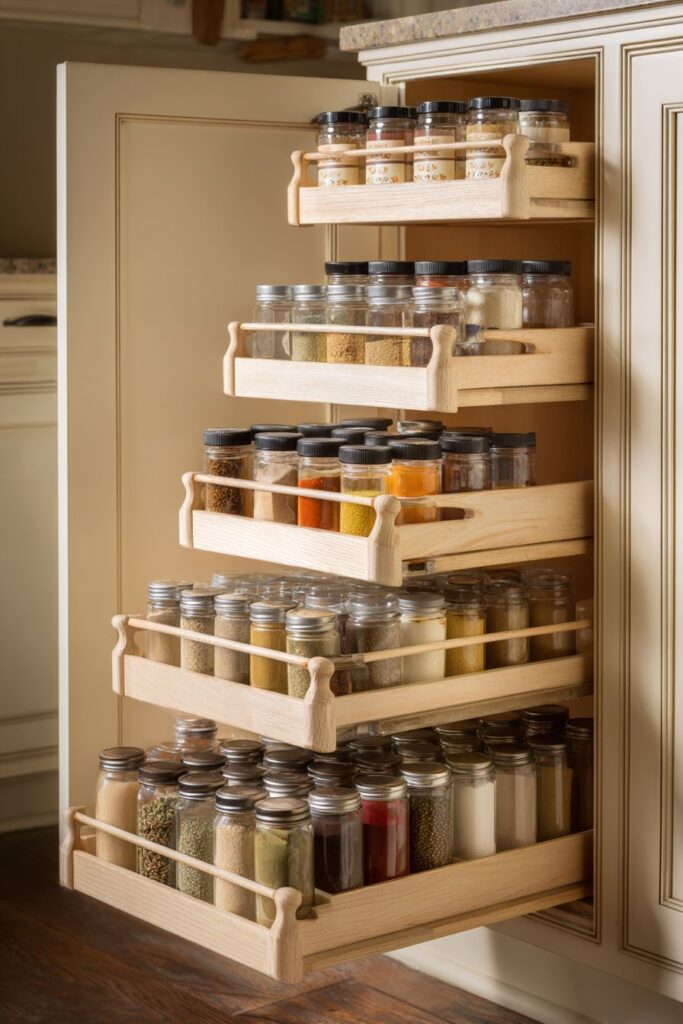
White painted wood construction seamlessly matches existing cabinetry, creating visual continuity that makes small spaces feel larger and more cohesive. The tiered design ensures that every spice remains visible and accessible, eliminating the frustration of items getting lost in deep cabinets. This systematic approach to organization reduces cooking time while maximizing the efficiency of limited kitchen real estate.
The pull-out mechanism transforms narrow cabinet spaces into fully functional spice storage that extends completely beyond the cabinet face for total access. This feature eliminates the need to reach into dark corners or remove multiple items to access those at the back. Interior design photography captures how clever engineering makes previously unusable space into valuable storage real estate.
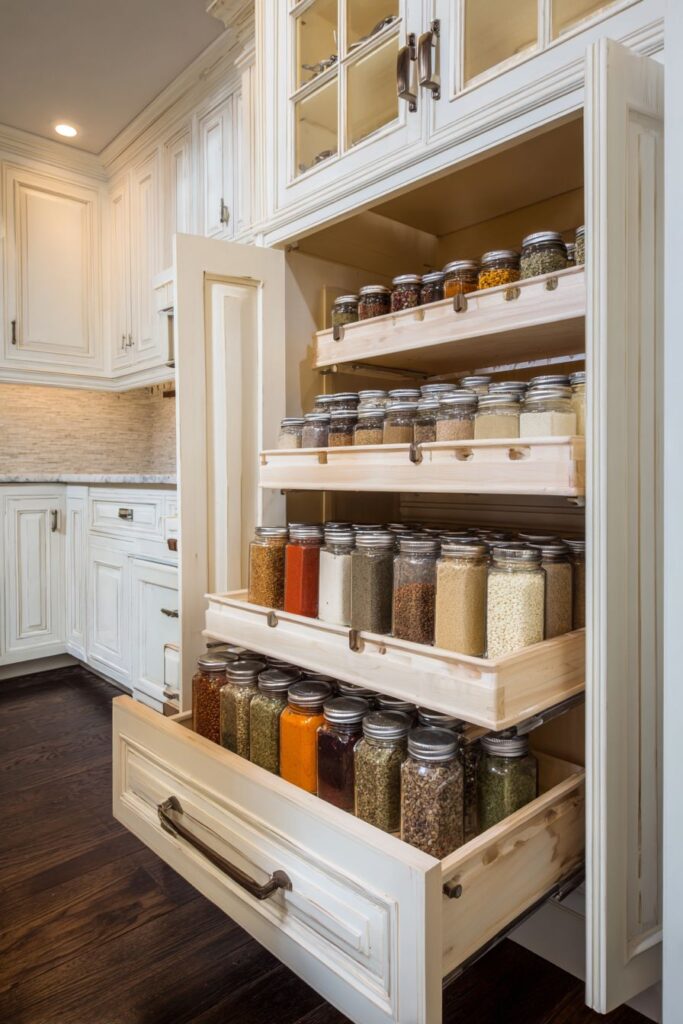
Natural lighting highlights the practical functionality while demonstrating how organized arrangements create visual appeal even in compact spaces. The clean white surfaces reflect available light, making the storage area feel brighter and more open. This approach particularly benefits apartment dwellers and urban homeowners who must maximize every square foot of kitchen space.
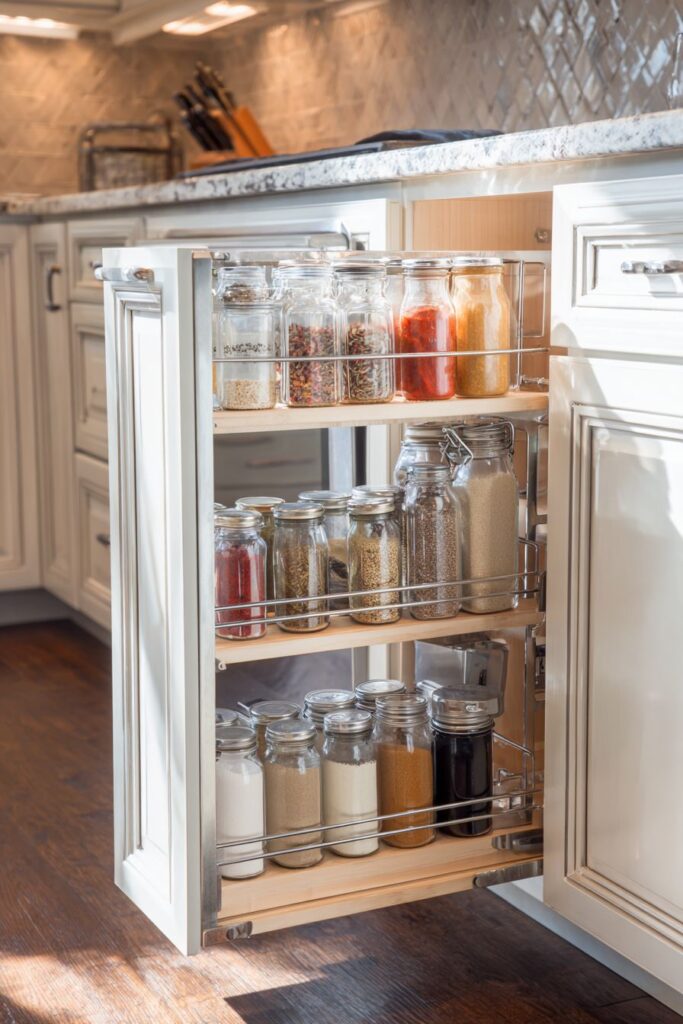
Key Design Tips:
- Measure cabinet dimensions precisely to maximize the use of available space
- Choose tiered systems that provide clear sight lines to all stored items
- Install full-extension slides for complete access to contents
- Consider weight capacity when selecting hardware for heavy spice collections
- Use light colors and reflective surfaces to enhance the sense of space
6. Industrial Black Iron Framework
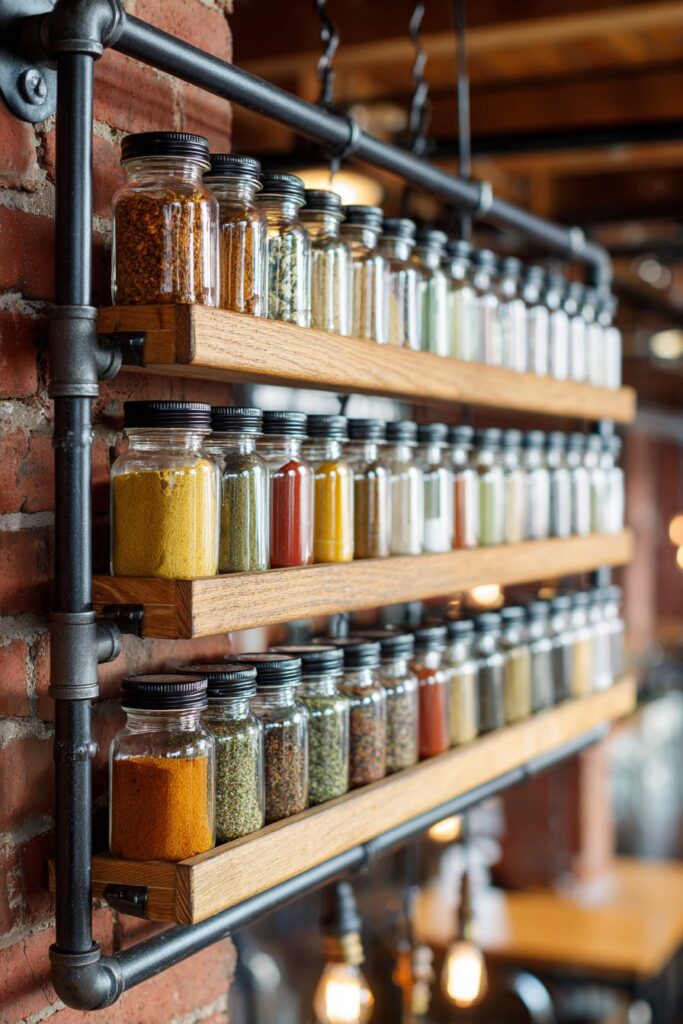
Raw industrial materials create dramatic spice storage that celebrates utilitarian aesthetics through black iron pipe frameworks with wooden shelf inserts. This approach transforms functional necessity into an architectural statement, where exposed structural elements become decorative features that complement converted loft spaces and urban kitchens. Uniform glass containers maintain organization while allowing industrial materials to take center stage.
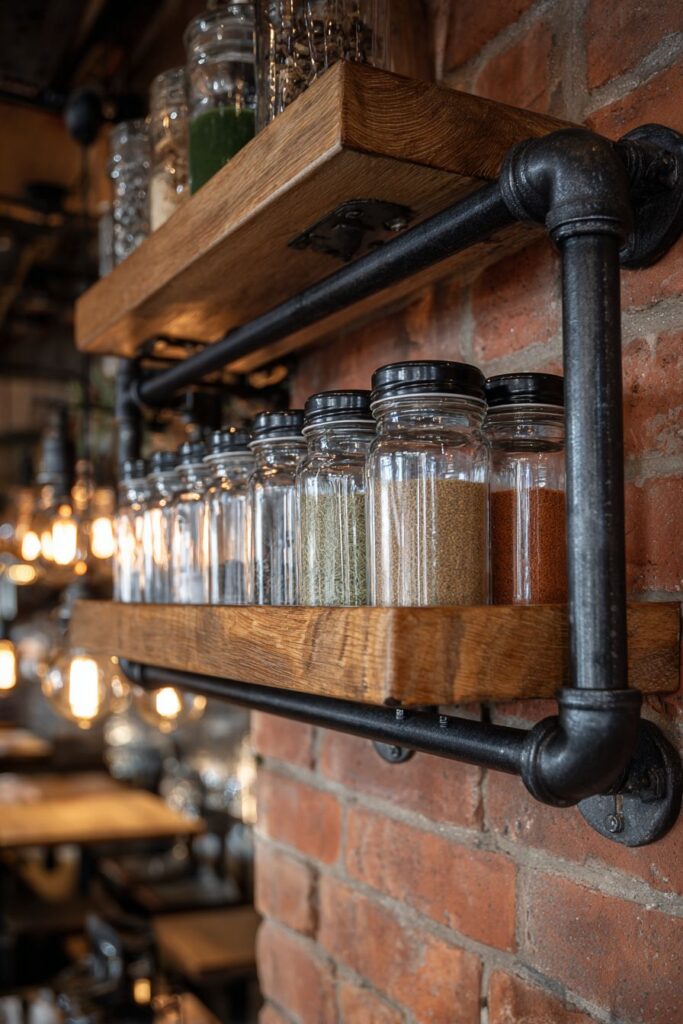
The combination of black metal and warm wood creates sophisticated contrast that adds visual interest without overwhelming the space. Iron pipe construction provides exceptional durability while offering flexibility for custom configurations that adapt to specific space requirements. Wooden shelf inserts introduce natural warmth that balances the coolness of metal, creating harmony between industrial and organic elements.
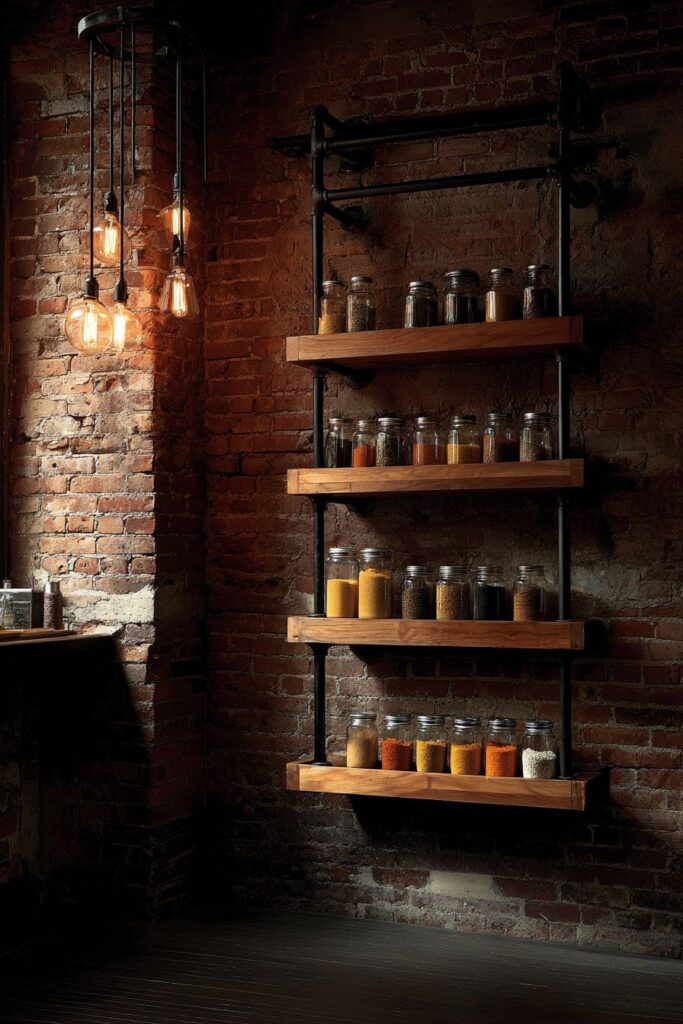
Edison bulb pendant lighting enhances the industrial atmosphere while creating dramatic shadows that highlight the varied spice colors within transparent containers. This lighting choice reinforces the urban loft aesthetic while providing practical illumination for cooking tasks. The interplay between light and shadow adds depth and visual texture that changes throughout the day.
Wide-angle photography emphasizes how industrial elements integrate with exposed brick walls and other architectural features common in converted spaces. The system’s modular nature allows for expansion or reconfiguration as needs change, reflecting the adaptable nature of industrial design principles.
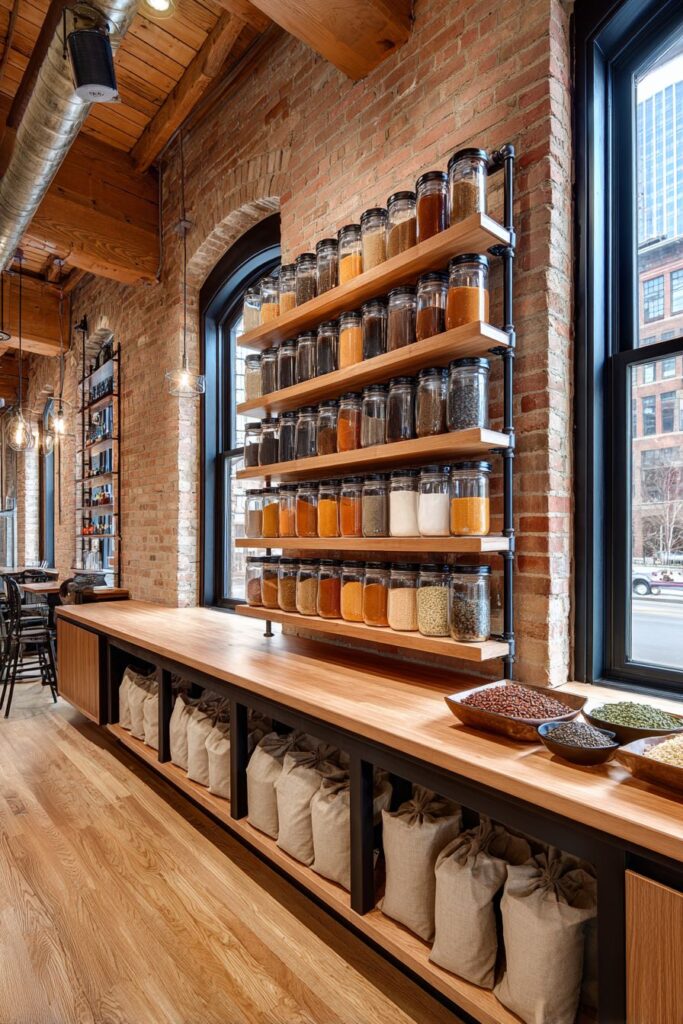
Key Design Tips:
- Use black iron pipe fittings for authentic industrial appearance and maximum durability
- Select wood species that complement existing kitchen materials and finishes
- Ensure adequate spacing between shelves for different container heights
- Consider weight distribution when planning shelf placement and support
- Install appropriate electrical connections for accent lighting integration
7. Traditional Mahogany Cabinet Craftsmanship
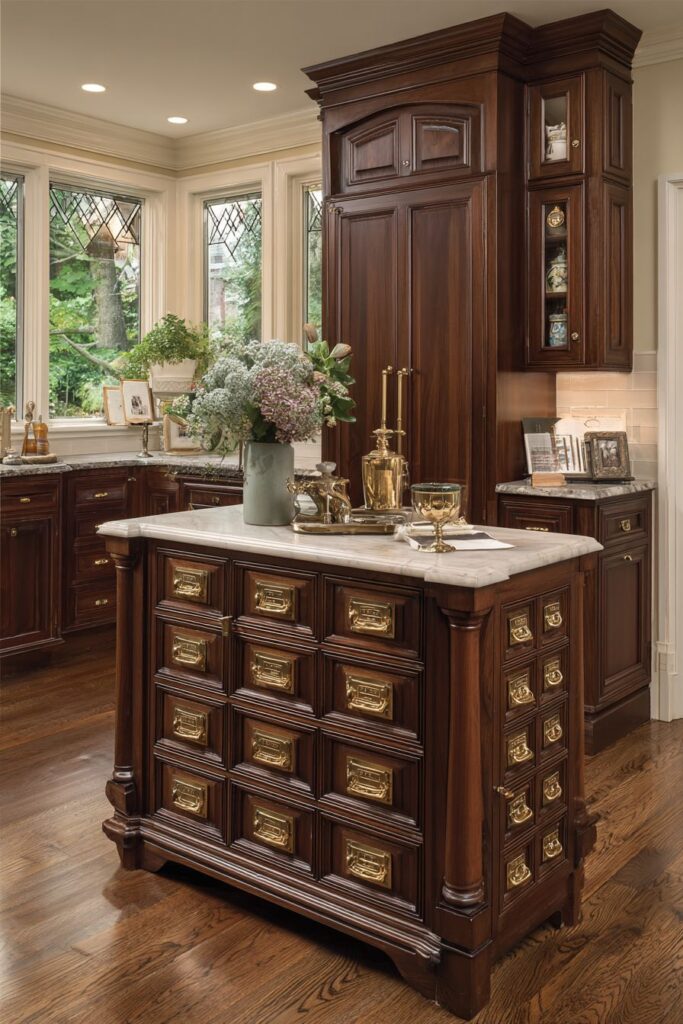
Timeless elegance emerges through classic wooden spice cabinets featuring multiple small drawers with vintage-style brass nameplates. Rich mahogany finishes complement traditional kitchen cabinetry in colonial-style homes, where craftsmanship and material quality take precedence over modern convenience. This approach celebrates traditional woodworking techniques while providing efficient organization that has satisfied cooks for generations.
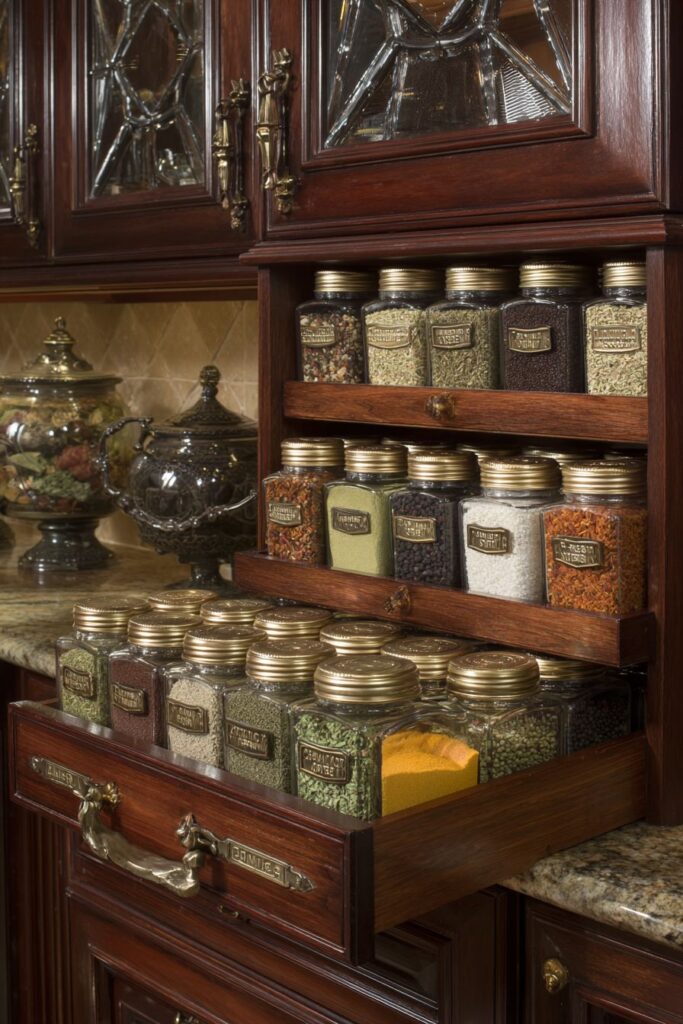
Each individual drawer provides dedicated storage for specific spices, eliminating cross-contamination of flavors while maintaining optimal freshness through enclosed storage. Brass nameplates add authentic period details while ensuring easy identification of contents. The rich wood grain and deep finish create warmth that anchors traditional kitchen designs while providing focal points that reward closer examination.
Soft natural lighting from leaded glass windows creates gentle reflections on polished wood surfaces, highlighting the quality of craftsmanship and attention to detail. This lighting quality changes throughout the day, creating subtle variations in appearance that add life to static furniture pieces. The traditional construction methods ensure longevity that spans generations.
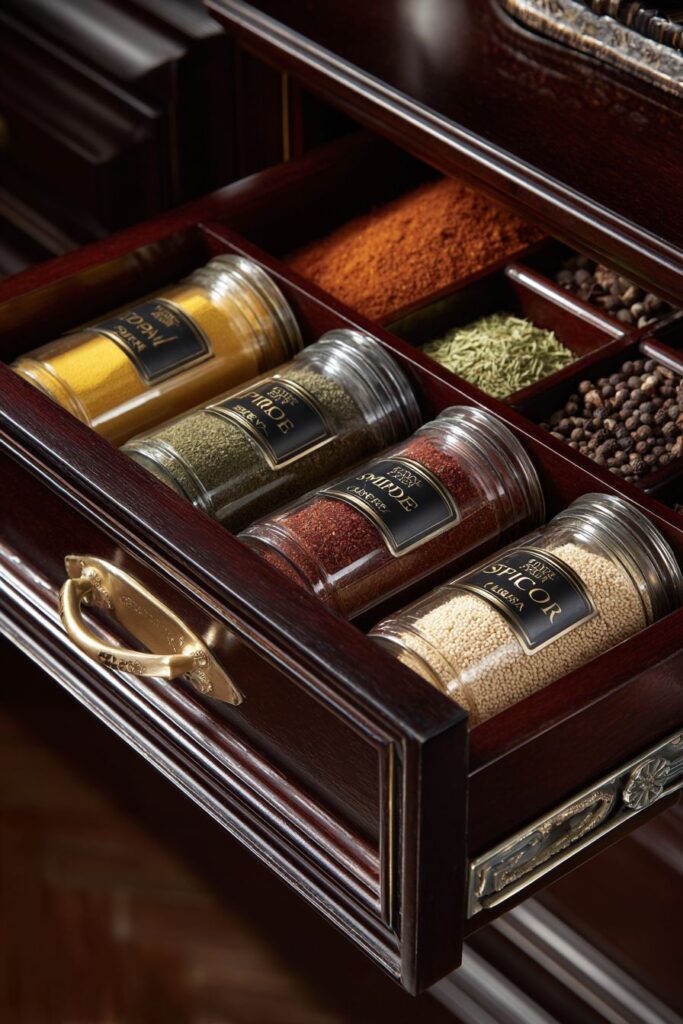
Detail photography focuses on hardware quality and joinery techniques that distinguish handcrafted furniture from mass-produced alternatives. The investment in quality materials and construction pays dividends in both appearance and durability, making these pieces valuable additions to traditional kitchen designs.
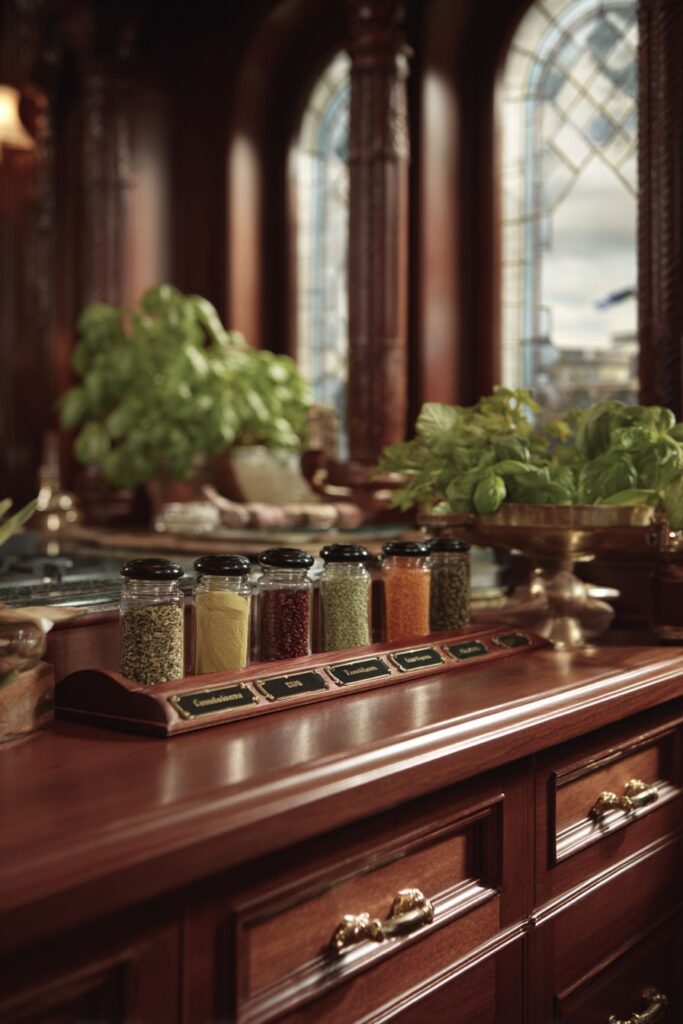
Key Design Tips:
- Choose high-quality hardwood with attractive grain patterns for lasting beauty
- Invest in solid brass hardware that will develop attractive patina over time
- Ensure proper drawer construction with dovetail joints for durability
- Apply protective finishes that enhance wood grain while providing practical protection
- Size drawers appropriately for standard spice container dimensions
8. Contemporary Rotating Carousel Functionality
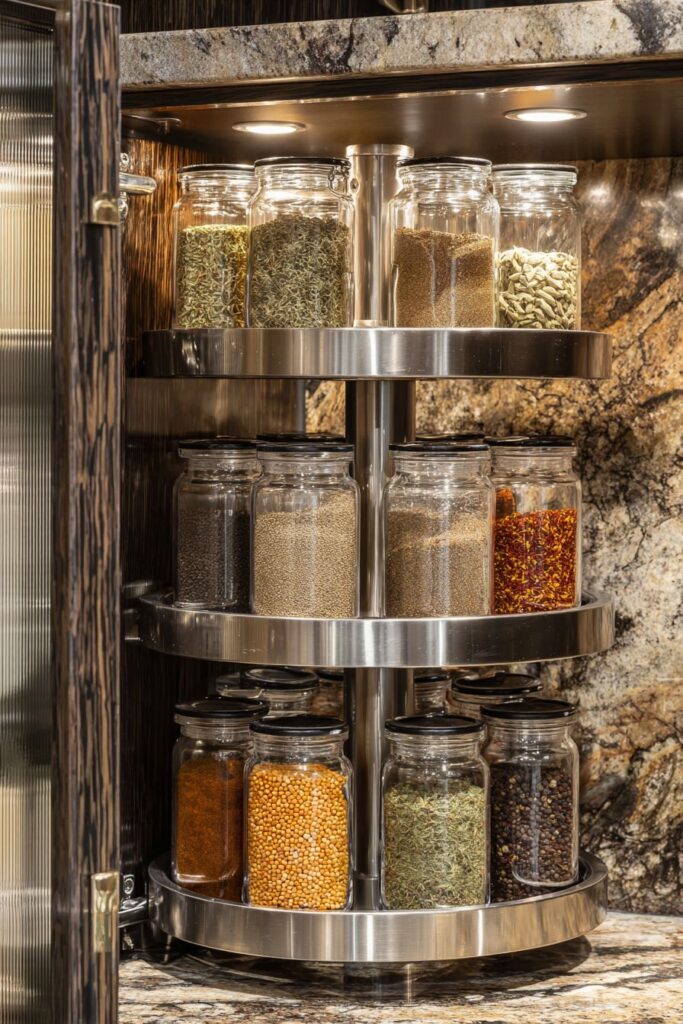
Modern engineering meets culinary convenience through rotating carousel designs in brushed stainless steel featuring clear glass jars with airtight seals. These systems maximize accessibility while maintaining compact footprints on valuable counter space, demonstrating how thoughtful design can solve multiple organizational challenges simultaneously. The rotating mechanism provides effortless access to all spices without the need to move or reorganize containers.
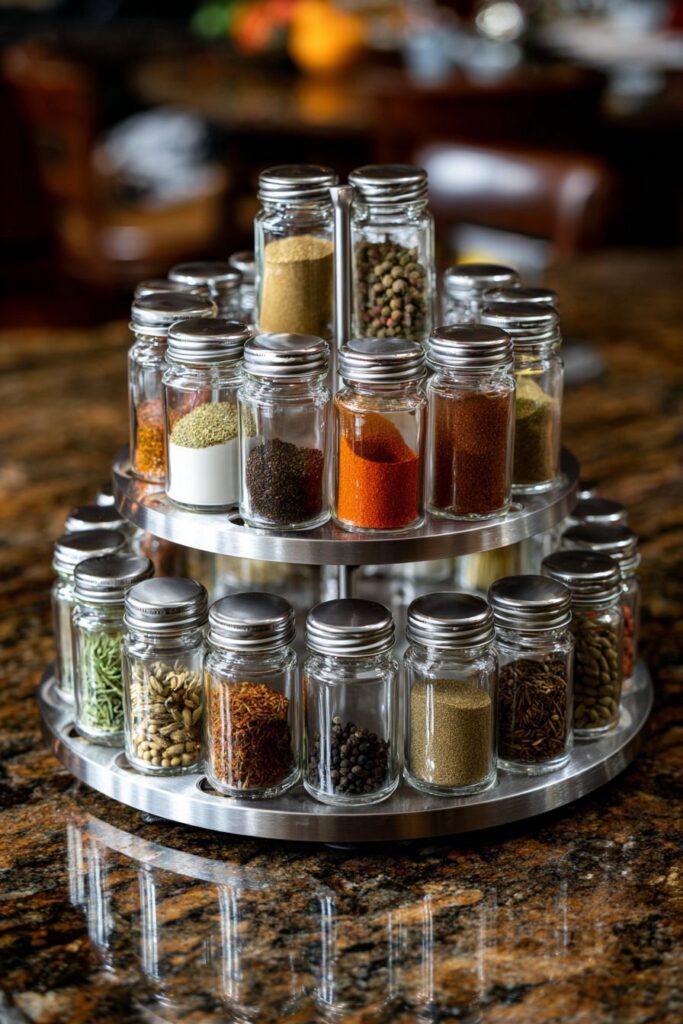
Brushed stainless steel construction complements contemporary kitchen appliances while providing durability that withstands daily use. The material choice offers practical advantages including easy cleaning, resistance to corrosion, and maintenance of appearance over time. Clear glass jars with precise airtight seals ensure spice freshness while providing complete visibility of contents and remaining quantities.
Professional interior photography with balanced lighting showcases how modern materials and engineering create sophisticated storage solutions that enhance rather than detract from kitchen aesthetics. The circular organization creates pleasing visual rhythm while demonstrating the efficiency of radial arrangement for maximizing storage density.
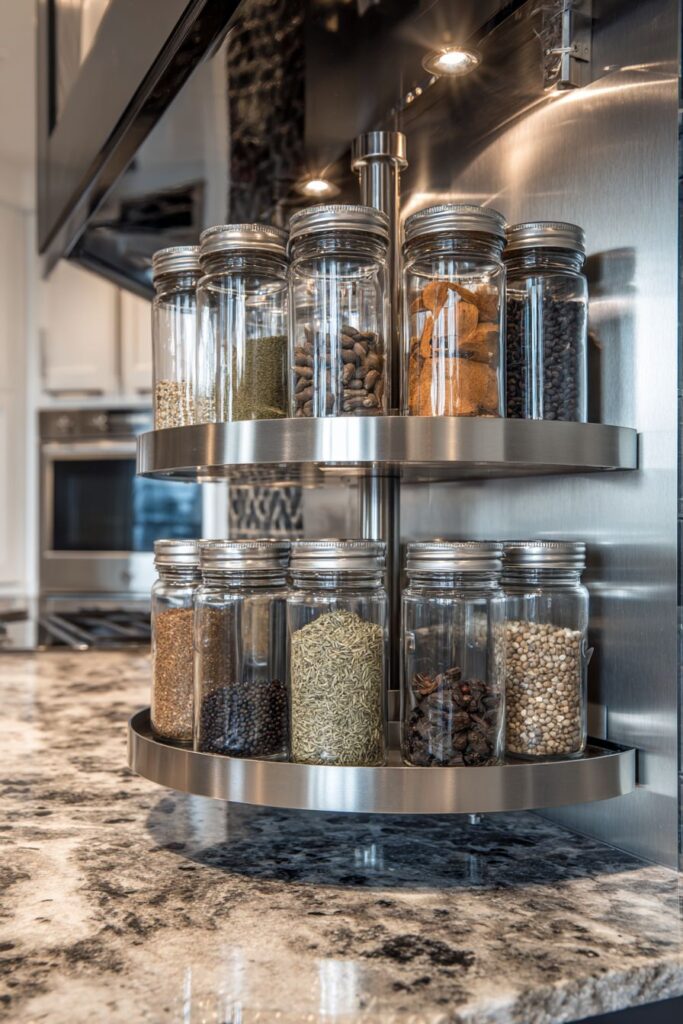
The compact design makes this approach particularly suitable for kitchens where counter space is premium, yet spice accessibility remains important for efficient cooking workflows. The ability to rotate the entire collection brings any spice to the front position instantly, eliminating searching and reorganizing.
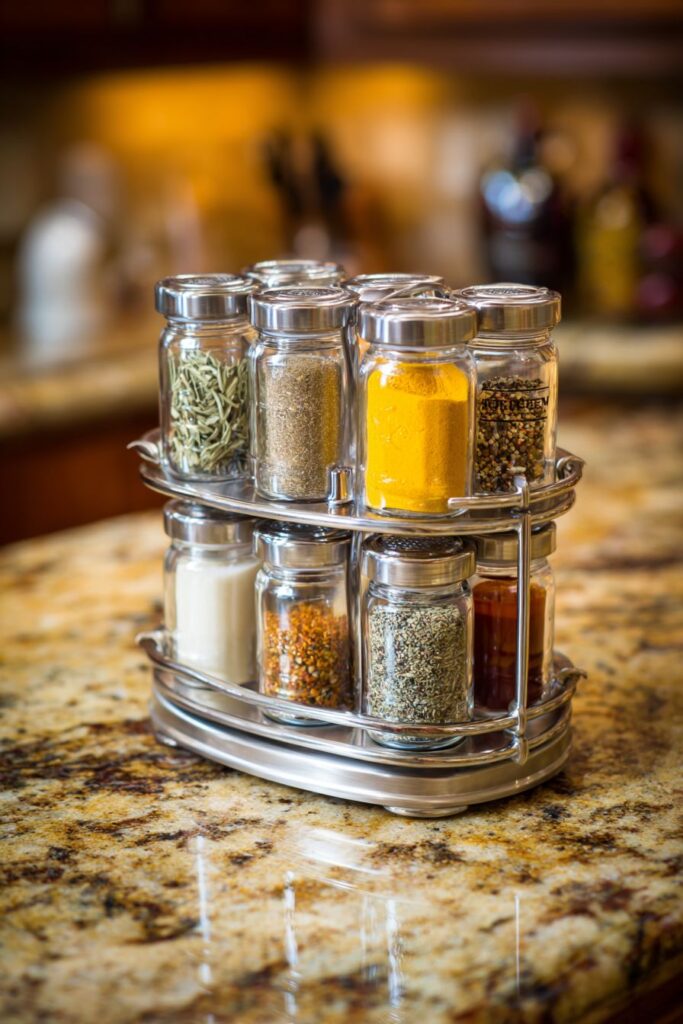
Key Design Tips:
- Select carousel mechanisms with smooth, quiet rotation for pleasant operation
- Choose glass jars with secure, airtight seals to maintain spice quality
- Consider height limitations to ensure comfortable access from all angles
- Balance weight distribution to prevent tipping or instability
- Position on stable surfaces away from high-traffic cooking areas
9. Scandinavian Birch Wood Simplicity
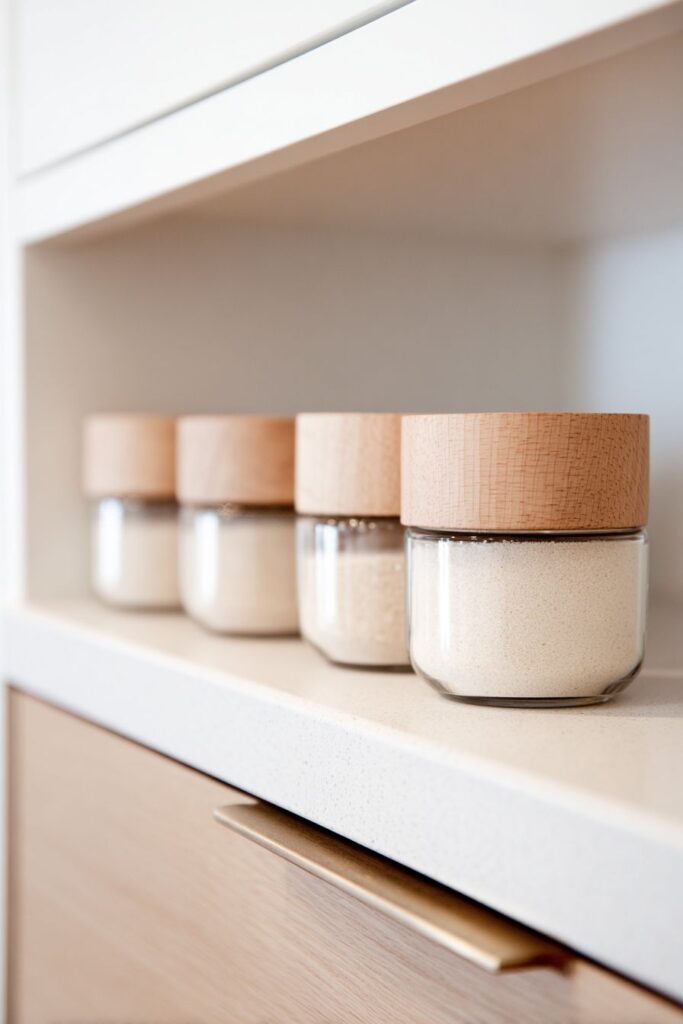
Nordic design principles shine through light birch wood construction with clean geometric lines and uniform glass containers featuring wooden lids. This aesthetic celebrates natural materials and functional beauty, where every element serves a purpose while contributing to a serene, uncluttered organization. The simple design integrates seamlessly into white kitchens with natural wood accents, creating harmony between storage and overall design themes.
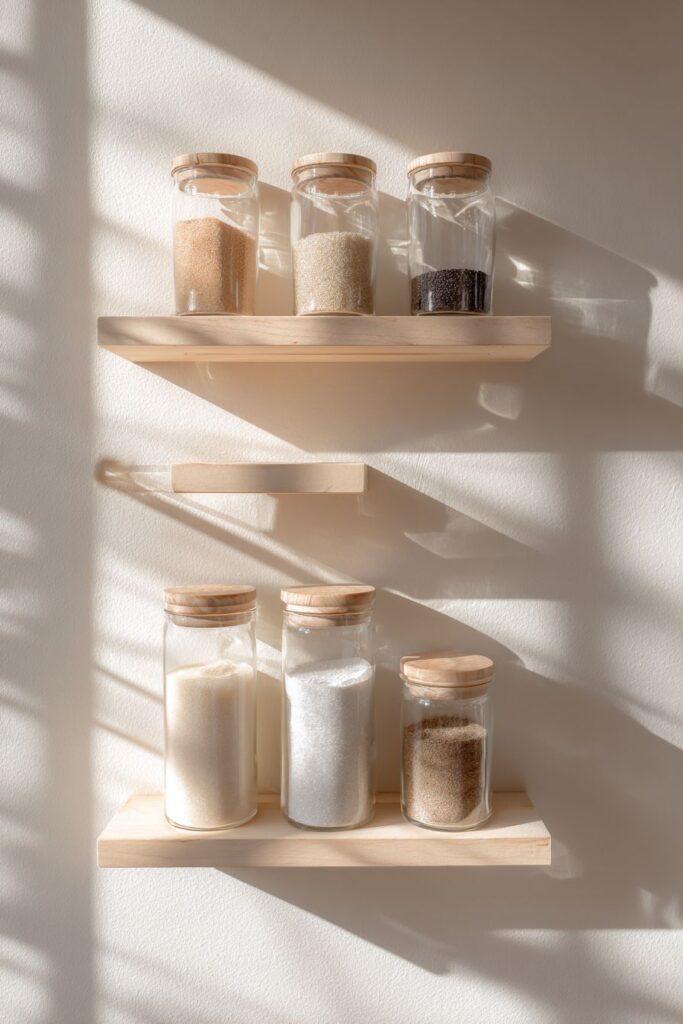
Light birch wood offers subtle grain patterns that add visual interest without overwhelming minimalist aesthetics. The pale wood tones complement white kitchen surfaces while introducing natural warmth that prevents spaces from feeling stark or institutional. Uniform glass containers with wooden lids create visual consistency while celebrating the beauty of natural materials.
Soft diffused lighting creates gentle shadows that highlight natural wood grain textures while maintaining the serene atmosphere characteristic of Scandinavian design. This lighting approach avoids harsh contrasts, instead creating subtle variations that add depth without drama. The overall effect promotes calm, organized cooking environments that reduce stress while enhancing efficiency.
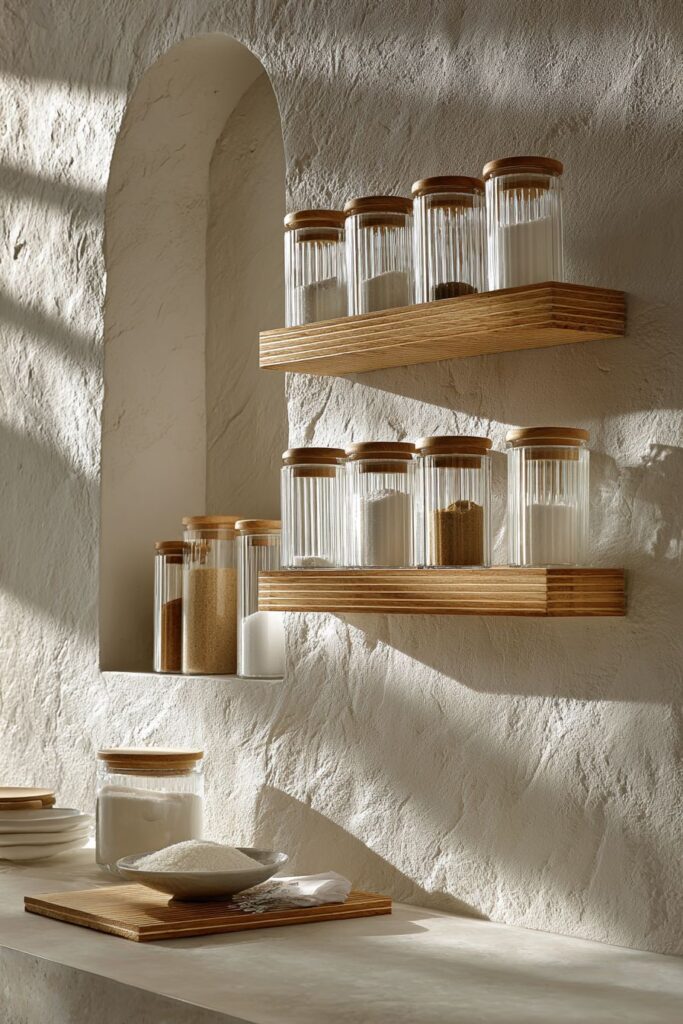
Interior design photography captures how uncluttered organization becomes a form of visual meditation, where the act of cooking begins with the peaceful contemplation of well-organized ingredients. This approach particularly appeals to those who find beauty in simplicity and function.
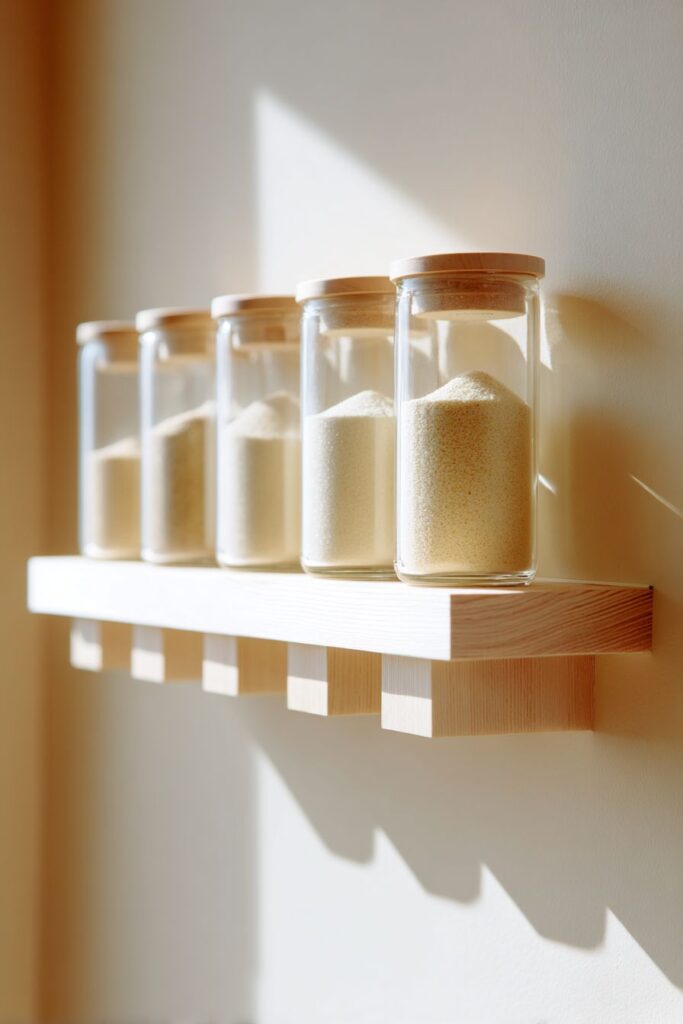
Key Design Tips:
- Select light wood species that complement rather than compete with other kitchen elements
- Choose uniform containers that create visual rhythm through repetition
- Maintain consistent spacing and alignment for maximum visual impact
- Apply natural finishes that enhance wood grain while providing practical protection
- Integrate lighting that highlights natural materials without creating harsh shadows
10. Custom Built-In Drawer Integration
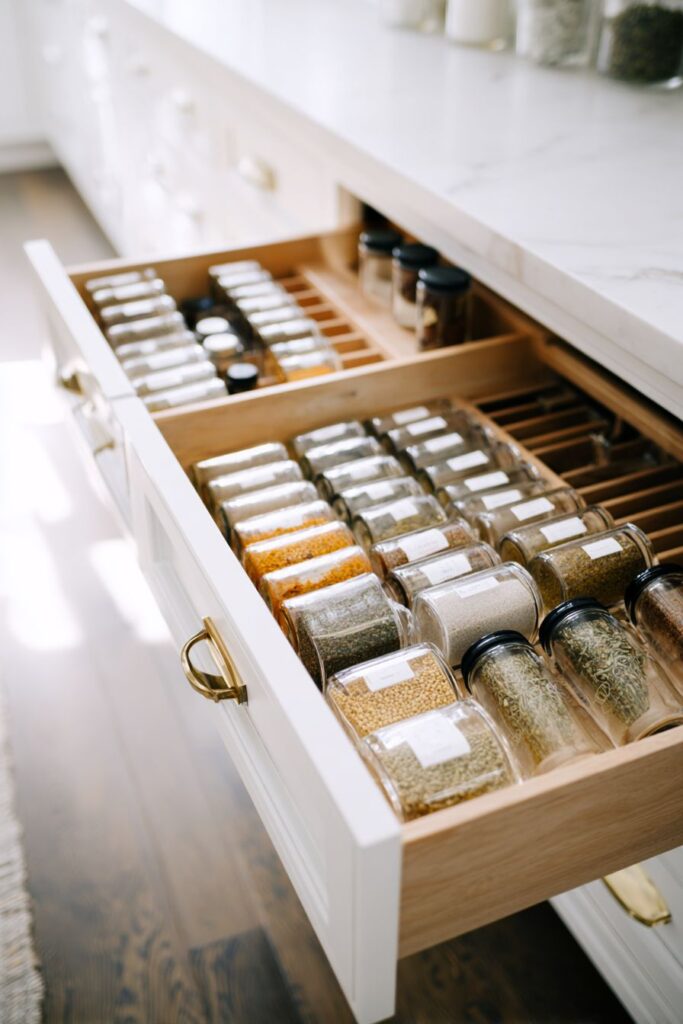
Seamless integration reaches perfection through custom cabinetry with pull-out drawers featuring precision-crafted dividers for individual spice containers. Each compartment is precisely sized for standard spice jars with clear visibility of labels, eliminating wasted space while ensuring perfect organization. White painted interiors contrast beautifully with dark exterior cabinetry, creating bright, clean storage that facilitates easy identification.
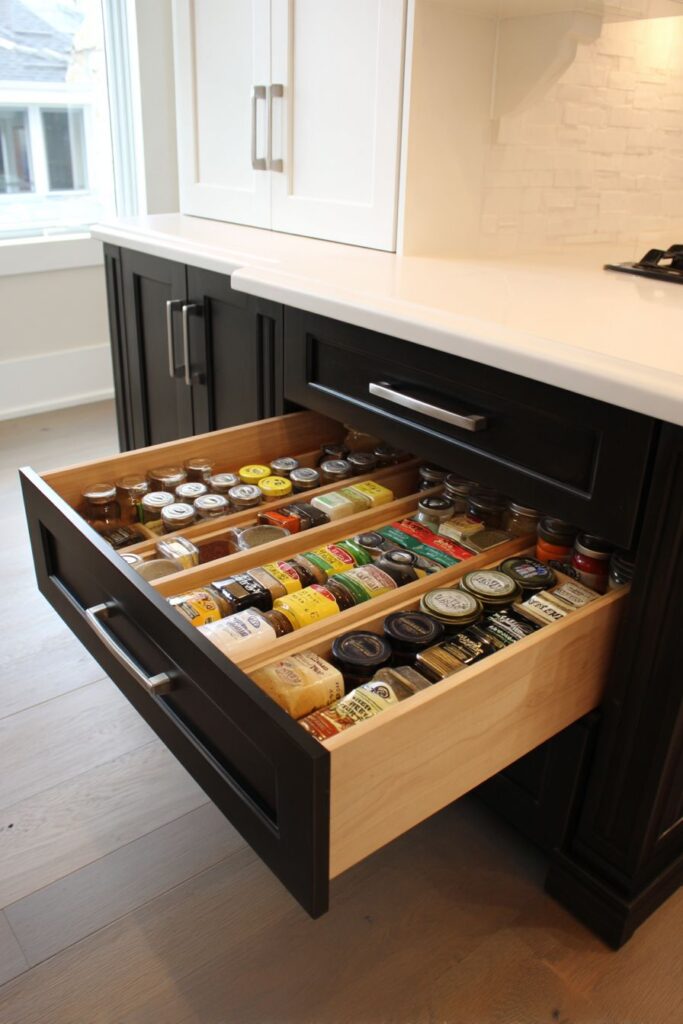
Custom craftsmanship allows for accommodation of specific container sizes and shapes, creating storage that works with preferred spice brands rather than forcing adaptation to generic solutions. This personalized approach maximizes storage efficiency while providing the convenience of purpose-built organization. The precision fit ensures containers remain secure during drawer operation while maintaining easy access.
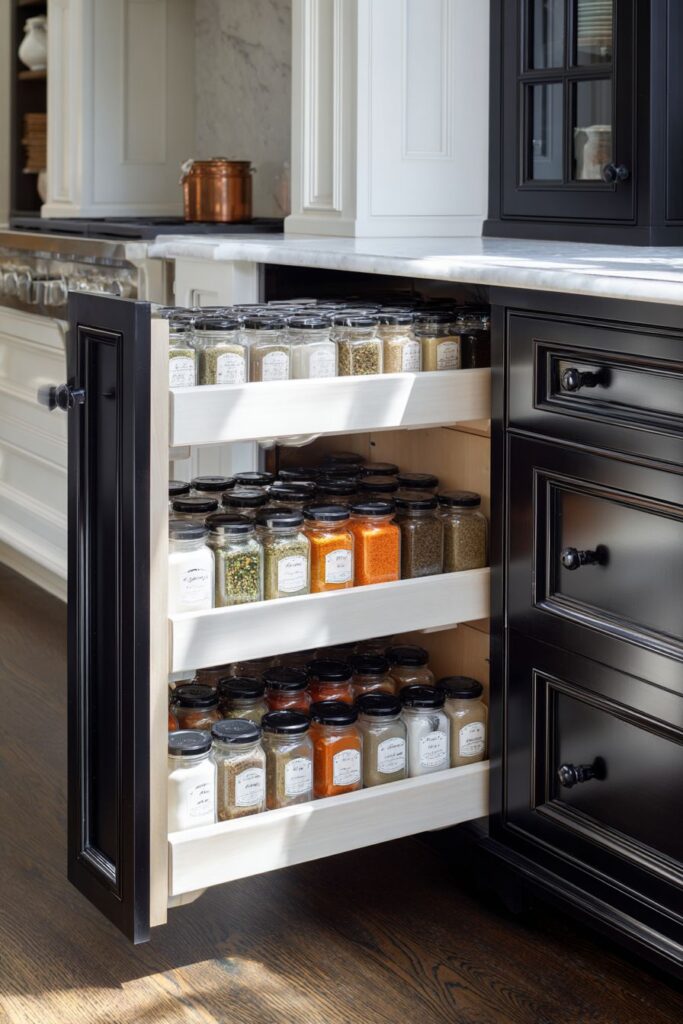
Natural lighting reveals thoughtful organization and quality construction details that distinguish custom work from standard solutions. The bright white interior surfaces reflect available light, making it easy to read labels and assess quantities even in less-than-ideal lighting conditions. This attention to functionality demonstrates how custom solutions can dramatically improve daily cooking experiences.
High-end kitchen storage solutions like these represent significant investments in both materials and craftsmanship, but provide long-term value through superior functionality and integration with overall kitchen design. The seamless appearance and perfect fit justify the expense through enhanced daily use and property value.
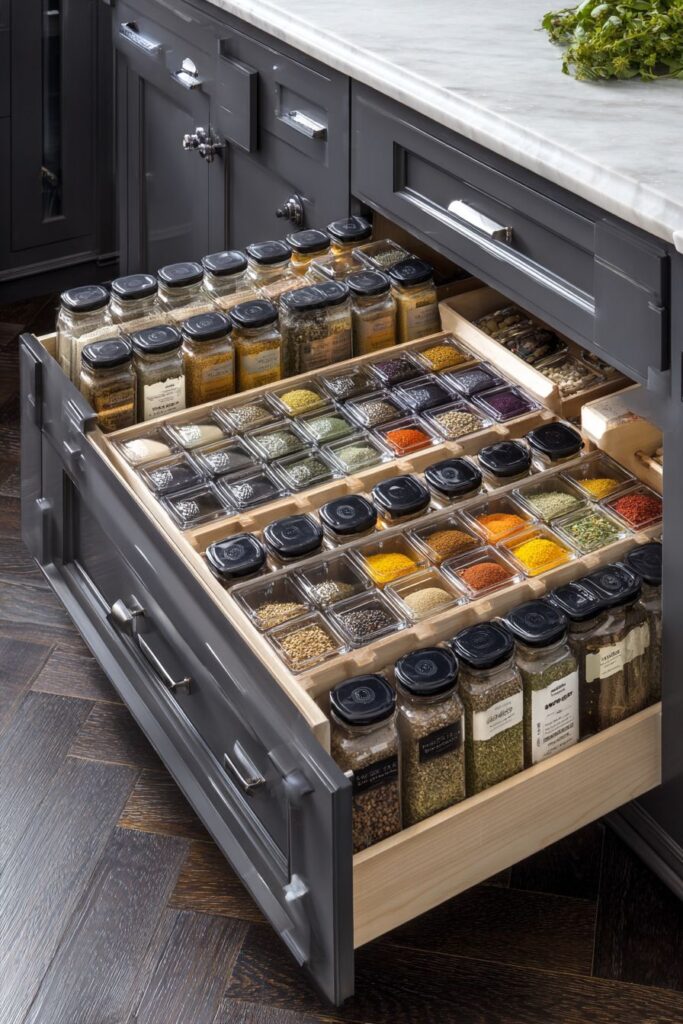
Key Design Tips:
- Work with experienced cabinet makers who understand precise fitting requirements
- Choose high-quality drawer slides rated for the weight of filled spice containers
- Plan compartment sizes based on actual spice container dimensions
- Use light interior colors to enhance visibility and create brightness
- Consider future needs when planning compartment sizes and configurations
11. Bohemian Woven Rattan Display
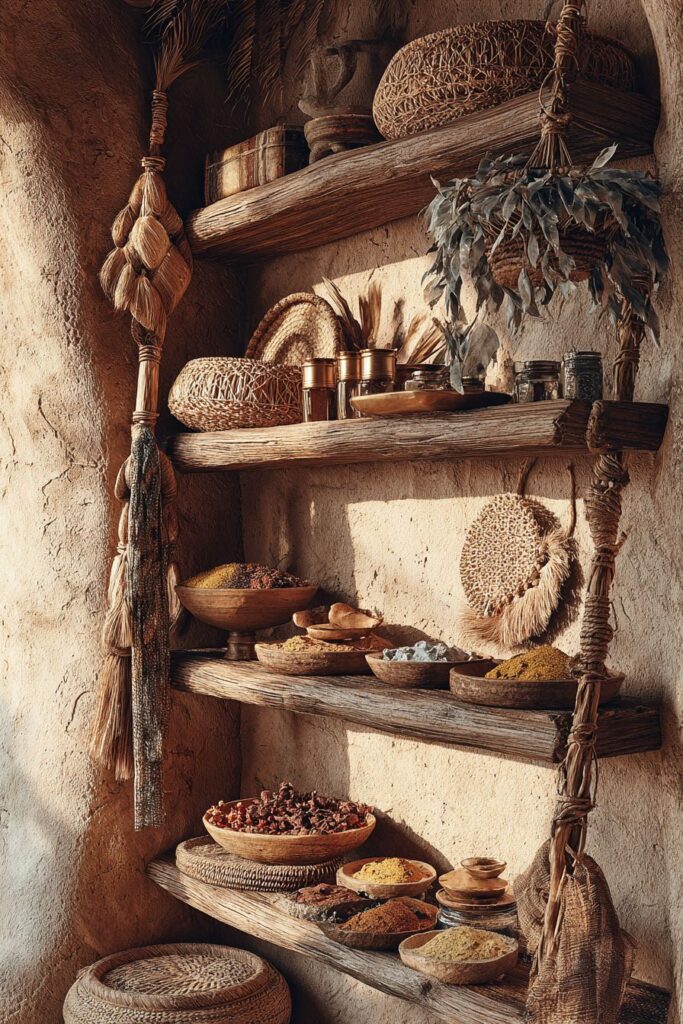
Artistic spice storage embraces global influences through woven rattan baskets and vintage brass containers arranged on natural wood open shelving. This approach celebrates cultural diversity and handcrafted beauty, where each element tells stories of traditional craftsmanship and global trade routes. Colorful spice blends create vibrant displays against textured plaster walls painted in warm terracotta, evoking Mediterranean and North African design influences.
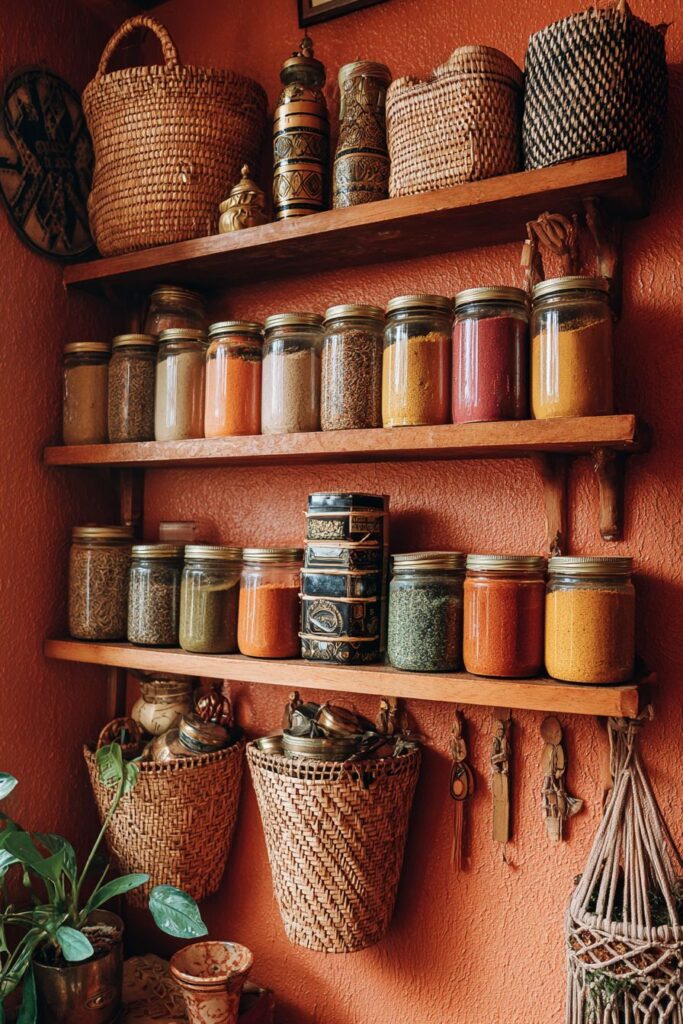
Rattan basketry introduces organic textures that soften hard kitchen surfaces while providing flexible storage that adapts to various container shapes and sizes. The natural material ages beautifully, developing patina that adds character over time. Vintage brass containers contribute metallic accents that catch light while honoring traditional spice storage methods used across cultures.
Macrame plant holders and other textile elements reinforce the bohemian aesthetic while adding vertical interest that draws the eye upward. This layered approach to decoration creates visual richness that rewards close examination while maintaining overall coherence through consistent natural materials and warm color palettes.
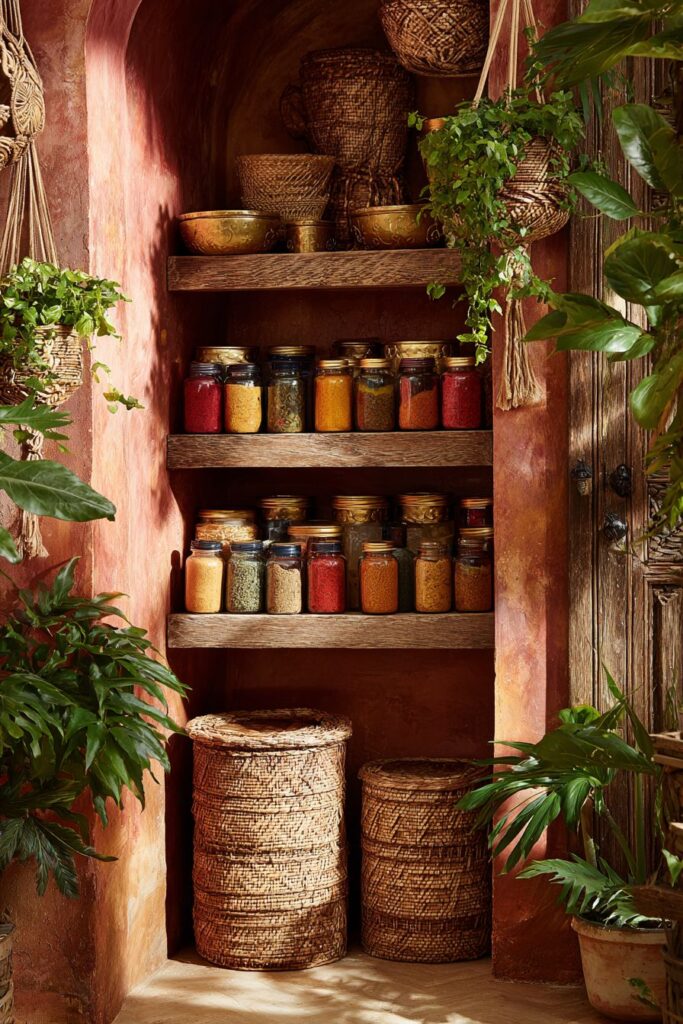
Soft natural lighting enhances organic materials and cultural artifacts, creating an atmosphere that celebrates the global nature of cooking and spice trading. This approach particularly appeals to those who view cooking as cultural exploration and ingredient sourcing as artistic curation.
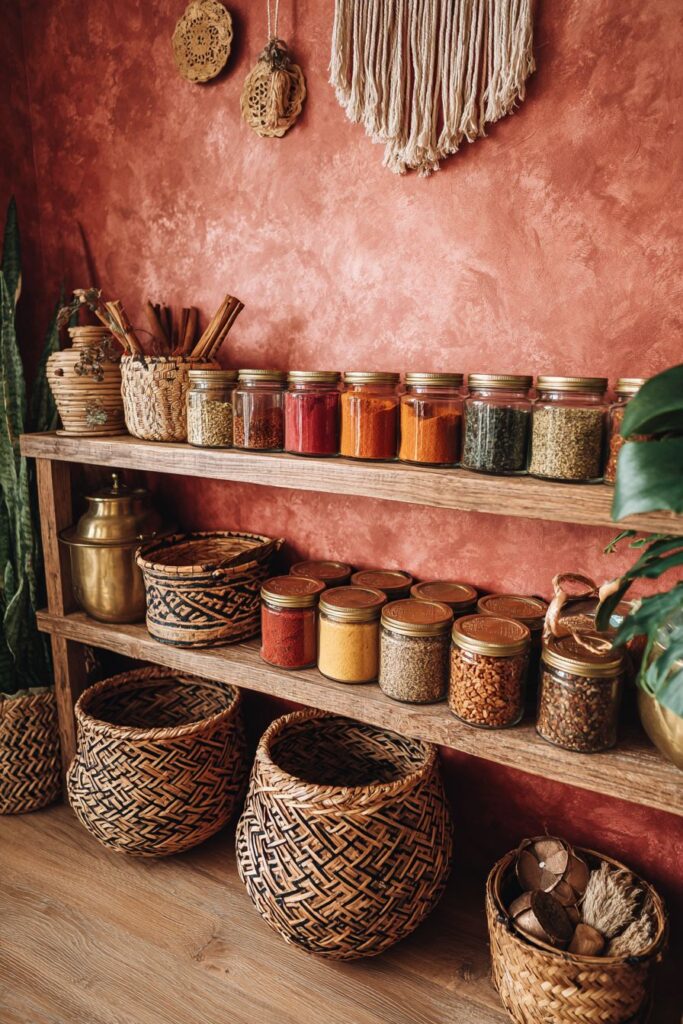
Key Design Tips:
- Mix textures and materials from various cultural traditions for authentic diversity
- Choose warm, earthy colors that complement natural material tones
- Balance organized storage with artistic display for both function and beauty
- Incorporate plants and textiles to soften hard surfaces and add life
- Group similar items while maintaining visual variety through mixed materials
12. Mediterranean Ceramic Artistry
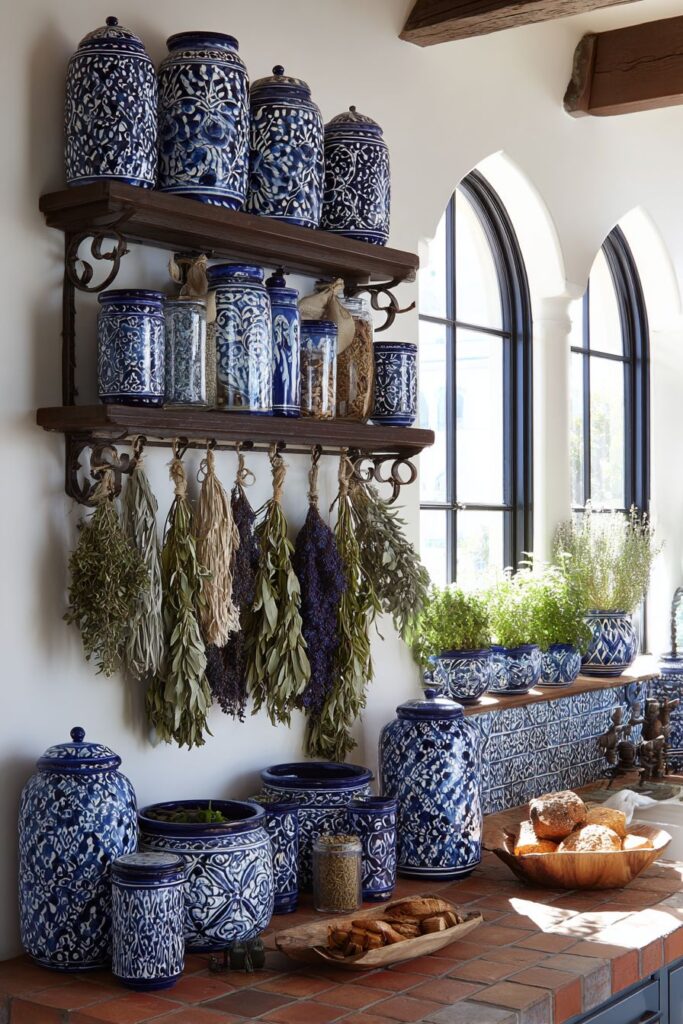
Hand-painted ceramic containers in traditional blue and white patterns transform spice storage into cultural celebration through wrought iron wall-mounted shelving. This approach honors Mediterranean craftsmanship while providing practical storage that reflects regional cooking traditions and ingredient preferences. Terra cotta tiles provide warm backdrops that complement ceramic patterns while dried herbs hanging in bundles add authentic culinary atmosphere.
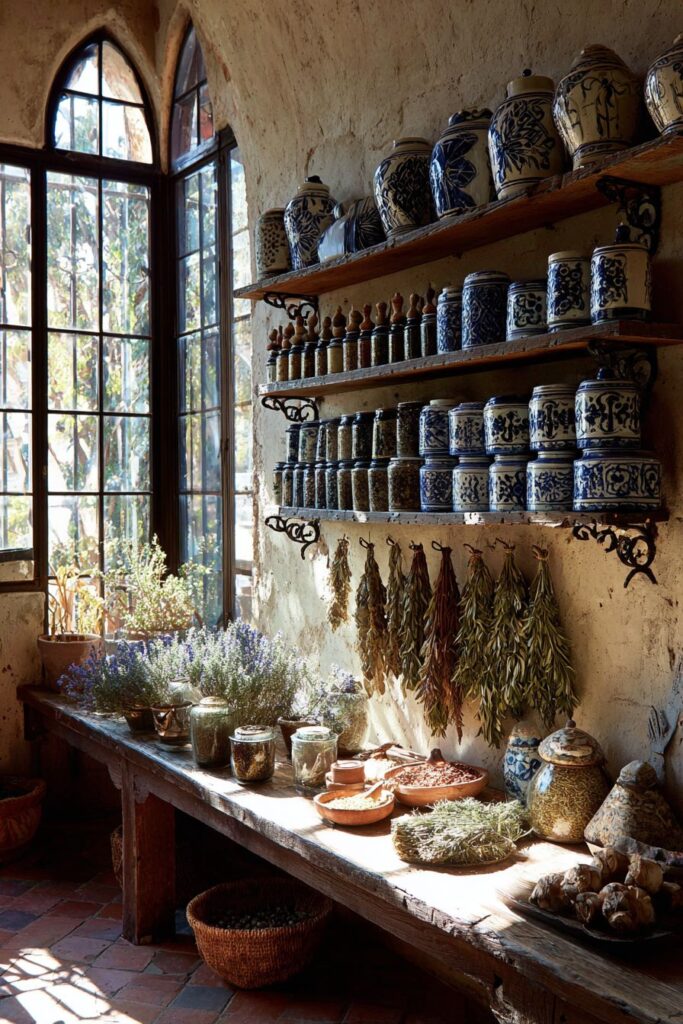
Artisanal pottery introduces unique character through slight variations in painting and glazing that distinguish handmade pieces from mass-produced alternatives. Blue and white patterns connect to centuries of ceramic tradition while providing timeless beauty that transcends design trends. Each container becomes a small work of art that contributes to the overall kitchen aesthetic.
Natural sunlight streaming through arched windows creates a beautiful interplay between light and ceramic glazes, highlighting painting details while casting interesting shadows on textured wall surfaces. This changing light quality adds dynamic visual interest throughout the day while reinforcing the Mediterranean connection to outdoor living and natural illumination.
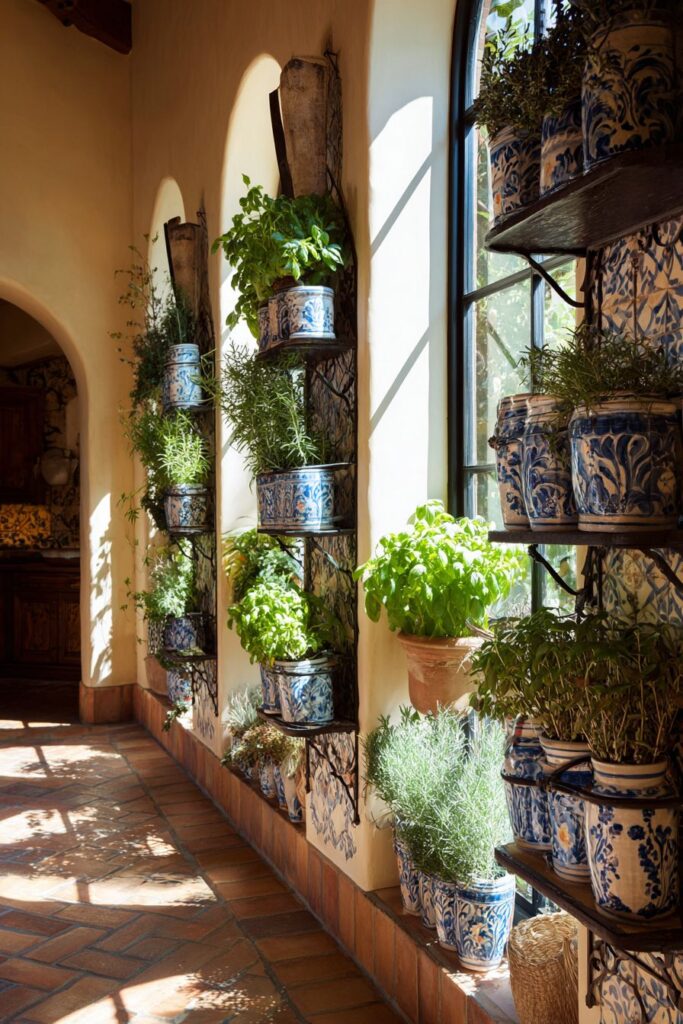
Wrought iron shelving provides sturdy support while contributing authentic metalwork that complements ceramic artistry. The combination of materials – ceramic, metal, and natural stone – creates textural richness characteristic of Mediterranean design while providing practical storage solutions.
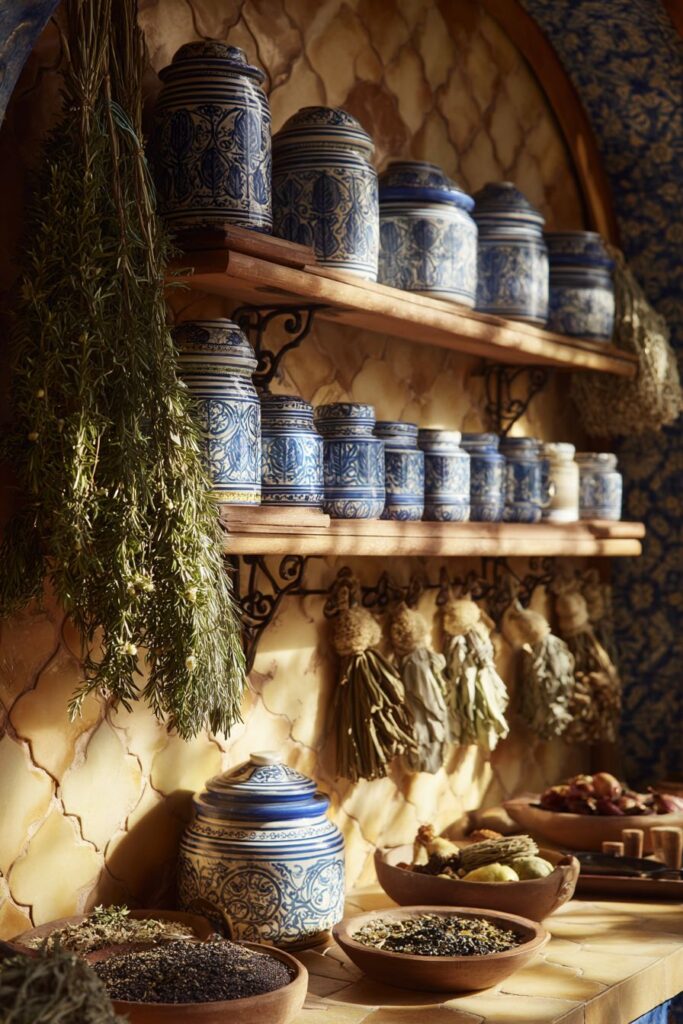
Key Design Tips:
- Source authentic handmade ceramics for genuine character and quality
- Choose patterns and colors that coordinate without being overly matched
- Install wrought iron hardware that complements rather than competes with the ceramic beauty
- Consider ceramic durability when selecting pieces for daily use
- Group containers by size and pattern for an organized visual impact
13. Sliding Barn Door Farmhouse Charm
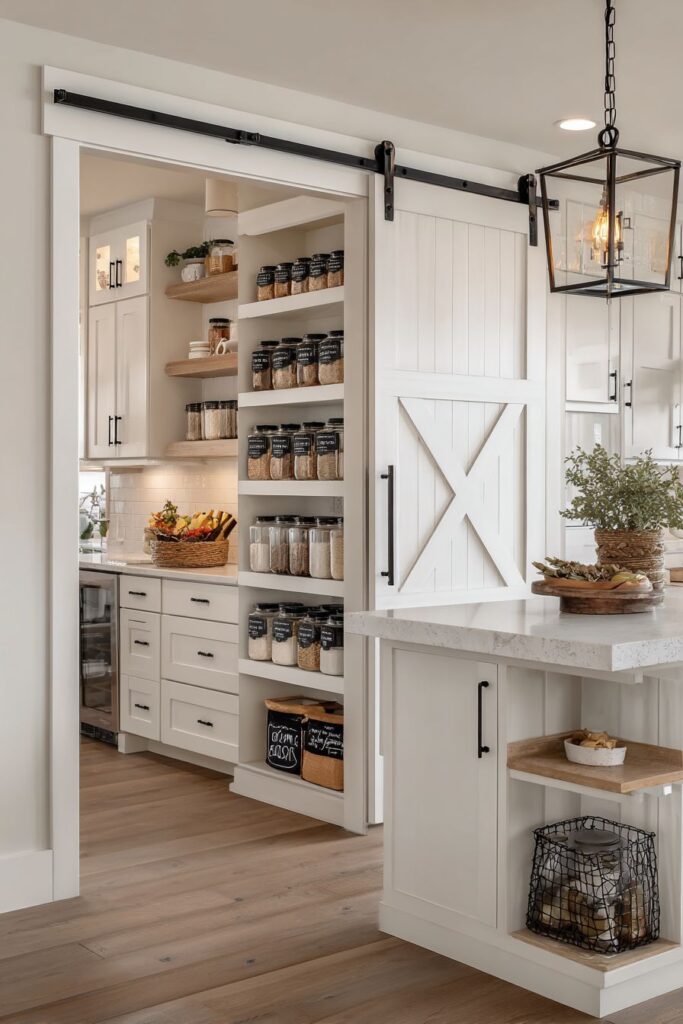
Modern farmhouse aesthetics shine through sliding barn door cabinets revealing organized rows of mason jars with chalkboard labels. This approach combines rustic materials with contemporary functionality, where distressed white wood construction includes chicken wire inserts that add authentic rural touches while providing ventilation. The sliding door mechanism saves space while creating dramatic reveals that make accessing spices feel special.
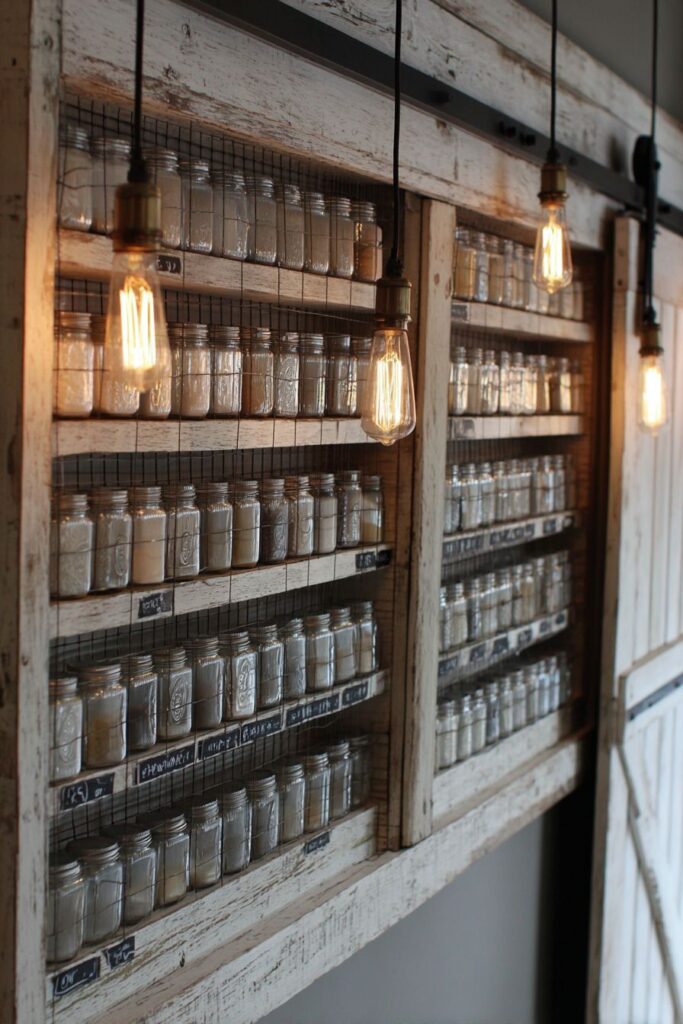
Mason jar storage honors traditional preservation methods while providing excellent airtight storage for maintaining spice freshness. Chalkboard labels allow for easy updating as spice collections change, eliminating the waste of permanent labeling systems while adding handwritten character that reinforces farmhouse authenticity. The ability to change labels encourages experimentation with new spices and blends.
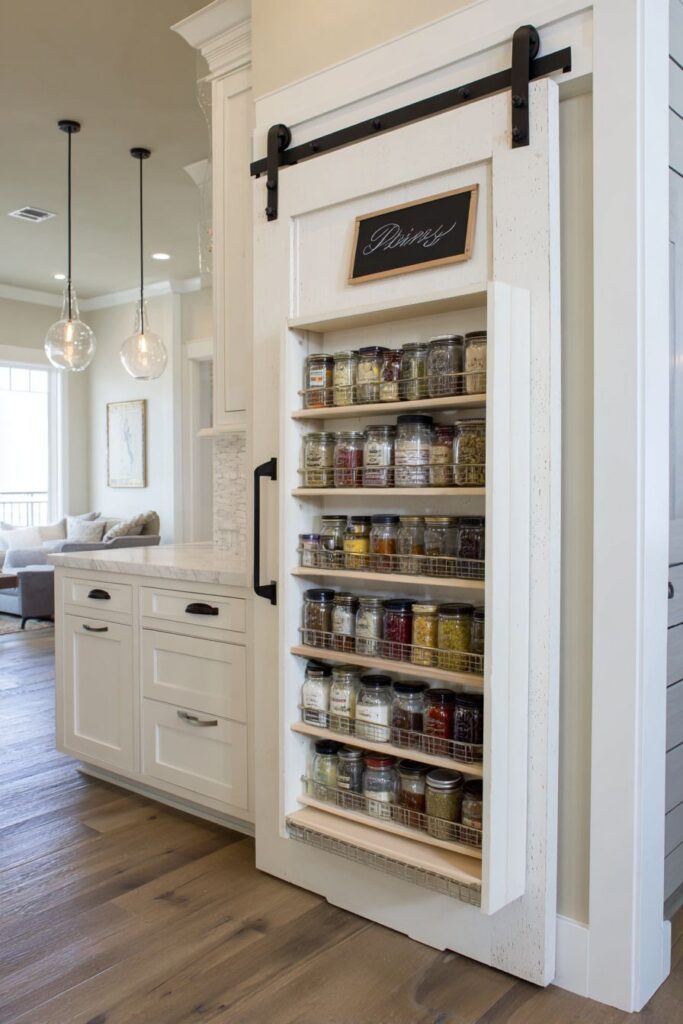
Edison bulb pendant lighting reinforces the farmhouse aesthetic while providing practical illumination that highlights jar contents and label details. This lighting choice creates warm, inviting atmosphere that makes the kitchen feel welcoming and lived-in rather than formal or sterile. The combination of materials and lighting creates cohesive design themes that extend throughout farmhouse-style kitchens.
Distressed finishes and deliberately aged materials celebrate imperfection and use, suggesting kitchens that have served families for generations. This approach appeals to those who value tradition and authenticity over pristine perfection, creating spaces that feel comfortable and approachable.
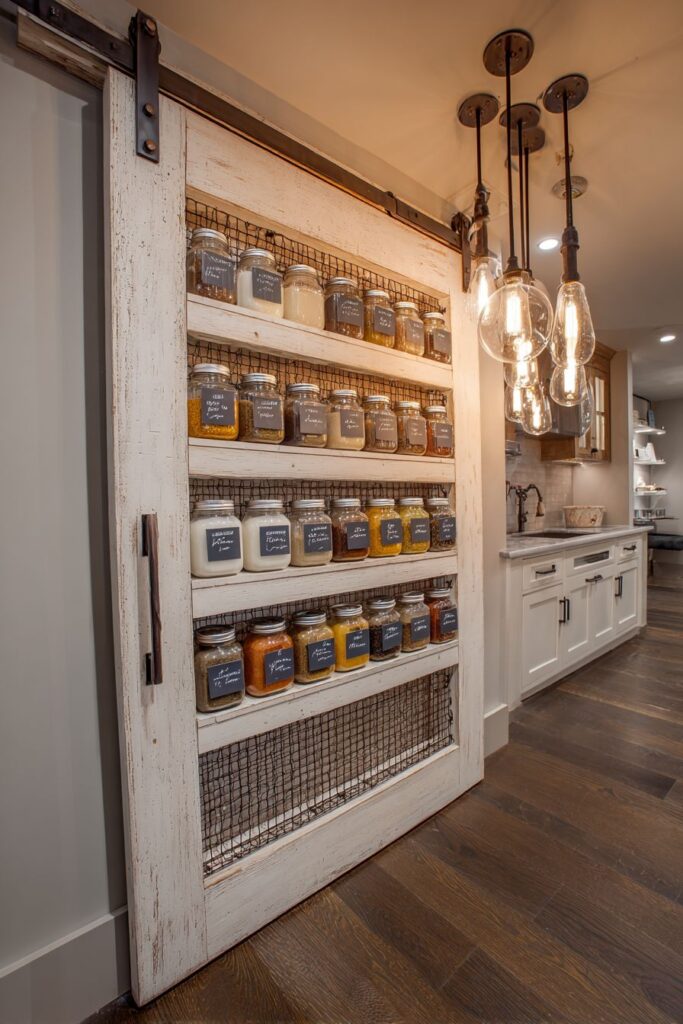
Key Design Tips:
- Choose sliding hardware that operates smoothly while maintaining rustic appearance
- Apply distressing techniques consistently for authentic aged appearance
- Use standard mason jar sizes for consistent visual rhythm and practical storage
- Install adequate lighting to highlight contents and enhance functionality
- Consider ventilation needs when adding chicken wire or other decorative elements
14. Compact Door-Mounted Efficiency
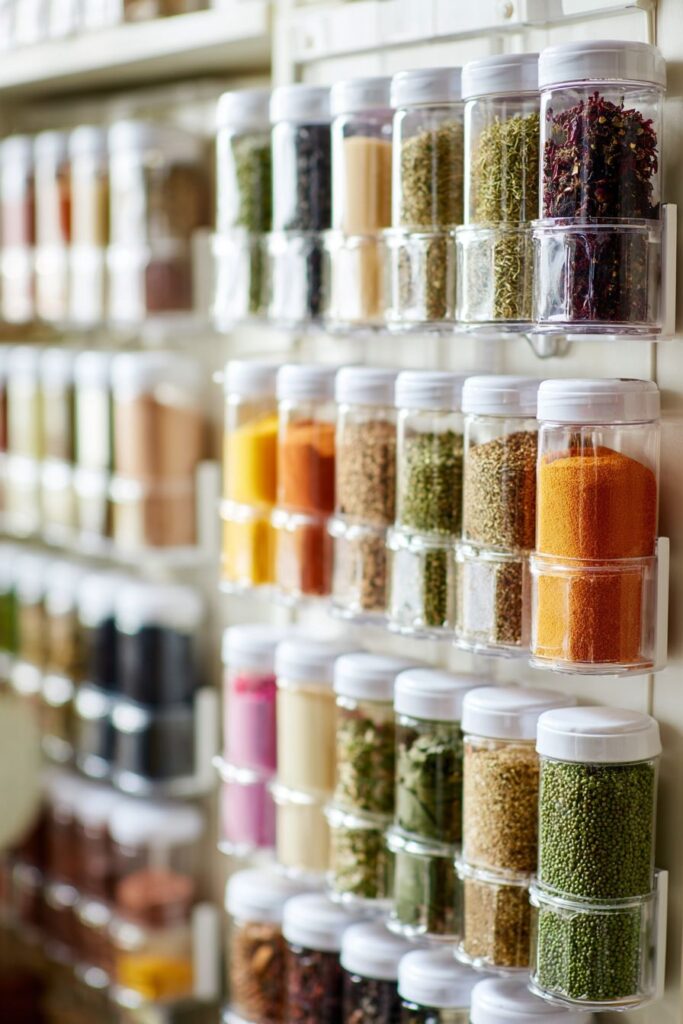
Apartment living requires creative solutions that maximize every available inch, demonstrated through narrow cabinet door-mounted systems with adjustable shelves. Clear plastic containers with flip-top lids provide space-efficient storage while maintaining easy identification of contents through transparent walls. This approach transforms often-wasted door space into valuable storage real estate.
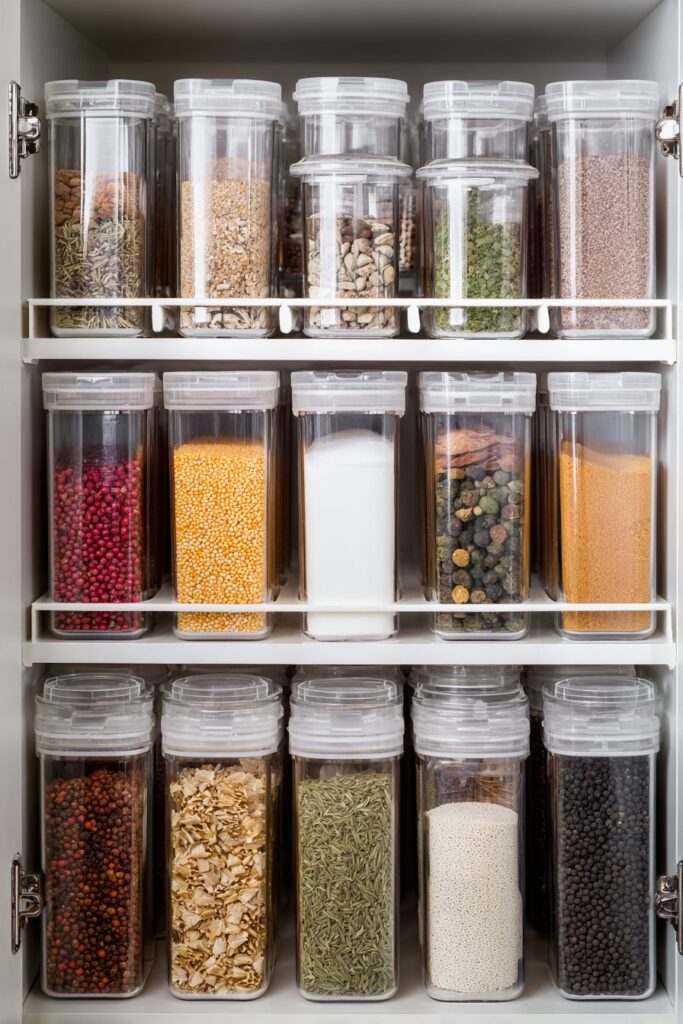
The narrow profile accommodates standard cabinet door dimensions while providing surprising storage capacity through vertical organization. Adjustable shelves allow for customization based on container sizes and personal preferences, ensuring optimal space utilization. White interior surfaces reflect overhead lighting, creating brightness that makes the confined space feel larger and more open.
Flip-top lids provide easy access during cooking while maintaining airtight storage that preserves spice quality. The one-handed operation suits busy cooking environments where efficiency matters more than aesthetics. Clear containers eliminate guesswork while allowing for quick visual inventory of remaining quantities.
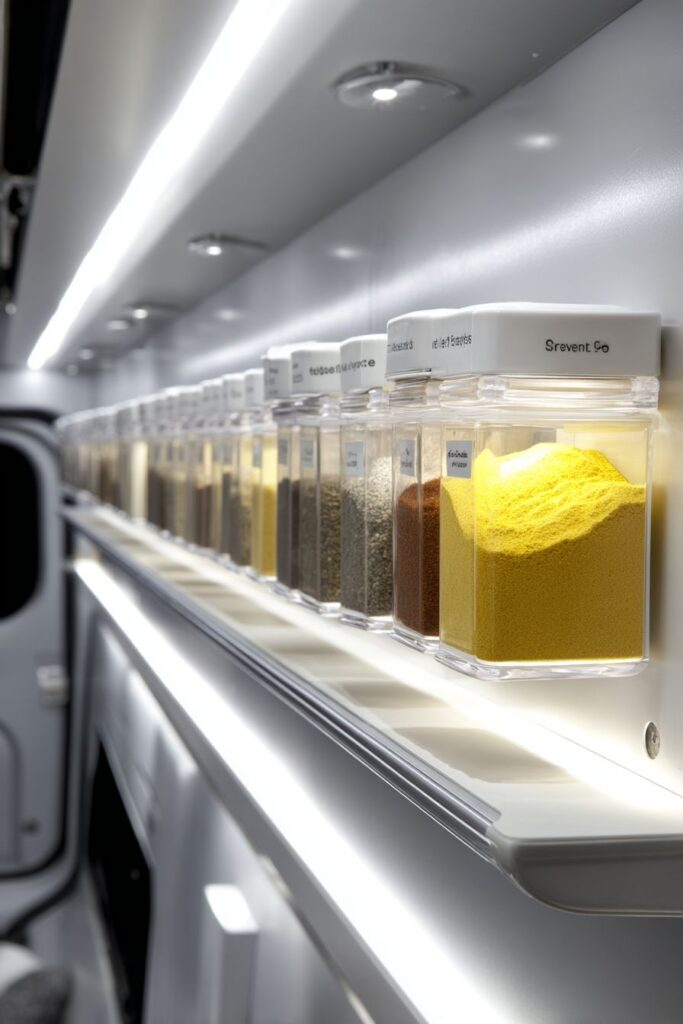
Detail photography emphasizes space-efficient design principles that make the most of limited square footage without sacrificing functionality. This approach particularly benefits urban dwellers who must balance storage needs with spatial constraints while maintaining organized, efficient kitchens.
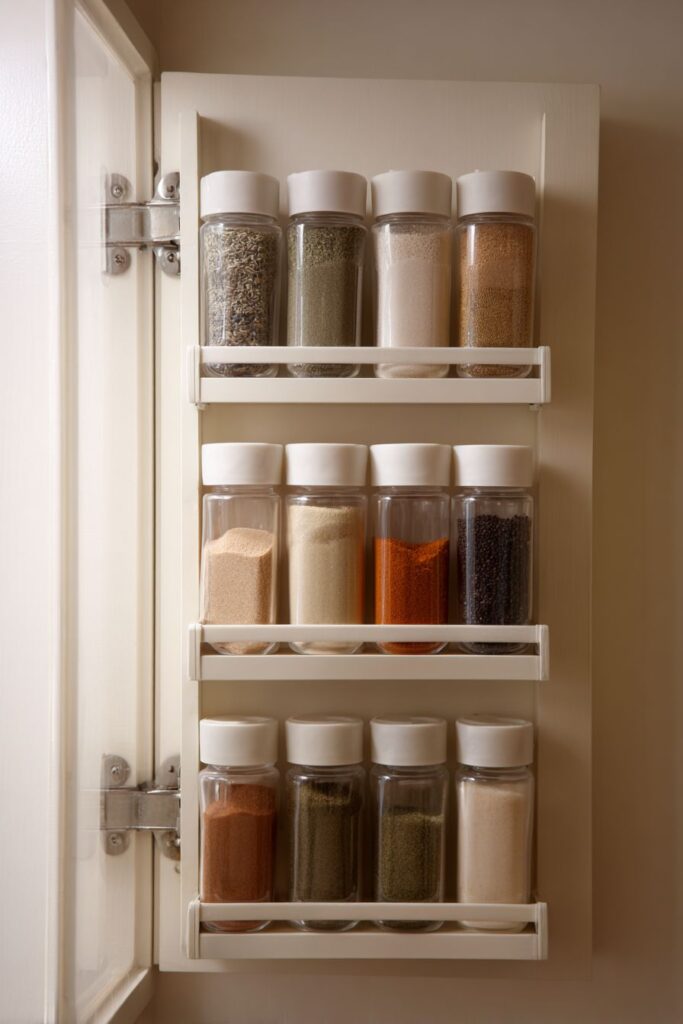
Key Design Tips:
- Choose lightweight containers to avoid stressing door hinges with excessive weight
- Install adjustable shelving to accommodate various container heights
- Select containers with secure closures that won’t open accidentally during door movement
- Use light interior colors and finishes to maximize reflected light
- Consider door swing patterns to ensure the system doesn’t interfere with normal operation
15. Professional Chef-Worthy Luxury
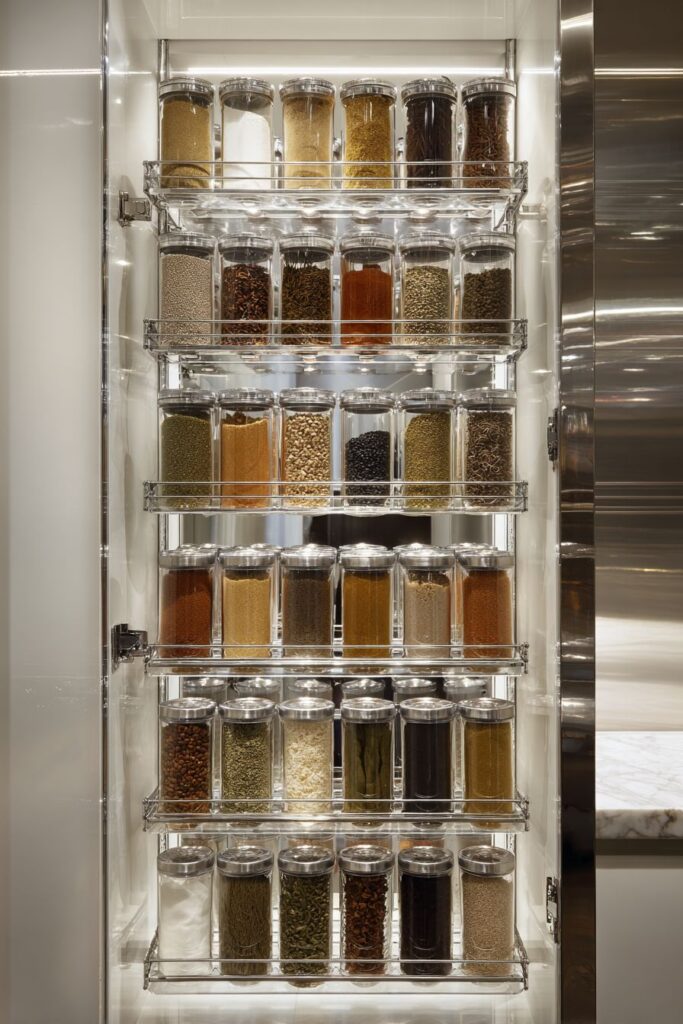
High-end culinary storage reaches new sophistication through temperature-controlled display cabinets with LED lighting and individual compartments for premium spice collections. Glass shelving and stainless steel construction create restaurant-quality storage solutions that bring professional functionality to home kitchens. These systems represent the ultimate in spice preservation and organization for serious cooking enthusiasts.
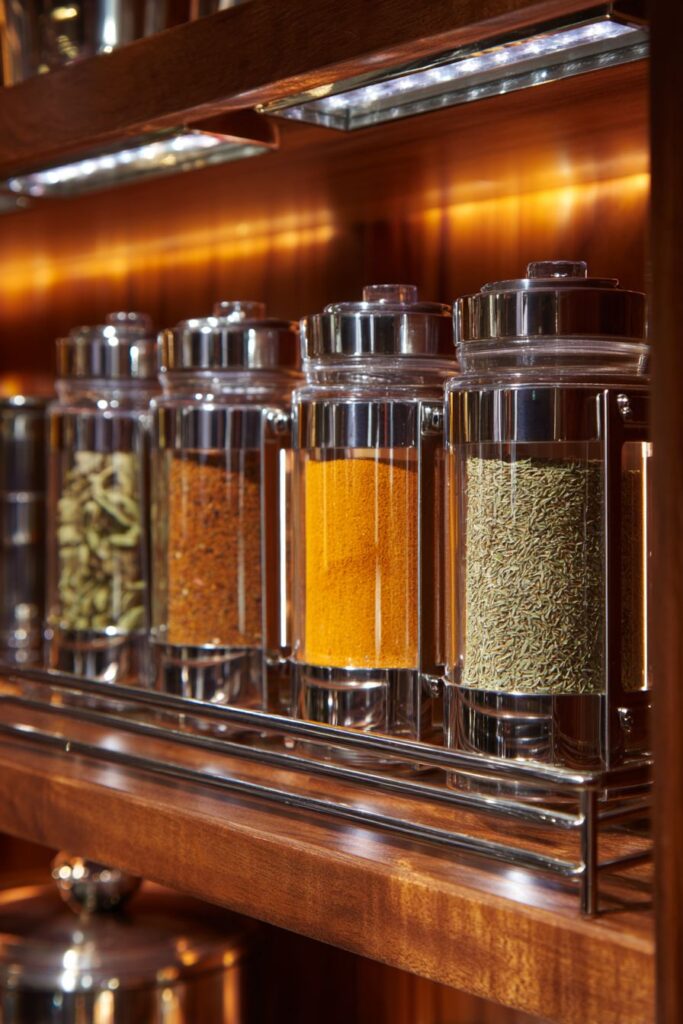
Temperature control ensures optimal storage conditions for expensive and delicate spices, preserving flavors and potency that justify premium ingredient investments. Individual compartments prevent cross-contamination while providing precise organization that facilitates efficient cooking workflows. The investment in quality storage protects valuable spice collections while enhancing their presentation.
LED lighting systems provide consistent, cool illumination that showcases spice colors without generating heat that could damage sensitive ingredients. Glass shelving creates clean, professional appearance while allowing light to reach all storage levels equally. Hidden hinges and soft-close mechanisms demonstrate attention to detail characteristic of luxury applications.
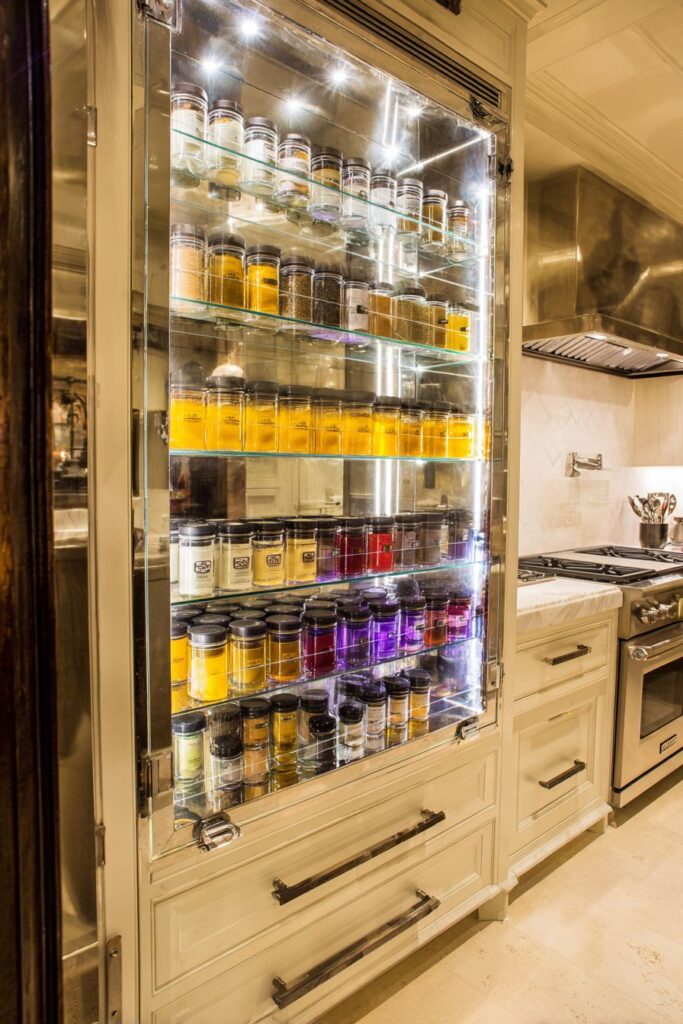
Integration with high-end kitchen cabinetry requires precise planning and installation, but results in seamless appearance that justifies the investment through both functionality and aesthetic contribution. This approach appeals to serious cooks who view spice storage as kitchen infrastructure worthy of significant investment.
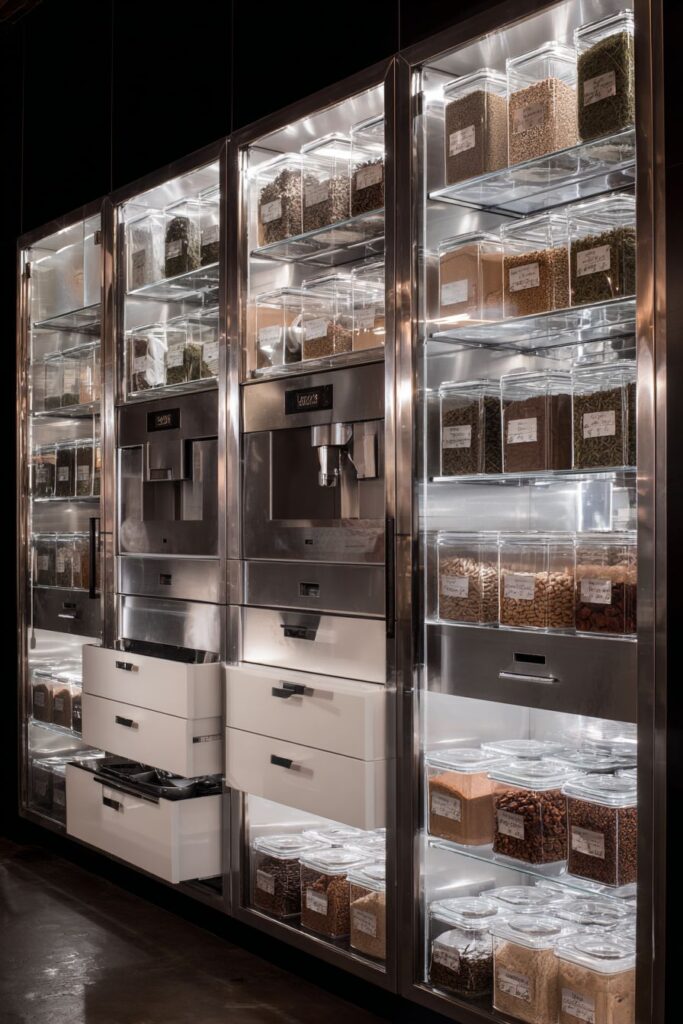
Key Design Tips:
- Invest in professional-grade temperature control systems designed for food storage
- Choose LED lighting with appropriate color temperature for accurate spice color representation
- Plan electrical requirements early in kitchen design process for proper integration
- Select glass and metal finishes that complement other kitchen hardware and appliances
- Consider professional installation to ensure proper operation and warranty protection
16. Vintage Apothecary Cabinet Nostalgia
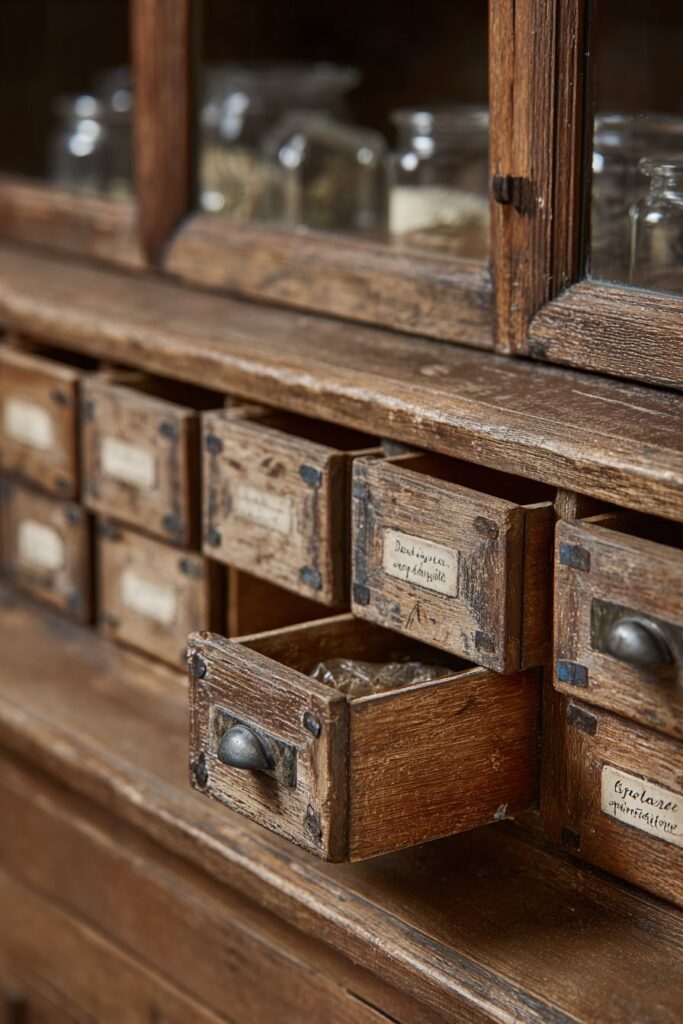
Historical charm emanates from antique apothecary cabinets featuring small glass-front drawers with handwritten labels that celebrate culinary tradition. Aged brass hardware and weathered wood finishes tell stories of generations past while providing efficient organization that has satisfied cooks throughout history. Natural patina and gentle wear patterns add authenticity that cannot be manufactured.
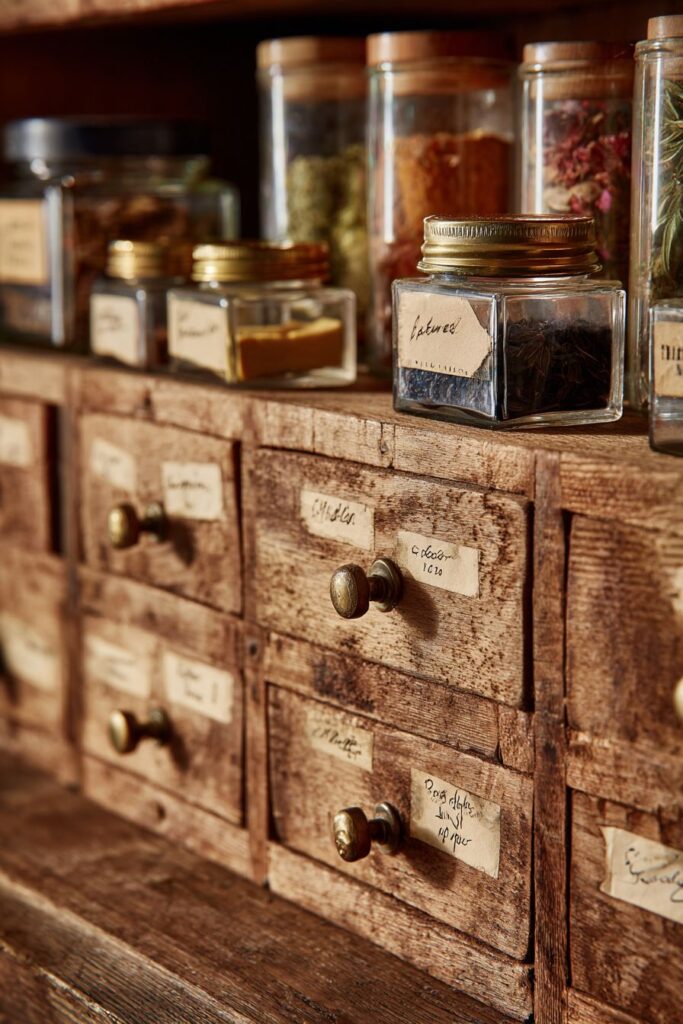
Individual glass-front drawers provide optimal storage conditions while allowing visual identification of contents without opening containers. This design maximizes freshness by minimizing air exposure while maintaining the convenience of visual inventory. Handwritten labels add personal character while honoring traditional labeling methods that predate modern printing.
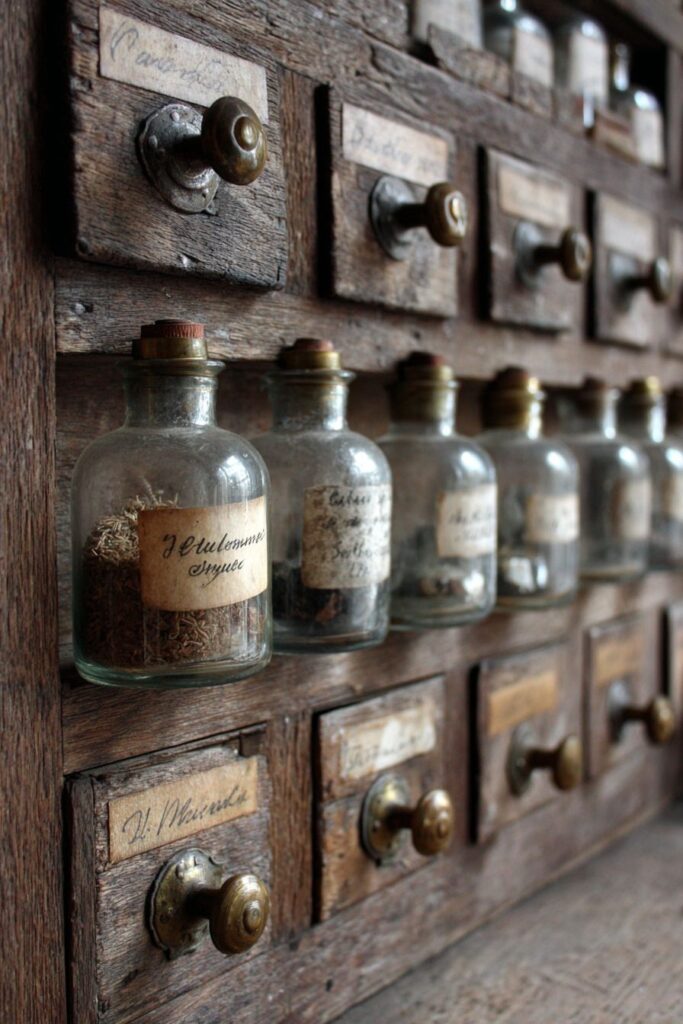
The aged brass hardware develops beautiful patina over time, creating surfaces that reflect light softly while contributing to the overall vintage aesthetic. Quality construction ensures these pieces continue functioning for decades while developing character that adds value over time. The investment in authentic antiques provides both practical storage and historical connection.
Soft lighting creates warm reflections on glass surfaces while highlighting wood grain and metal patina details. This gentle illumination reinforces the historical atmosphere while providing adequate visibility for practical use. The combination of materials creates textural richness that invites closer examination and appreciation.
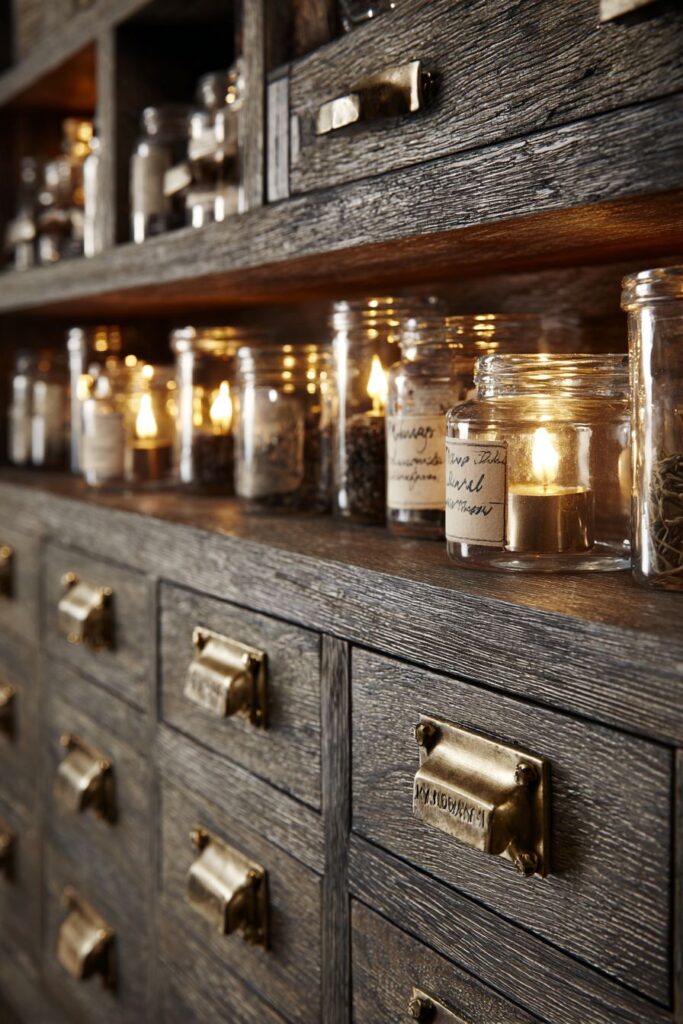
Key Design Tips:
- Source authentic antique pieces with original hardware and construction details
- Verify drawer operation and glass condition before purchase
- Plan for appropriate lighting to highlight cabinet details and contents
- Consider professional restoration if needed to ensure functionality
- Research historical context to appreciate craftsmanship and design evolution
17. Open Concept LED-Illuminated Display
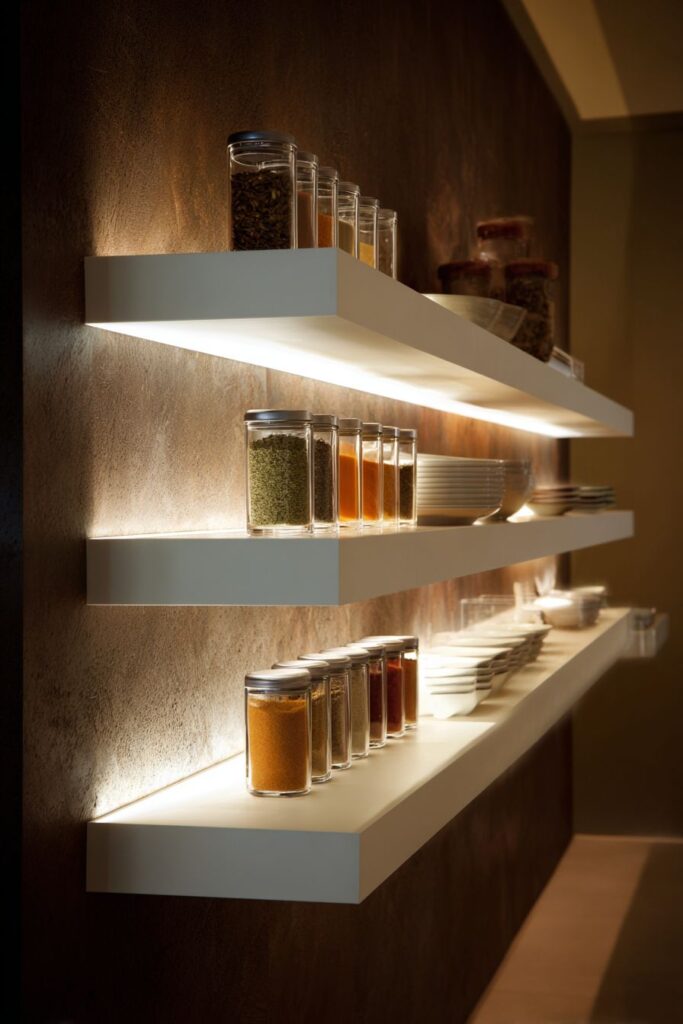
Dramatic lighting transforms spice storage into architectural features through floating shelves with built-in LED strip lighting, showcasing colorful spices in matching clear containers. Clean white shelving creates striking contrast against dark accent walls while providing easy access during cooking. This approach demonstrates how proper lighting can elevate utilitarian storage into design statements.
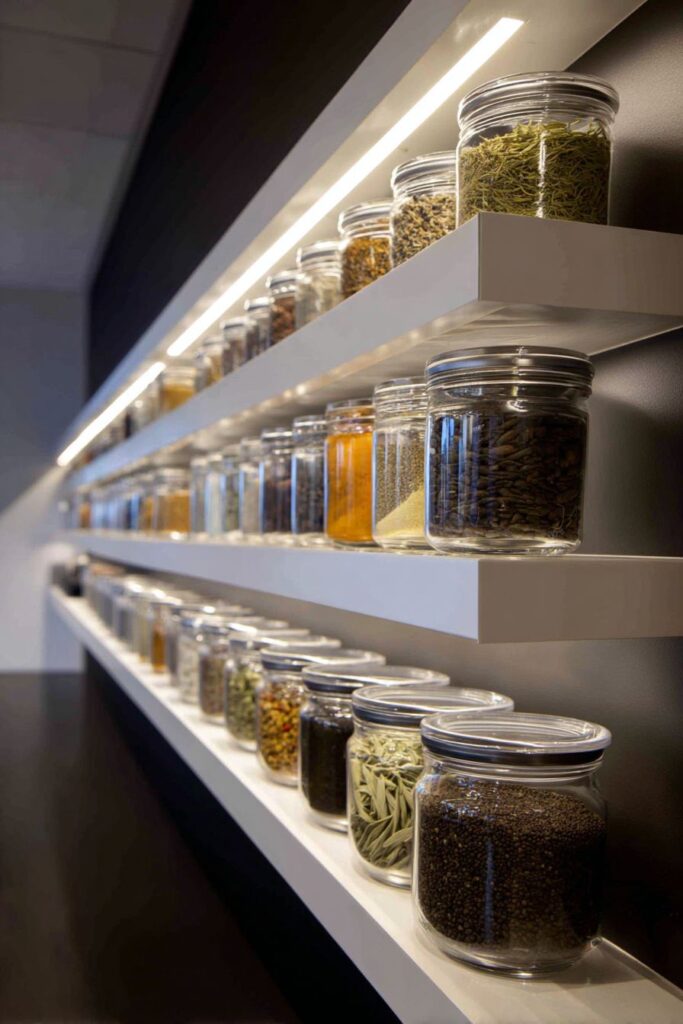
Built-in LED strips provide consistent, even illumination that highlights spice colors while creating dramatic visual impact that changes the character of the entire kitchen space. The clean white shelving disappears visually, allowing illuminated spices to appear to float against dark backgrounds. This lighting technique creates depth and dimension that adds architectural interest to flat wall surfaces.
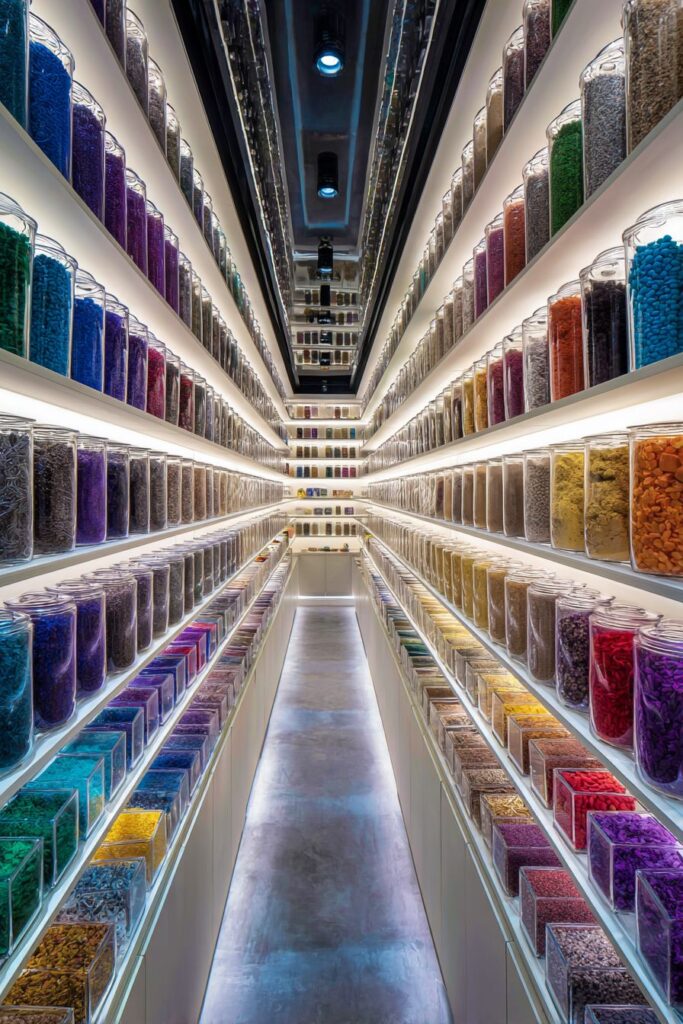
Wide-angle photography captures how strategic lighting creates focal points that draw attention while providing practical functionality. The organized display becomes artwork that celebrates the beauty of cooking ingredients while maintaining easy access for daily use. This approach particularly suits contemporary kitchens where storage becomes part of the overall design narrative.
The contrast between light shelving and dark walls creates sophisticated color palettes that work with various kitchen design themes while providing flexibility for future changes. LED technology ensures efficient operation with minimal heat generation that won’t affect spice quality.
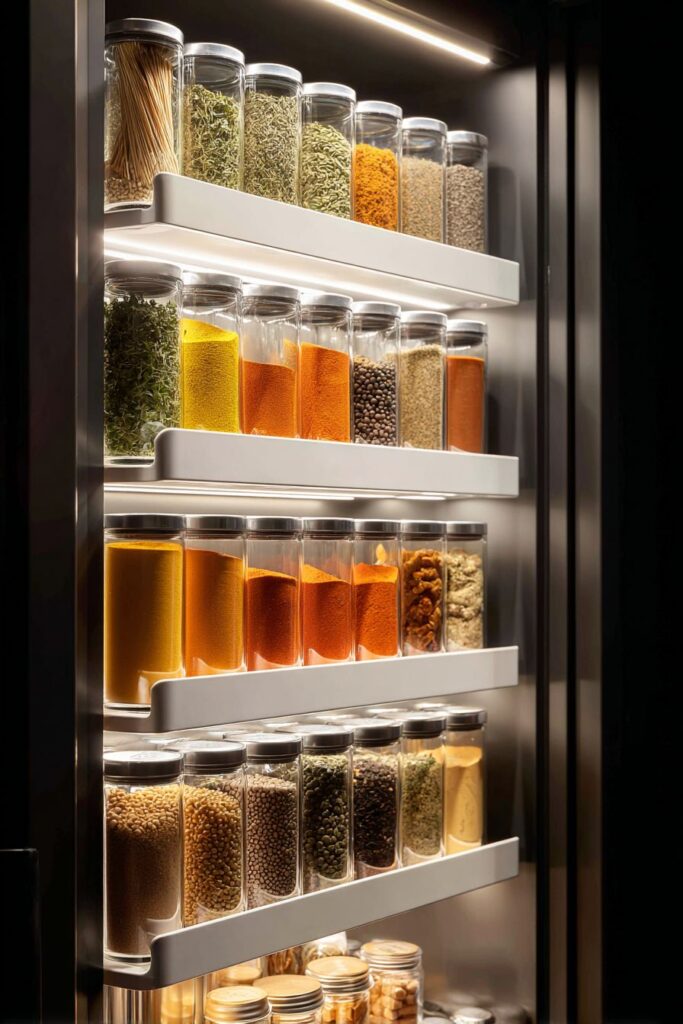
Key Design Tips:
- Choose LED strips with appropriate color temperature for accurate spice color representation
- Plan electrical rough-in during construction for clean, professional installation
- Use timer controls or dimmer switches to manage energy consumption and ambiance
- Select contrast wall colors that enhance rather than compete with illuminated displays
- Consider heat generation and ventilation requirements for enclosed LED installations
18. Coastal Driftwood Serenity
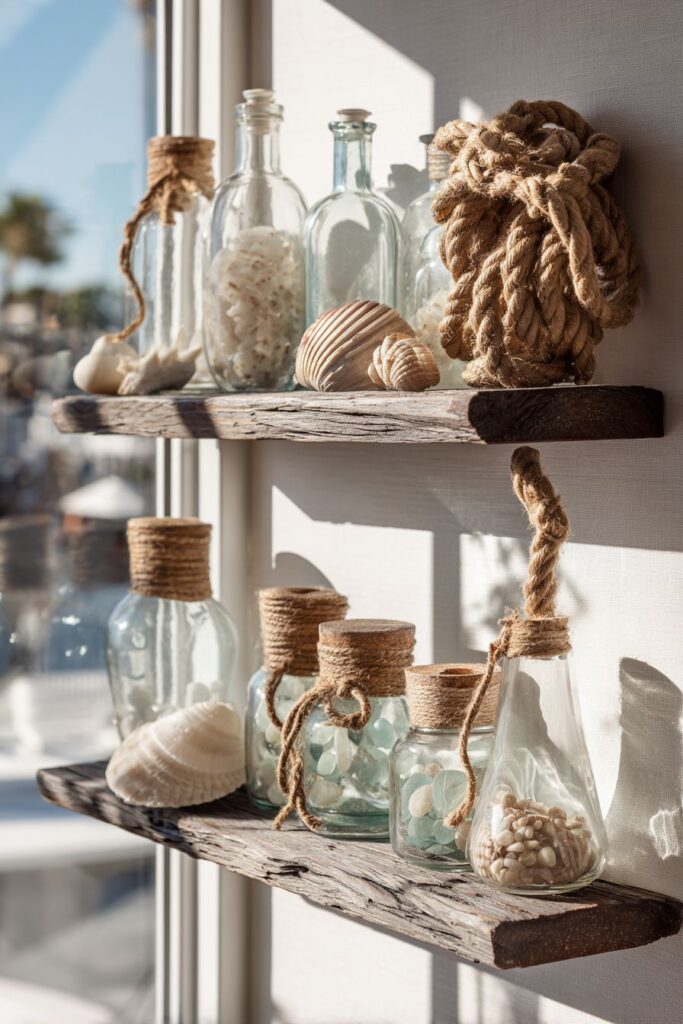
Ocean-inspired storage embraces natural materials through driftwood shelving and sea glass containers that create beachy vibes in white kitchen environments. Natural rope details and weathered wood finishes evoke seaside living while providing practical storage that celebrates coastal design principles. This approach transforms spice organization into reminders of ocean breezes and beach walks.
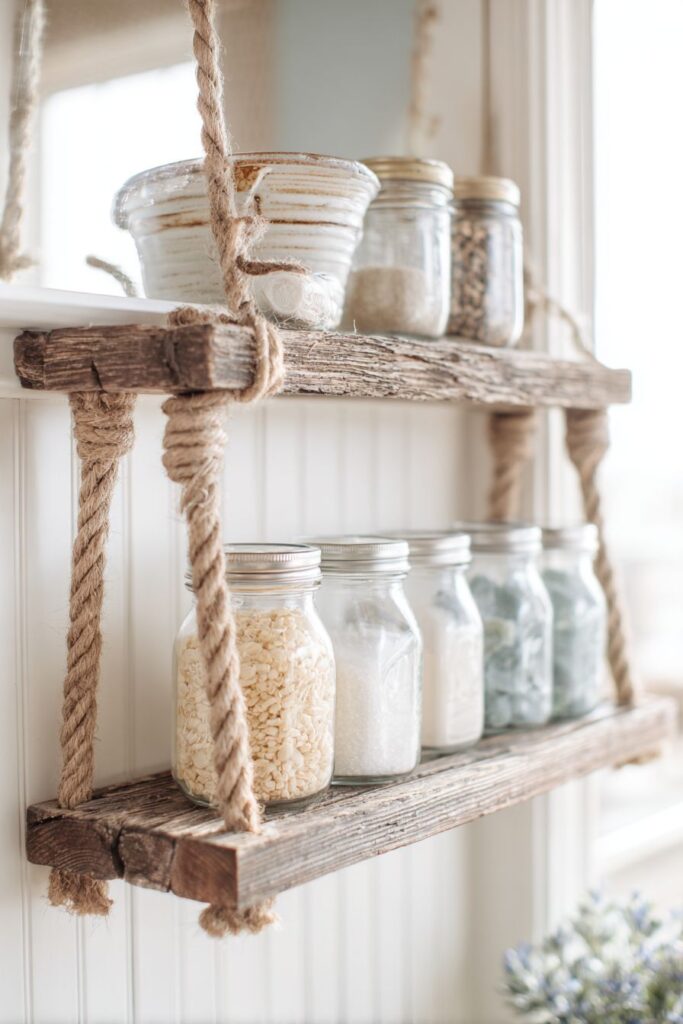
Driftwood’s natural weathering creates unique grain patterns and surface textures that tell stories of ocean tumbling and salt air seasoning. Each piece differs slightly, providing organic variation that contrasts beautifully with uniform sea glass containers. The natural materials age gracefully, developing character that adds value over time.
Sea glass containers in various blue and green tones create soothing color palettes that reinforce coastal themes while providing practical storage with excellent visibility of contents. The translucent quality of sea glass creates gentle light diffusion that adds softness to kitchen environments while maintaining clear identification of spices.
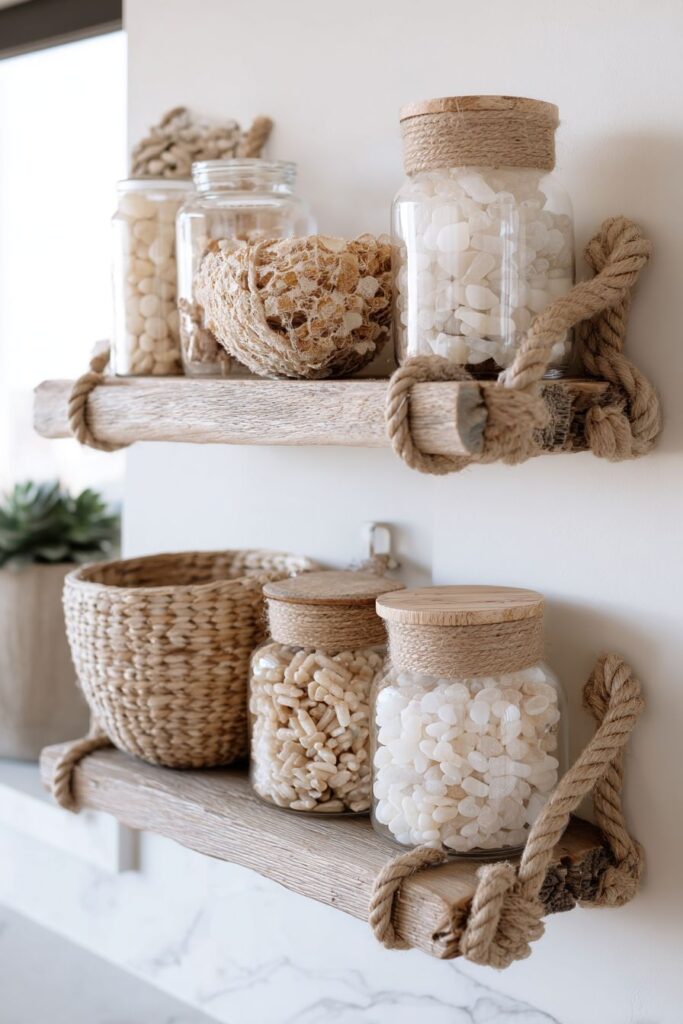
Soft natural lighting mimics ocean environments while highlighting organic textures and relaxed coastal aesthetics. This gentle illumination creates a calming atmosphere that reduces cooking stress while celebrating the connection between food preparation and natural environments.
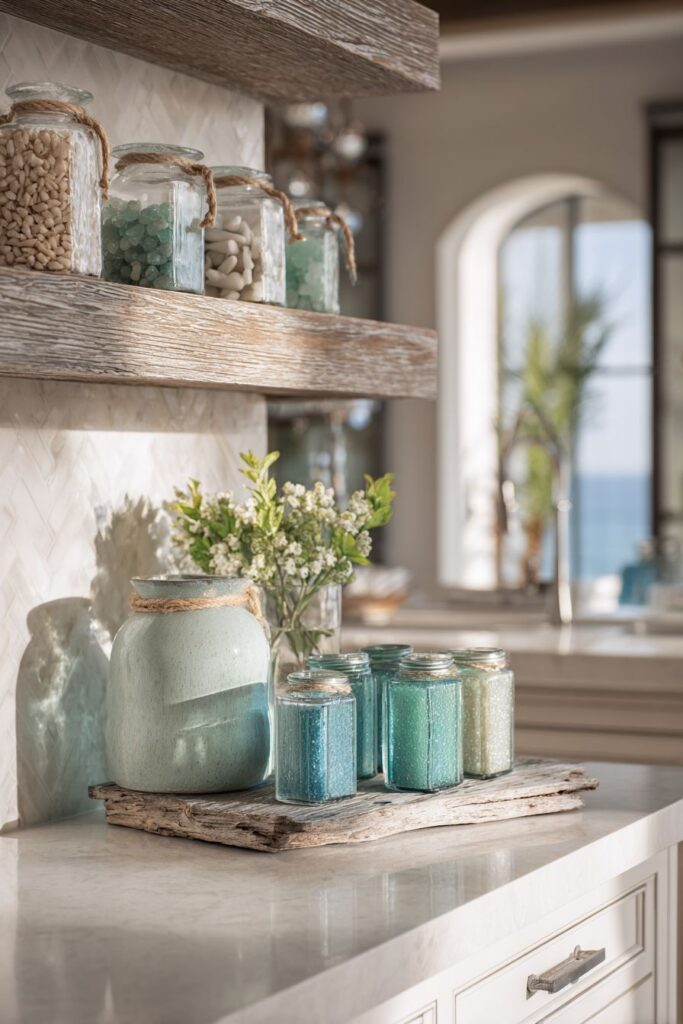
Key Design Tips:
- Source authentic driftwood pieces with interesting shapes and weathering patterns
- Seal wood surfaces to protect against kitchen moisture while preserving natural character
- Choose sea glass containers in colors that coordinate with coastal design themes
- Incorporate natural rope and other beach elements for authentic coastal atmosphere
- Plan installation methods that accommodate irregular driftwood shapes and sizes
19. Multi-Level Bamboo Organization
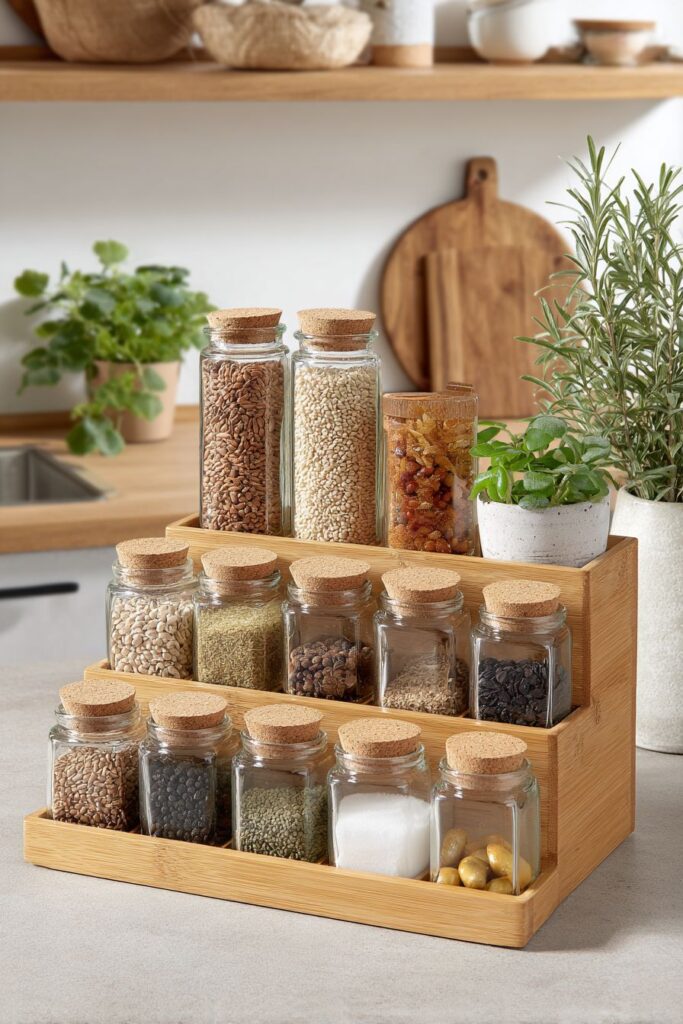
Sustainable materials meet practical organization through tiered wooden stands with graduated heights that optimize visibility of all containers. Natural bamboo construction with smooth finishes provides eco-friendly storage that aligns with environmental consciousness while delivering exceptional functionality. Uniform glass jars with cork stoppers complete the natural material palette while ensuring optimal spice preservation.
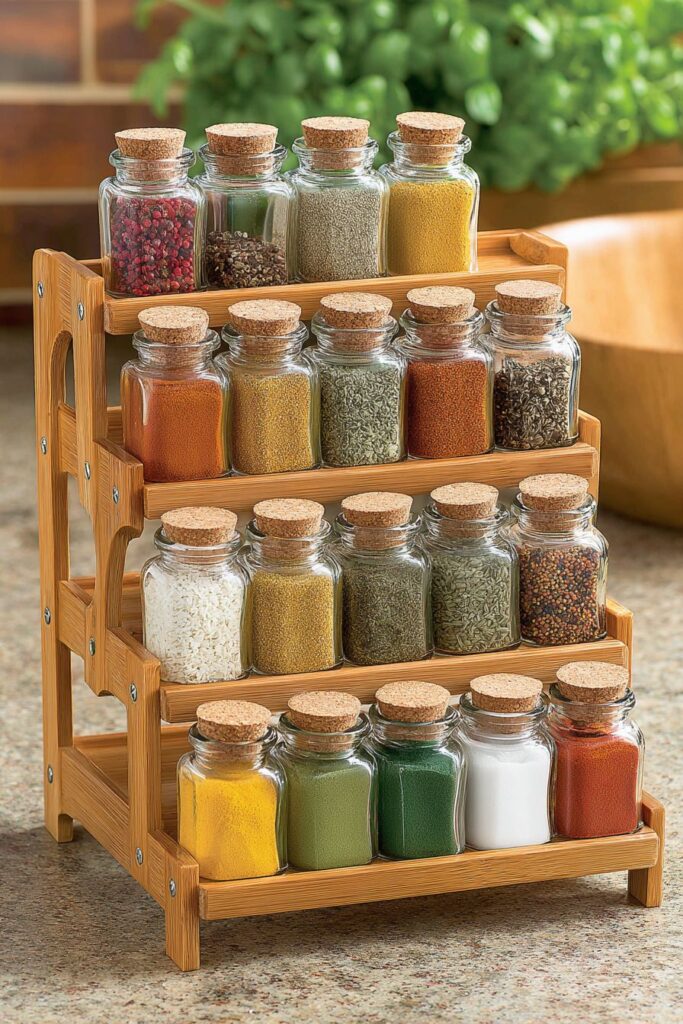
The tiered design ensures every spice remains visible and accessible regardless of collection size, eliminating the common problem of items getting lost behind others. Graduated heights create pleasing visual rhythm while maximizing storage efficiency within compact footprints. The portable design allows flexibility in kitchen organization while maintaining consistently organized aesthetics.
Bamboo’s rapid growth and sustainable harvesting make it an environmentally responsible choice that doesn’t compromise quality or appearance. The natural grain patterns and smooth finishes provide visual interest while resisting moisture and staining common in kitchen environments. The material develops beautiful patina over time while maintaining structural integrity.
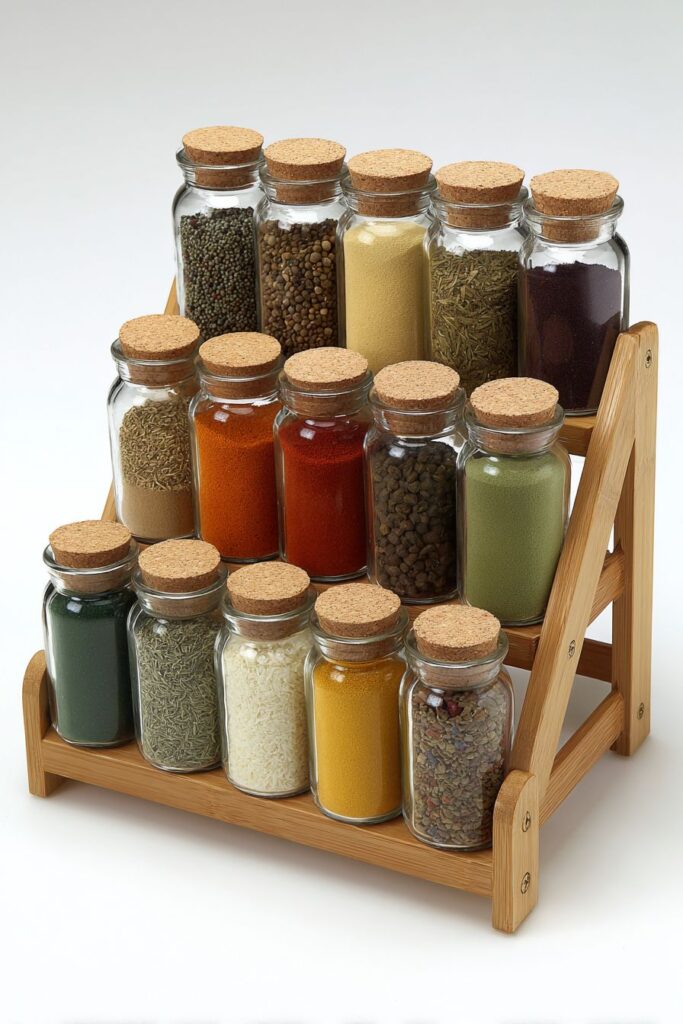
Cork stoppers provide excellent airtight seals while contributing to the natural material theme. The organic shapes and textures of cork add tactile interest while providing practical functionality that preserves spice quality. The combination of bamboo and cork creates cohesive natural aesthetics that work with various kitchen styles.
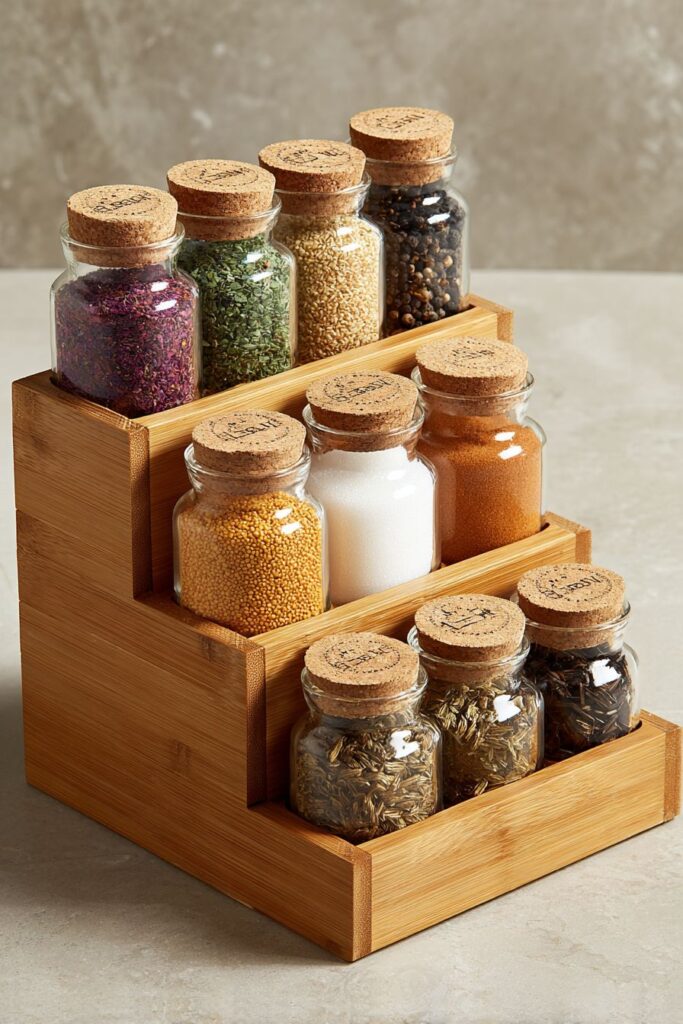
Key Design Tips:
- Choose high-quality bamboo with consistent grain patterns and smooth finishing
- Verify that container sizes match tier dimensions for optimal fit and appearance
- Apply food-safe finishes that protect wood while maintaining its natural appearance
- Consider weight distribution when planning tier heights and container placement
- Plan for easy cleaning access between tiers for maintenance convenience
20. Professional Restaurant-Inspired Systems
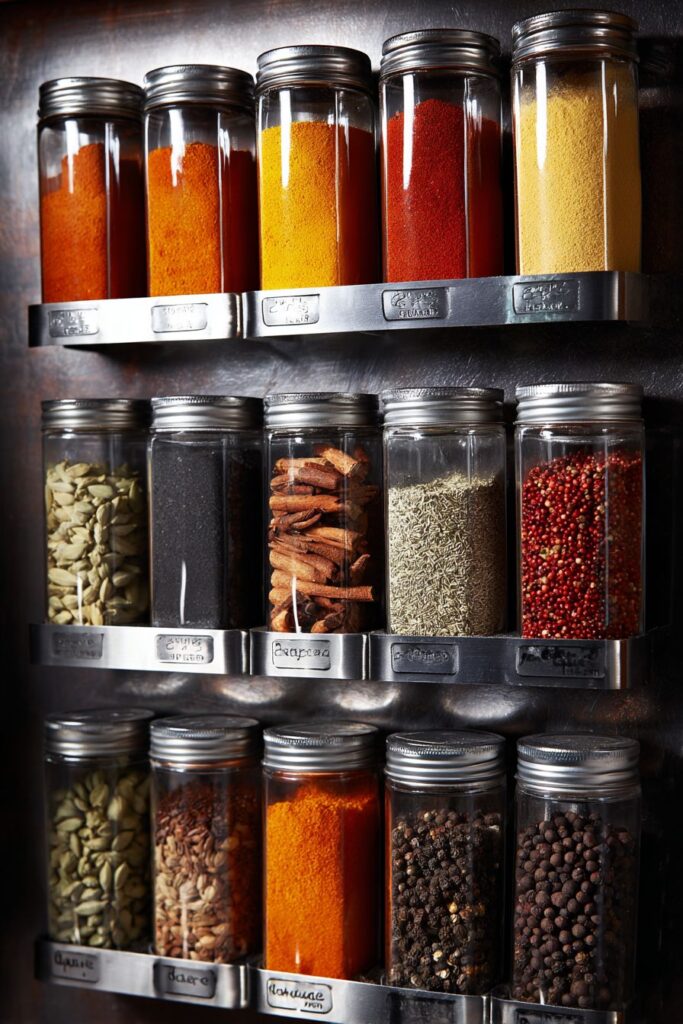
Commercial-grade functionality comes home through stainless steel construction with magnetic strips holding identical containers that facilitate efficient cooking workflows. Clear labeling systems and precise organization reflect professional kitchen requirements while bringing restaurant-quality storage to home environments. This approach prioritizes function over decoration while maintaining sophisticated industrial aesthetics.
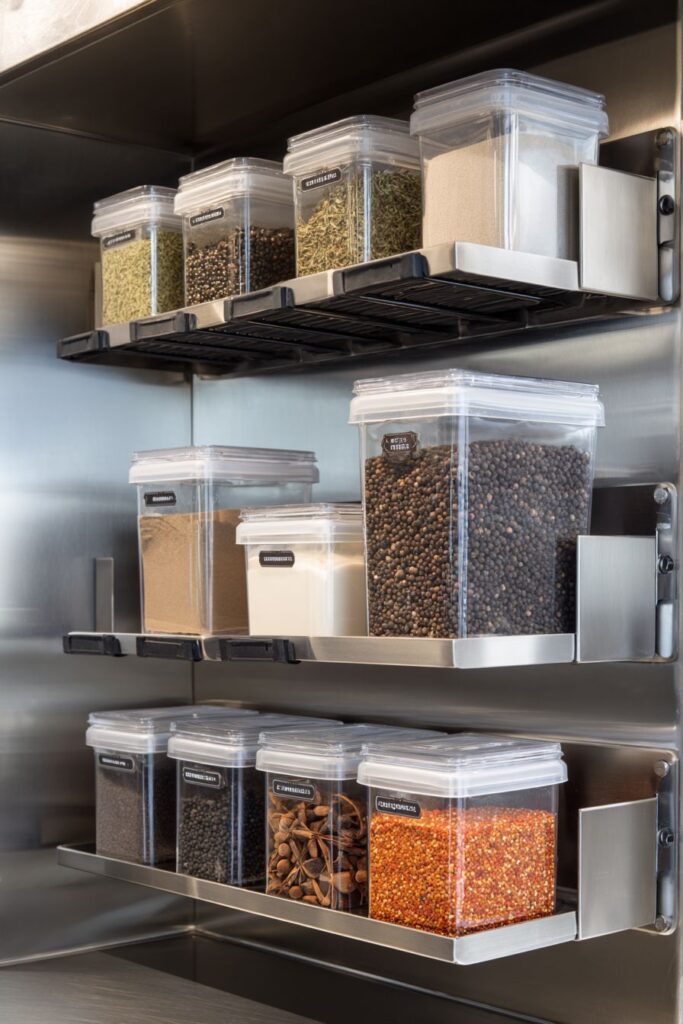
Stainless steel construction provides exceptional durability that withstands the rigors of daily cooking while maintaining appearance through years of use. The material choice offers practical advantages, including easy cleaning, resistance to corrosion, andthe ability to withstand high temperatures without degradation. Professional-grade materials justify higher initial costs through superior longevity and performance.
Magnetic strips provide secure storage while allowing instant rearrangement based on cooking needs or menu changes. This flexibility mirrors professional kitchen requirements where efficiency and adaptability take precedence over permanent organization schemes. Identical containers create visual consistency while streamlining inventory management and refilling processes.
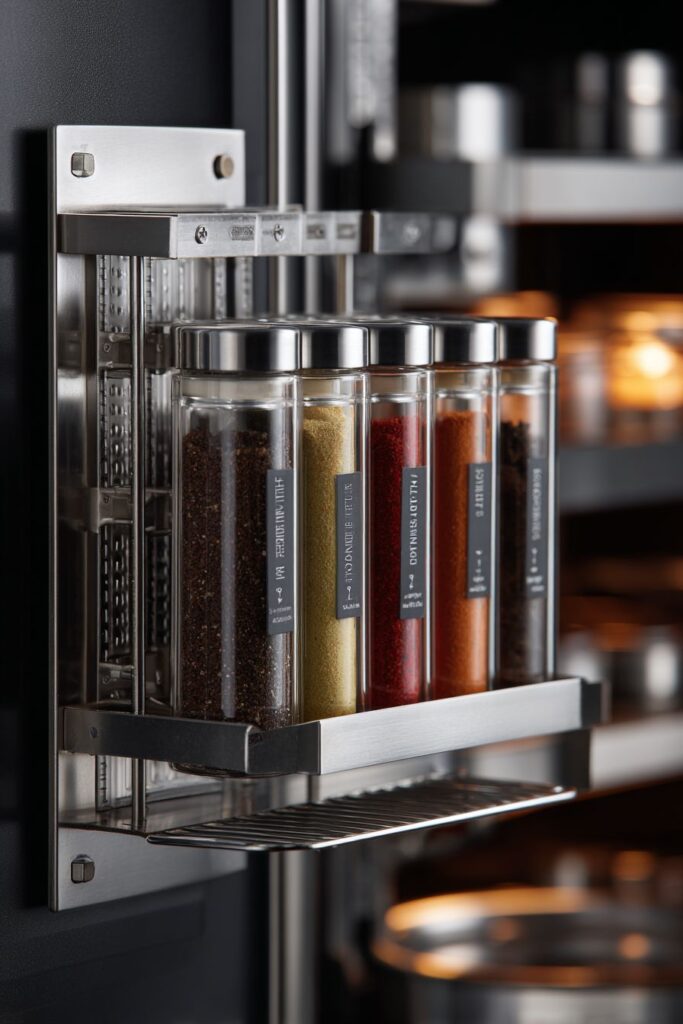
Commercial-grade finishes bring professional functionality to home kitchens without compromising residential aesthetics. The systematic organization facilitates efficient cooking workflows that reduce preparation time while maintaining professional standards for food safety and quality. This approach appeals to serious home cooks who appreciate restaurant-quality tools and organization.
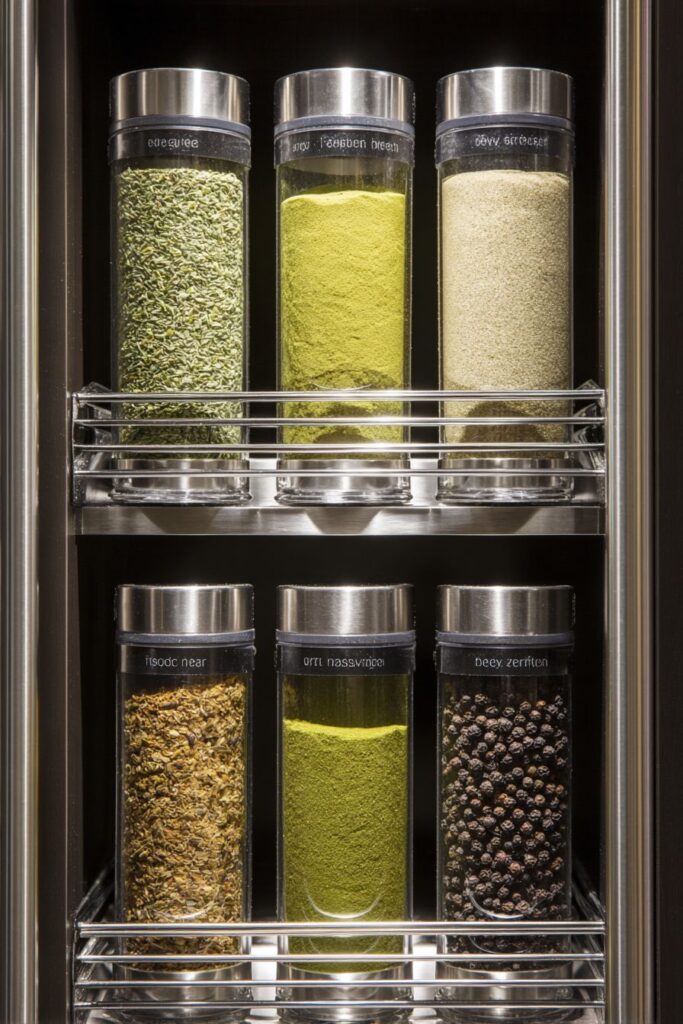
Key Design Tips:
- Invest in commercial-grade stainless steel designed for food service applications
- Choose magnetic systems with adequate holding power for filled containers
- Implement professional labeling standards for consistency and efficiency
- Plan installation at appropriate heights for comfortable access during cooking
- Consider expansion capabilities as cooking skills and ingredient collections grow
Conclusion
The journey through these twenty innovative spice rack solutions reveals how thoughtful organization can transform the most utilitarian aspects of kitchen storage into expressions of personal style and functional artistry. From sleek minimalist systems that celebrate clean lines and contemporary materials to rustic displays that honor traditional craftsmanship and natural beauty, the options available today cater to every aesthetic preference and practical requirement.
Each approach offers unique advantages that extend beyond simple storage functionality. Modern pull-out drawer systems provide seamless integration with contemporary cabinetry while maximizing accessibility and organization. Magnetic wall-mounted solutions transform vertical space into efficient storage while creating striking visual displays. Rustic floating shelves celebrate natural materials while adding warmth and character to kitchen environments. Professional-grade systems bring commercial functionality home while maintaining residential comfort and appeal.
The key to successful spice organization lies in understanding your cooking habits, space constraints, and aesthetic preferences, then selecting solutions that enhance rather than complicate your culinary routines. Whether you prefer the clean simplicity of Scandinavian design, the warm authenticity of farmhouse charm, or the sophisticated efficiency of professional systems, the right spice storage solution can dramatically improve both the functionality and visual appeal of your kitchen space.
Consider experimenting with these ideas in your own home, adapting elements that resonate with your style while addressing your specific storage needs. Remember that the best spice organization system is one that you’ll actually use consistently, so choose solutions that align with your cooking patterns and maintenance preferences. With thoughtful planning and quality materials, your spice storage can become a source of daily inspiration that celebrates both the practical necessity and artistic beauty of organized culinary spaces.
